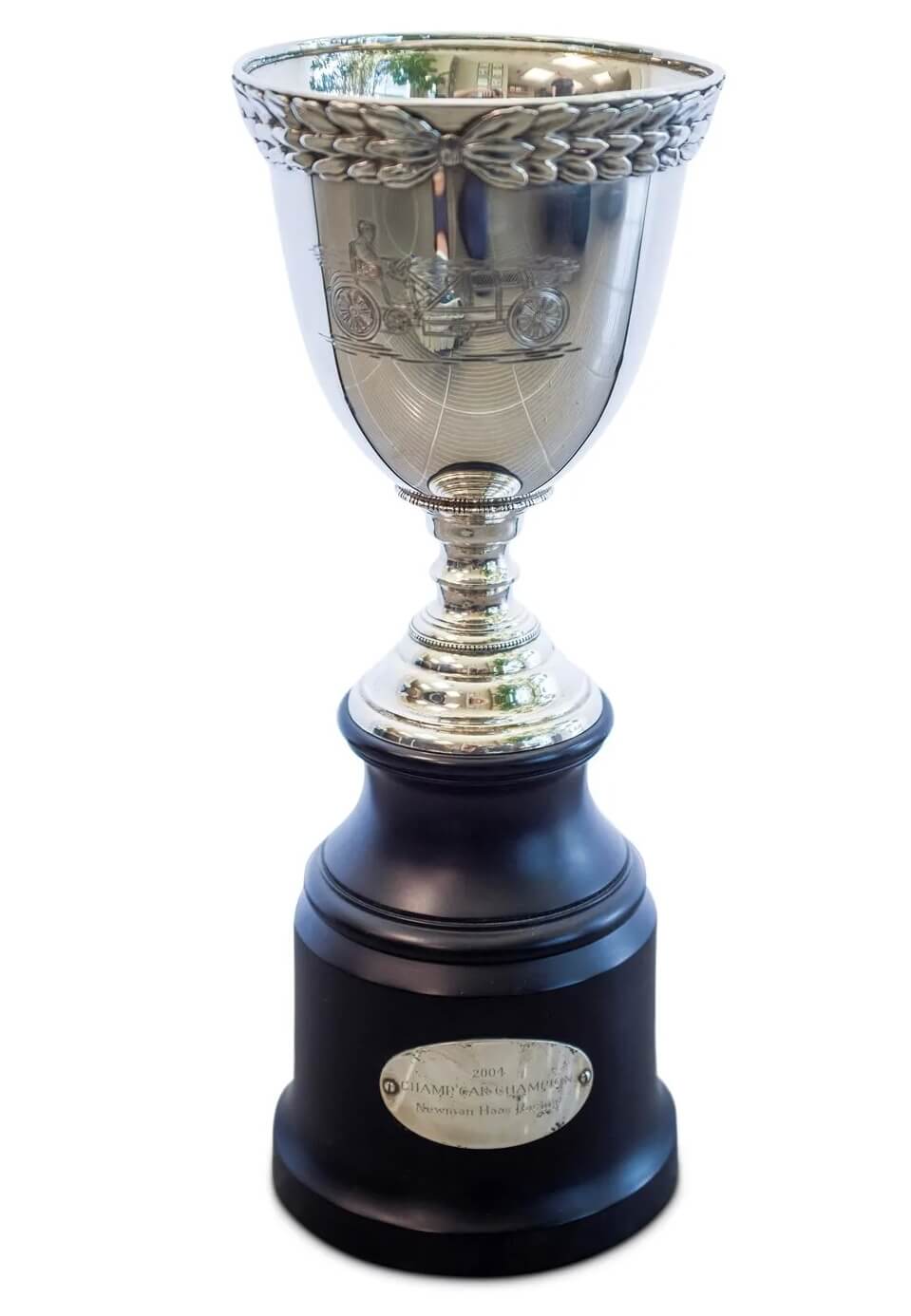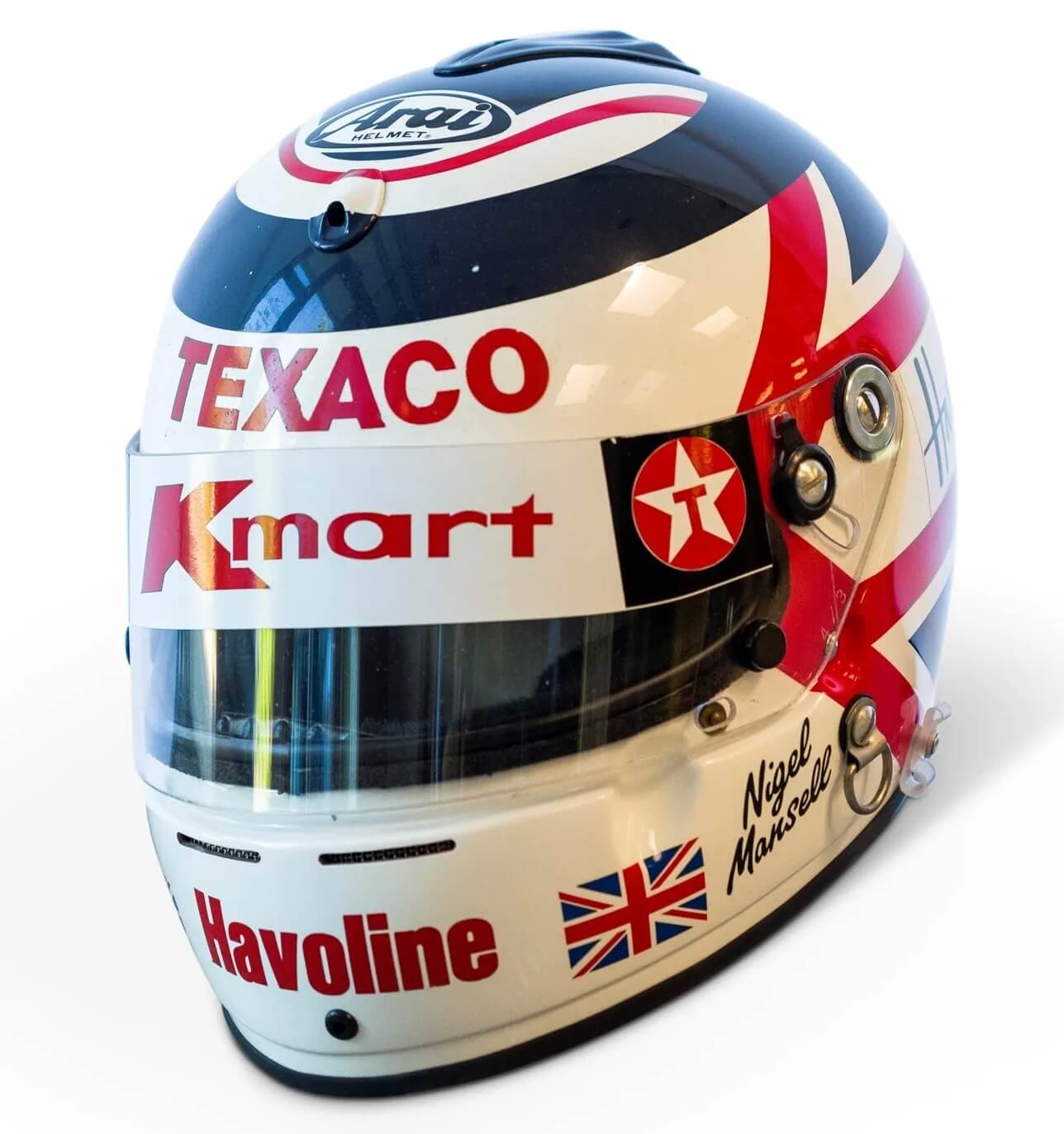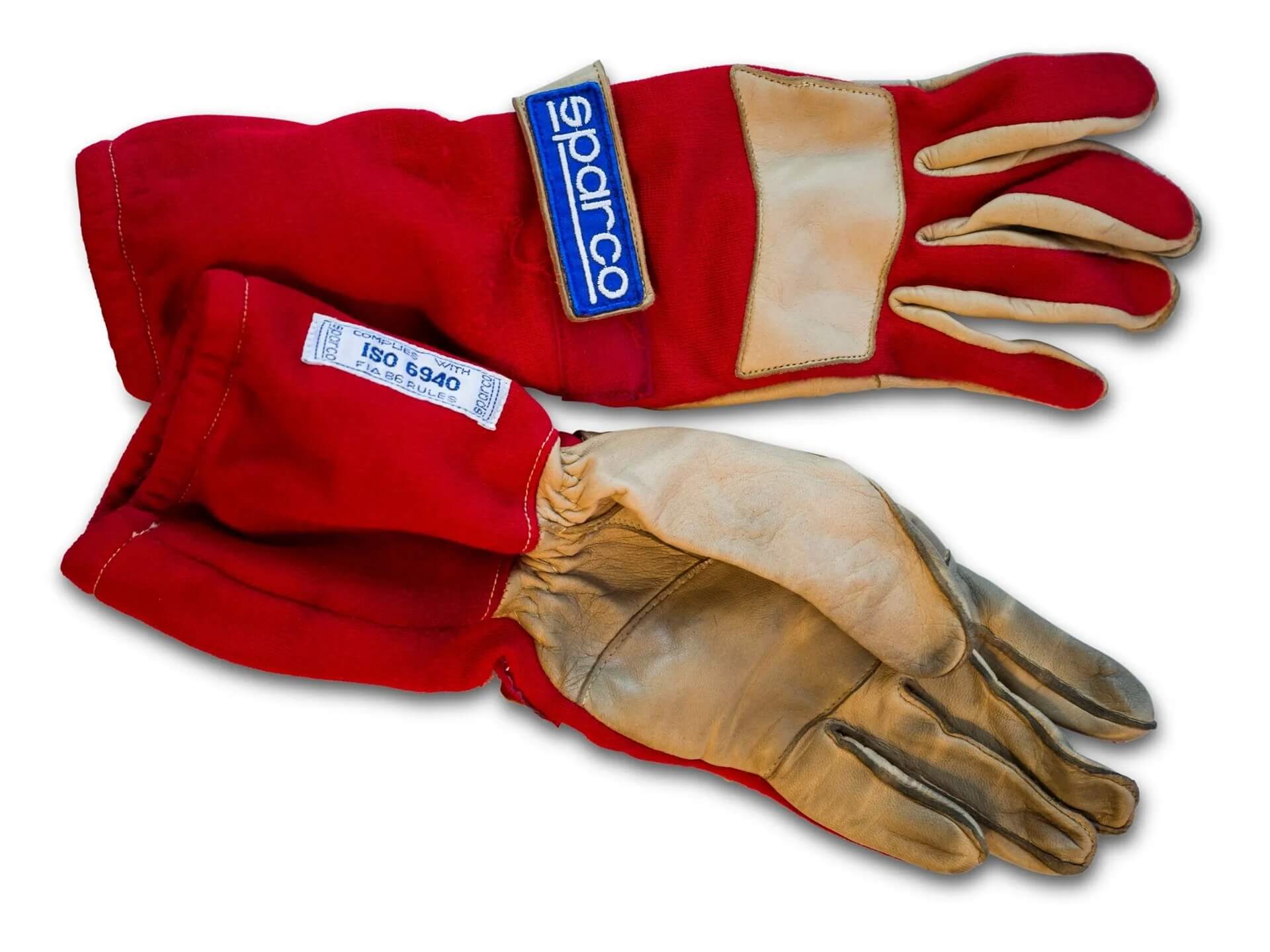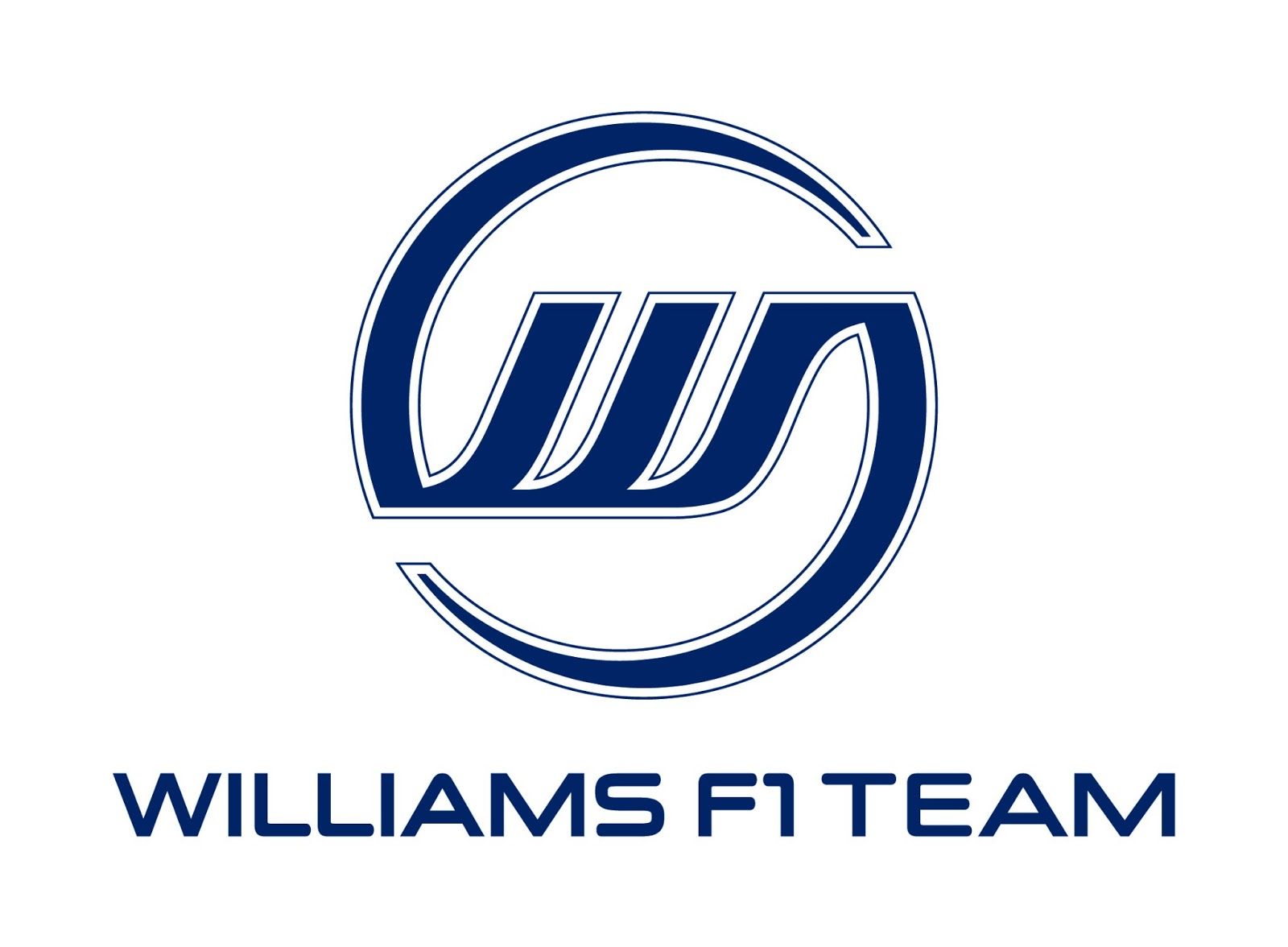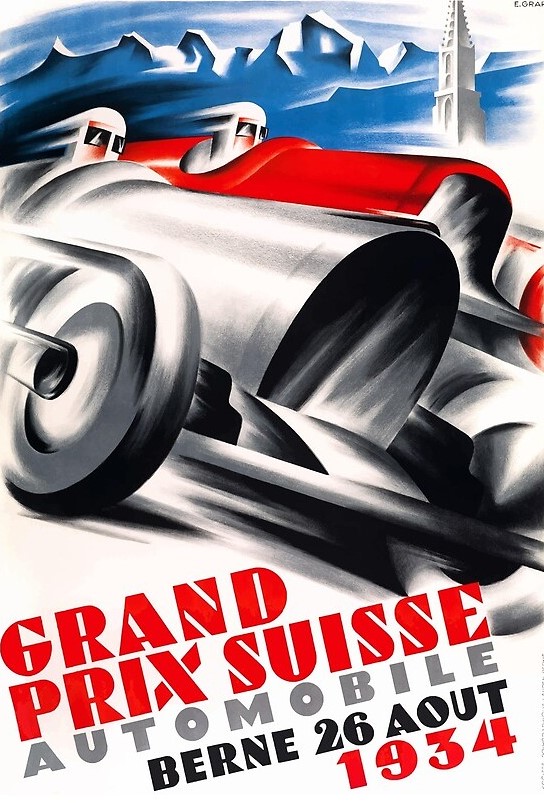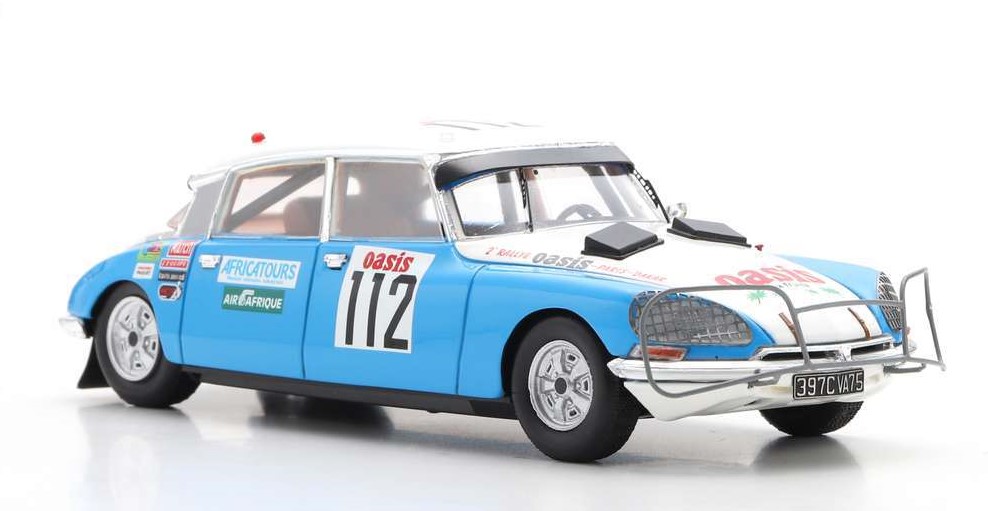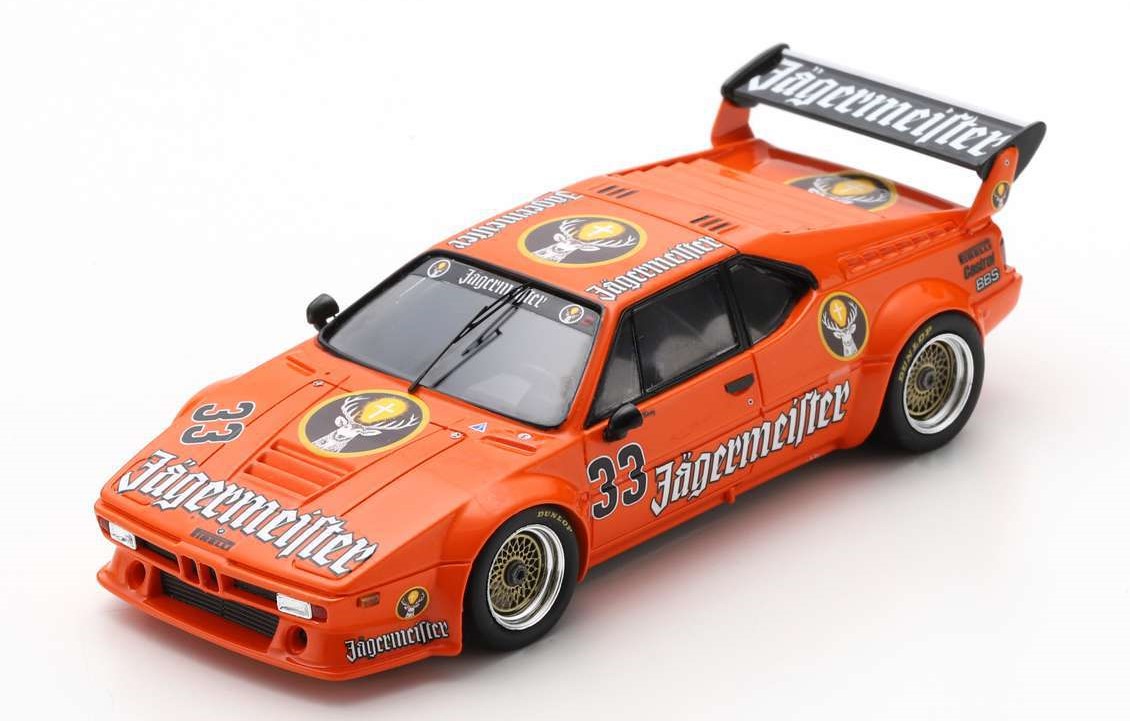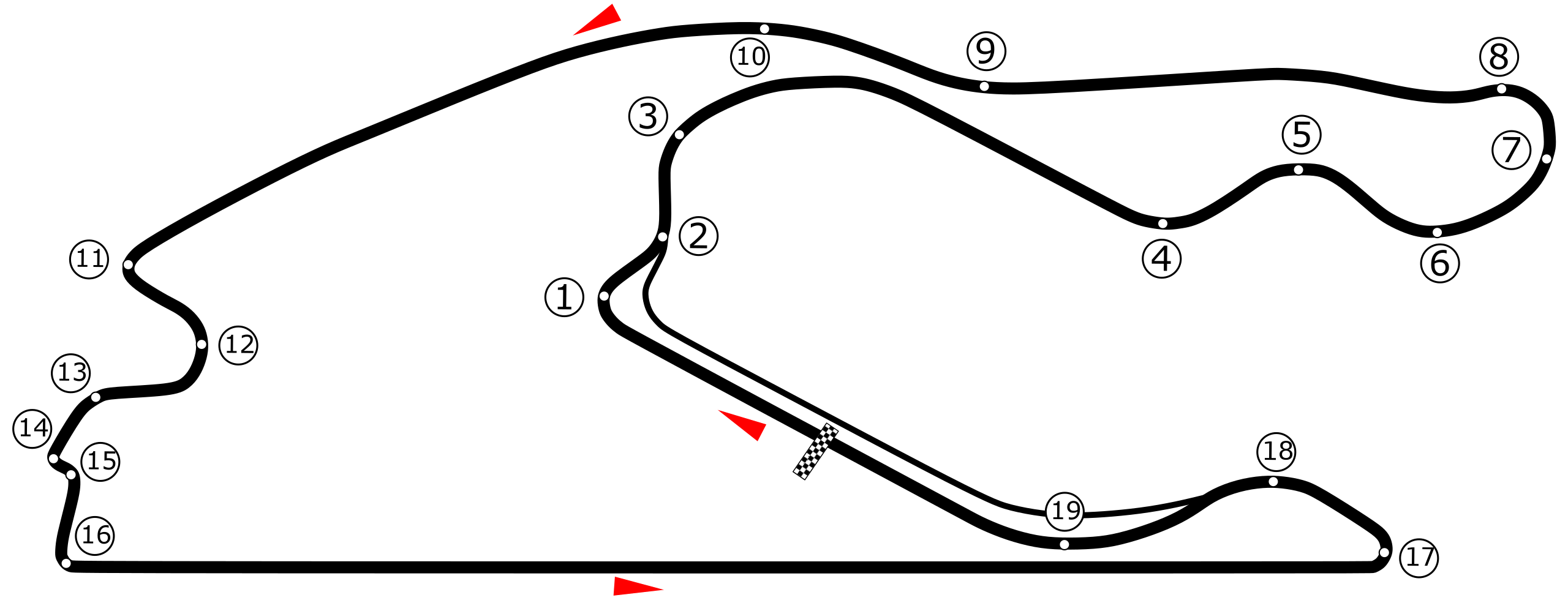www.F1scalemodels.com
... specialising in 1:43 scale model cars (Formula 1, Indy 500, Le Mans, GT and classic and modern road cars)
 Vale: Mauro Forghieri ( 13 Jan 1935 - 2 Nov 2022) Legendary Ferrari Engineer
Vale: Mauro Forghieri ( 13 Jan 1935 - 2 Nov 2022) Legendary Ferrari Engineer
Breaking News: Non-Attendance at Collectorcon
Sadly, I've decided not to attend the Collectorcon show on 27 November. My operation has been brought forward to 28 November leaving me little time to get everything sorted out and put away. Please accept my apologies for any inconvenience this has caused. I will be at the next Collectorcon on 12 March 2023.
New Additions: December 2022
Hi and welcome to the final update for the year. I ask this question every year around this time; where has the year gone? I still haven't come up with an answer. The Sydney Toy and Hobby Fair at Epping broke a record last month - it didn't rain! I'm just hoping the trend continues as the Fair slowly develops into a vibrant meeting place for collectors and traders. There is still room for more traders and also for the casual seller looking to downsize their collection; tables cost only $20 each. Of course, more collectors would be good as well. As I mentioned last month, I will not be attending the December and January Epping Fairs. A number of new additions this month as I received a big shipment of Spark models. One particular model stands out.
In 1966, Frank Costin (older brother of Mike Costin of Cosworth fame) met Ron Harris, a former Lotus Formula Junior and F2 racing manager who wanted to compete in the 1967 F2 championship with a self-built car. So began a partnership where Costin was to build a car with a plywood chassis but it had to be ready in 127 days for the first race of the championship. The body of the car, to be named "Protos" (Greek, meaning "The First") was to be made of 3.5 mm thick birch plywood, bonded to the chassis structure with high-strength glue and clamps. However, the aerodynamically shaped Protos with its enclosed bubble canopy was 30Kg over the weight limit and its high centre-of-gravity meant slow cornering speeds but on the straights the competition could not keep up. Its lap record at Hockenheim remained unbeaten for three years. Unfortunately, the season was disappointing. Costin wanted to further develop the car and eliminate its faults, but Harris lost interest in the project before the end of the season and dissolved the team. Spark has produced the cars of two of its drivers, Brian Hart (of Hart engine fame) and Eric Offenstadt.
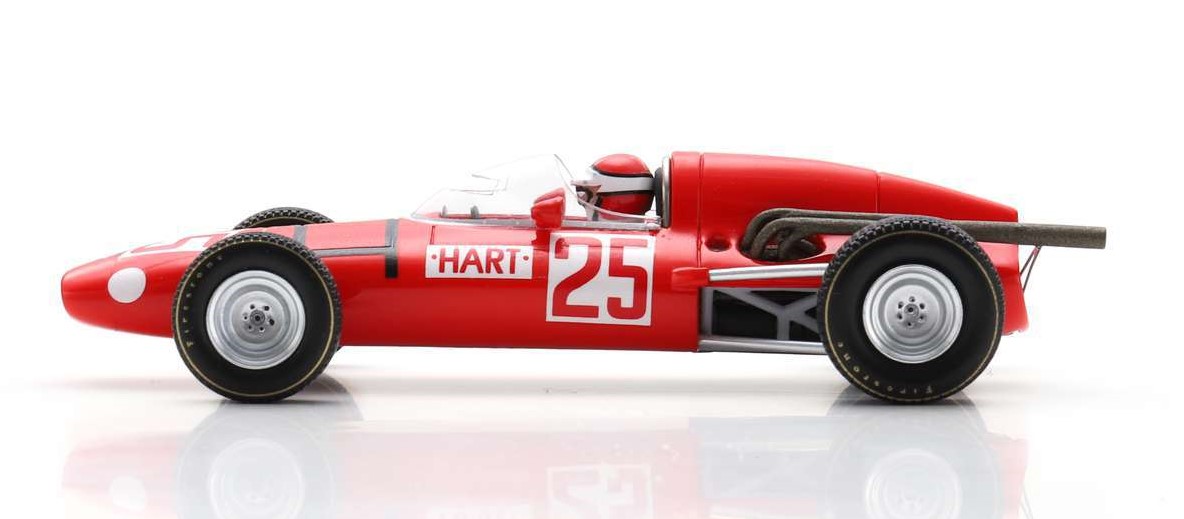 Spark: Protos Cosworth, B.Hart German F2 GP 1967
Spark: Protos Cosworth, B.Hart German F2 GP 1967
OK, that's it for another month and for another year. Just the one event in December, the regular monthly Sydney Toy Fair on 2 December at Epping (which I won't be attending). I hope everyone has a relaxing, joyful and safe time during the festive season. Until next year, happy collecting.
Formula One
- 2021 Alfa Romeo Ferrari C41, K.Raikkonen (7) Bahrain GP (Spark)
- 1979 Copersucar Ford F6, E.Fittipaldi (14) South African GP (Spark)
- 1976 Hesketh Ford 308D, A.Ribeiro (25) US GP (Spark)
- 1973 Iso-Marlboro Ford IR, H.Ganley (25) 6th Canadian GP (Spark)
- 1961 Lotus Climax 18, W.Mairesse (10) Belgian GP (Spark)
- 1972 Lotus Ford 72D, E.Fittipaldi (1) 7-piece diorama set (Spark)
- 1976 March Ford 761, A.Merzario (35) Spanish GP (Spark)
- 1976 March Ford 761, R.Petersen (10) British GP (Spark)
- 1977 March Ford 761, B.Lunger (30) Long Beach GP (Spark)
- 1970 Matra MS120, H.Pescarolo (7) US GP (Spark)
- 2021 McLaren Merc MCL35M, D.Ricciardo (3) 7th Bahrain GP (Spark)
- 2021 McLaren Merc MCL35M, L.Norris (4) 3rd Emilia Romagna GP (Spark)
- 2021 Mercedes AMG W12, L.Hamilton (44) 1st Bahrain GP (Spark)
- 1967 Protos Cosworth 16, B.Hart (25) 2nd German F2 GP (Spark)
- 1967 Protos Cosworth 16, E.Offenstadt (12) German F2 GP (Spark)
- 1956 Vanwall VW2, H.Schell (10) 4th Belgian GP (Spark)
- 1987 Williams Honda FW11B, N.Mansell (5) 1st French GP (Spark)
Le Mans / Sports cars
- 1954 Aston Martin DB3S, Bira/Collins (20) Le Mans (Spark)
- 1967 Ford GT40 Mk IV, D.Gurney/AJ.Foyt (1) Le Mans winner (Spark)
- 1969 Mirage Ford M1, Hailwood/Gethin (3) Kyalami 9 Hr (Spark)
- 1970 Porsche 917 LH, Larrousse/Kauhsen (3) Practice Le Mans (Spark)
- 1971 Porsche 908/03, Elford/larrousse (3) 1st Nurburgring 1000 km (Spark)
American Racing Series
- 1967 Ford GT40 Mk IV, McLaren/Andretti (1) 1st Sebring 12 Hour (Spark)
- 1994 Nissan 300ZX Turbo GTS, Pruett/Leitzinger/Gentilozzi/Millen (76) 1st Daytona (Spark)
Rally
- 1996 Mitsubishi Lancer Evo III, Vatanen/Gilbert (2) 1st HongKong Beijing Rally (Spark)
After Thoughts: "A 60-year retrospective - The 1962 F1 World Championship." In many respects 1962 was a year of change. It saw the end of Stirling Moss's career following a horrendous crash at Goodwood prior to the Grand Prix season. The injuries he sustained were so severe he was forced to retire from racing, earning himself the soubriquet "the best driver never to win a Championship". Having spent his entire F1 career racing with Cooper, Jack Brabham left the team that gave him two world titles to form the Brabham Racing Organisation . The new team started late designing their first F1 car, the BT3 and were forced to purchase a Lotus 21 and 24 as a stop-gap measure for '62. While at Ferrari, the reigning champions, there was turmoil as the team was rocked by the resignations of six prominent employees, among them included Chief Engineer, Carlo Chiti and Team Manager Romolo Tavoni. A young Mauro Forghieri was promoted to run the engineering department. Ferrari's title defence began shambolically; the team missing the French GP and had just a single car for the British GP. They did not even send cars to the US and South African GP's citing union strike action as the reason but more likely tired of being beaten by the British V8s.
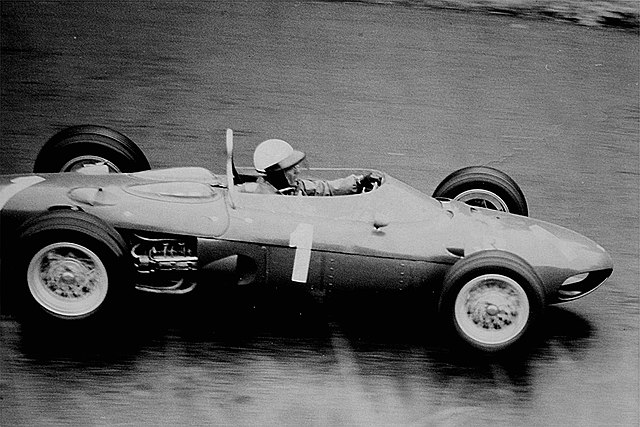 Ferrari 156 P.Hill '62 German GP (Photo: L.Spurzem)
Ferrari 156 P.Hill '62 German GP (Photo: L.Spurzem)
The future of BRM lay in the balance at the start of '62. The owner of the team, Sir Alfred Owen demanded sucess if it was going to remain in F1. Graham Hill was retained for a third season while Tony Brooks had retired and was replaced by Richie Ginther. The BRM drivers were to use the fuel-injected V8-powered BRM P57. At Lotus, Colin Chapman presented two different Climax V8 powered cars for the season, the Lotus 24 and 25; the latter revolutionised the sport. The Lotus 25 was built in secrecy and astonished the F1 fraternity when it was unveiled. Its full length monocoque chassis was unique and innovative, giving improved rigidity and reduced weight. Chapman did not offer the 25 for sale for two seasons and this did not go down well with his customer teams, especially when the car proved to be the fastest in 1962. With Jack Brabham moving on, Bruce McLaren assumed the role of team leader at Cooper with Tony Maggs as number two. Their new car was the Climax powered T60. Reg Parnell's racing team decided not to run customer cars for 1962, instead commissioning Eric Broadly's Lola concern to build its first F1 car, the Mk4 on an exclusive basis. The Lolas were to be driven by John Surtees and Roy Salvadori and the Mk4 showed early promise by taking pole position at the first race at Zandvoort. The other major contender for 1962 was Porsche who introduced their new 804 chassis powered by their flat-eight, air cooled engine. The Porsche engine produced 180bhp which was a step forward but still not a match for the fastest V8s. Dan Gurney was again their number one driver. And so the '62 season was set ...
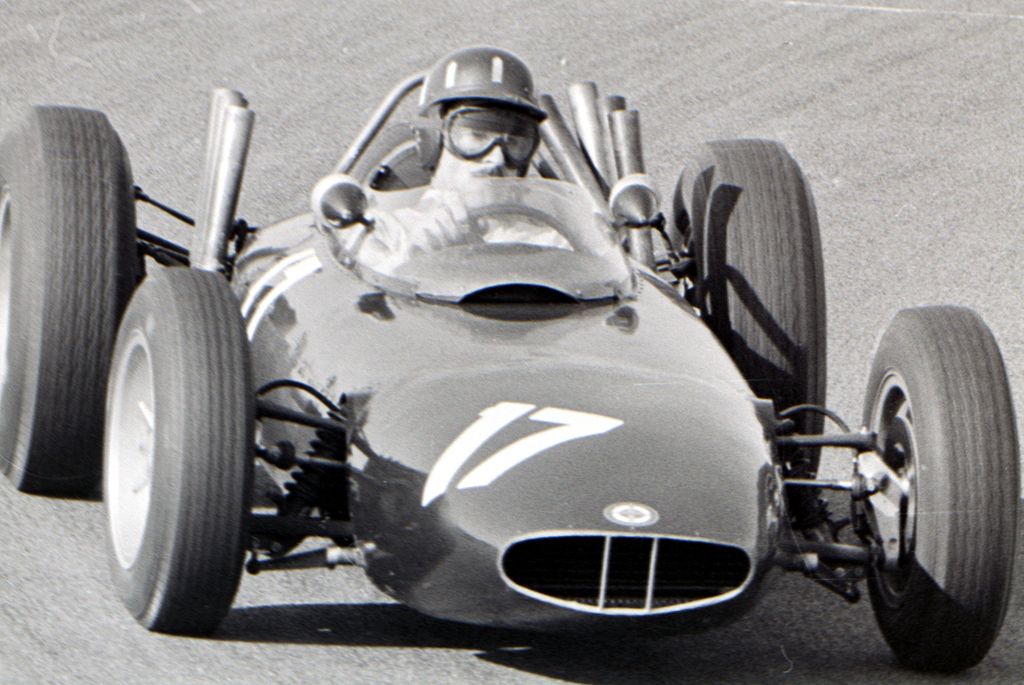 BRM P57 1962 G.Hill Dutch GP (Photo: L.de Voogd)
BRM P57 1962 G.Hill Dutch GP (Photo: L.de Voogd)
Graham Hill had endured frustration since 1958, first with unreliable cars at Lotus, then more of the same at BRM. To date he had only finished in 3rd place once. But that was all about to change. The BRM team went to Zandvoort in a bouyant mood, having won two pre-season non-championship races. Hill took the lead early in the race and held on to the end, giving him his first and BRM's second Championship win. Hill was dominant in Monaco as well before engine problems cruelled his race giving the win to the Cooper of McLaren. Hill's main rival for the remainder of the season would be Jim Clark driving the now reliable and potent Lotus 25. It was Clark who took victory at Spa; his first GP win and later went on to win the British and US Grand Prix. Whenever Clark ran into problems, Hill in his BRM was there to take the wins so the title was to be decided at the last race in South Africa. The odds were against Clark who had to win and Hill to fail to score at all. Engine failure ended Clark's race and Graham Hill took the victory and his first Championship title.
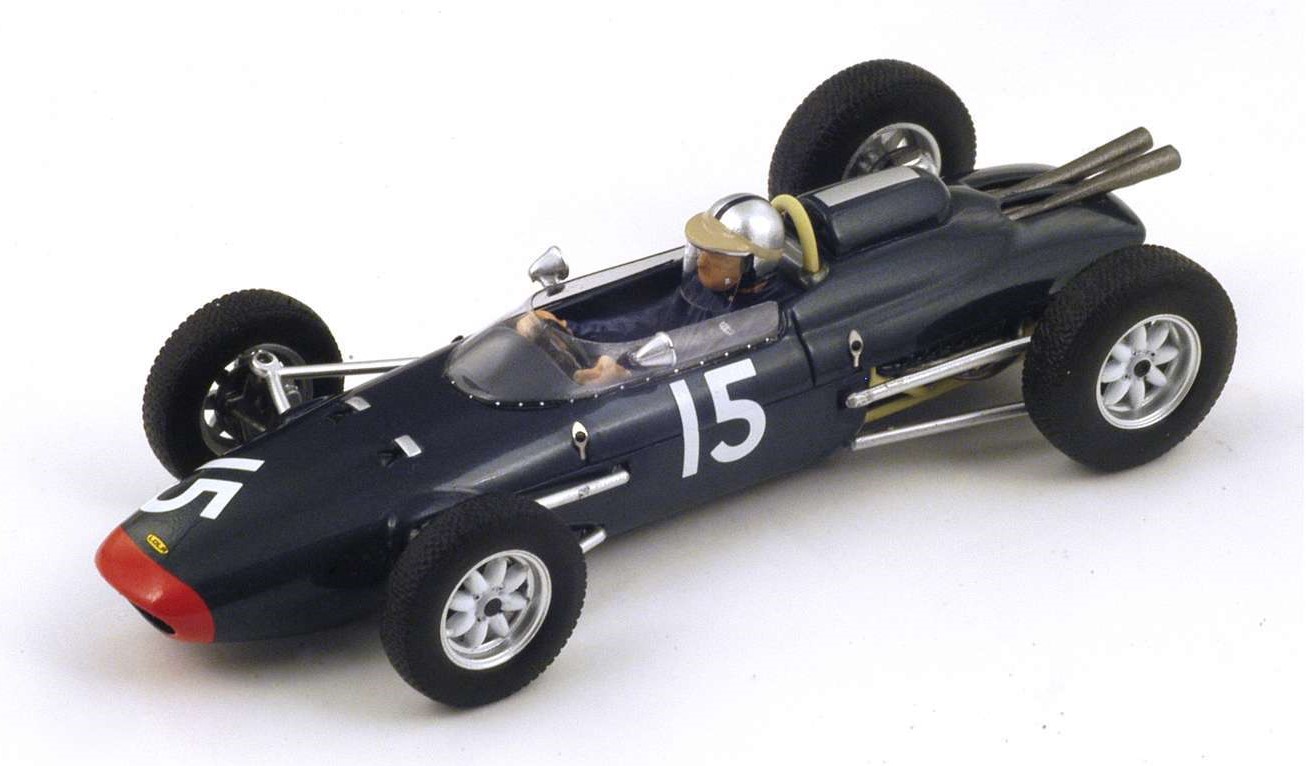 Spark: Lola Climax Mk4 R.Salvadori '62 German GP
Spark: Lola Climax Mk4 R.Salvadori '62 German GP
The only other driver to stand on top of the podium was Dan Gurney who scored his and Porsche's first win at the French GP. It wasn't until the sixth race of the season that Jack Brabham unveiled his new turquoise and gold liveried BT3 Climax car; he finished in 4th in the last two races of the season to score points in his own car. At the end of the season, fed up with the turmoil at Ferrari, Phil Hill left to join ATS, the team formed by the engineers who had famously quit Ferrari in 1961.
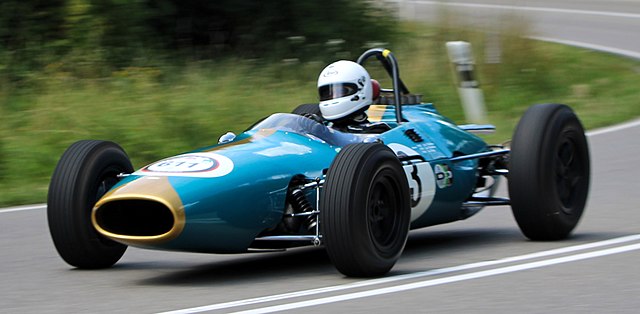 Brabham BT3 at 2019 Solitude Revival (Photo: A.Migl)
Brabham BT3 at 2019 Solitude Revival (Photo: A.Migl)
New Additions: November 2022
Hi and welcome to another monthly update. We don't have much luck when it comes to the weather in Sydney; it seems there are more rainy days than sunny days and every monthly Sydney Model Fair has been wet. (In fact, Sydney has had more than 170 days of rain this year which is about 55% wet days). Can we break this hoodoo for the November Fair? Thankfully, our hobby is one enjoyed indoors.
Firstly, I'd like to share some news with you all. I will not be able to attend the December and January Model Fairs at Epping as I will be recuperating from some minor surgery. I should be back in action for February. It may also mean I won't be able to fulfil any mail orders during these two months; it depends how easy it is to locate the model(s) as I'm not allowed to lift any heavy storage boxes. However, if you let me know what you want, I'll definitely reserve the model(s) for you until I can action your order. Thank you for your understanding and patience as I really appreciate your business. Now, what's new for this month? Not much really, mainly road cars and quite a few of these are restocked models. There is one of particular interest as I was able to view a reproduction of this vehicle at a motoring museum in Turin, Italy a few years ago.
The Cugnot Wagon was designed by Nicolas Joseph Cugnot, a French military engineer and was tested on 23/10/1769, this is considered to be the first steam car in the world. It was called FARDIER, weight carrier or burden carrier; it reached the speed of 3.5 - 4 km/h and was designed to transport the Gribeauval cannon. The endurance was hampered by its small boiler which only allowed 15 minutes of operation before the fire needed to be relit, and its steam raised again. There are reports of a minor incident in 1771, when the second prototype vehicle was said to have accidentally knocked down a brick or stone wall, in perhaps the first known automobile accident. The incident was unrecorded at the time, first appearing in print in 1804, thirty-three years after the alleged accident. Nevertheless, the story persists that Cugnot was arrested and convicted of dangerous driving, another first for him if true. The original is exhibited at the Musée des Arts et Métiers in Paris, a functional replica exists at Void-Vacon in Cugnot's hometown, one at the Tampa Bay Automobile Museum in Florida in the United States and a 7/10th scale replica at the Museo dell'Automobile of Turin. Brumm has released a limited edition of 200 models to celebrate the 250th anniversary of this significant vehicle.
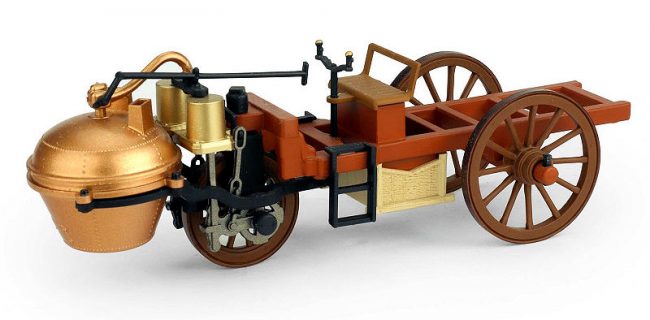 Brumm: Cugnot steam wagon 1969
Brumm: Cugnot steam wagon 1969
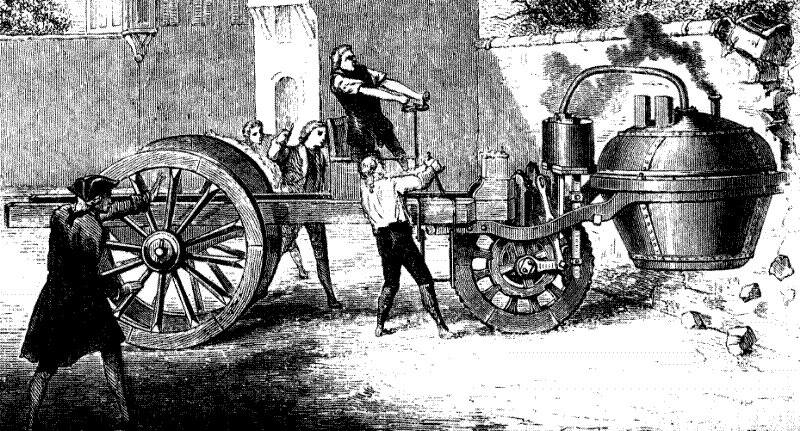 First known automobile accident?
First known automobile accident?
That about wraps it up for another month. The Sydney Toy and Hobby Fair will be held on the first Friday of the month (4 November) at the Epping Creative Centre, Epping. Then on 27 November, the big Collectorcon will be held at the Penrith Valley Regional Sports Centre, 30 Herbert Street, Cambridge Park. As the Collectorcon event will be my last until February 2023, this will also be the last opportunity this year to pick up any models that I'm holding for you. If you are interested in any models, let me know so I can bring them to one of these two shows that I will be attending. I will still be updating my website monthly as usual. Until next month, happy collecting.
Formula One
- 1982 Ferrari 126C2, G.Villeneuve (27) Brazil GP w/driver (Brumm)
- 1965 Lotus Climax 32B, J.Clark (1) 1st Levin GP Tasman Series (Spark)
Australian Race Series
- 1984 Falcon XE, D.Johnson/J.French Bathurst DNF "Palmer Tube" (Biante)
Le Mans / Sports Cars
- 1957 Maserati 200si Spider, S.Scarlatti (335) Giro di Sicilia (Leo Models)
- 2021 Toyota GR010 Hypercar, Conway/Kobayashi/Lopez (7) 1st Le Mans (Spark)
Rally
- 1992 Ford Sierra 4x4, Delecour/Grataloup (7) 4th Monte Carlo Rally (Starter - built kit)
- 1994 Subaru Impreza 555, Sainz/Moya (2) 3rd Monte Carlo Rally (Renaissance - built kit)
Road Cars
- 1976 Chevrolet Chevette SL in beige (Edicola)
- 1988 Chevrolet 500 SL/E Pick Up in white (Edicola)
- 1769 Cugnot Carro A Vapor, steam wagon 250 year anniversary (Brumm)
- 1931 Ford Model A, US Mail Van in brown (MotorHead)
- 1931 Ford Model A, Sutton Florist Van in black (MotorHead)
- 1940 Ford Panel Van, Russ Dawson Genuine Ford Parts in grey (MotorHead)
- 1940 Ford Panel Van, Bedick's Dairy in dark blue (MotorHead)
- 1955 Ford Thunderbird Coupe in yellow (MotorHead)
- 1955 Ford Thunderbird Coupe in red (MotorHead)
- 1955 Ford Thunderbird Coupe in blue (MotorHead)
- 1970 Ford Taunus Turnier Wagon in metallic blue (Maxichamps)
- 1954 Jaguar XK140 Cabrio in bordeaux (Edicola)
- 1962 Peugeot 404 Coupe in blue (Maxichamps)
After Thoughts: "55 Years of Renault in F1." Brothers Louis and Marcel Renault established their car manufacturing business way back in 1899 and immediately began a competitions program. The brothers themselves raced their cars, winning several city to city races but Marcel lost his life in the Paris-Madrid event in 1903. However, the surviving brother Louis was convinced racing was good for his order books and a team of three 13-litre, 96 hp cars started the 1906 ACF Grand Prix at Le Mans. Two failed to finish, but the third won the race(1).
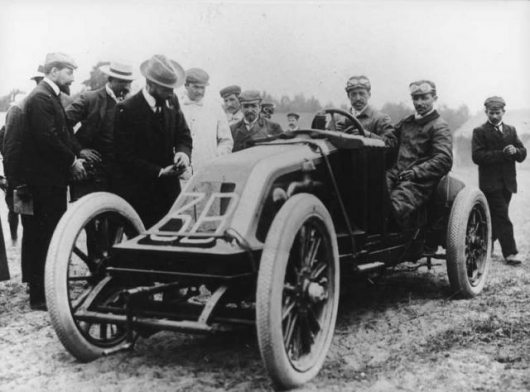 One of 3 Renaults at the 1906 ACF GP at Le Mans
One of 3 Renaults at the 1906 ACF GP at Le Mans
1977 - 1985
Many years later, at the British Grand Prix on 14 July (Bastille Day) in 1977 Renault Sport boldly introduced their V6 turbocharged car which at the time was unique in Formula One. Since 1966, the engine regulations allowed for 3-litre atmospheric and 1.5-litre turbocharged engines. Renault chose the turbo path because it didn't have a 3-litre engine available but did have a successful 2-litre turbo engine that had won the European Formula Two championships in 1976 and 1977. Thus the Renault-Gordini 1.5-litre V6, 510 hp single turbo EF1 engine made it's debut mounted in a single RS01 chassis for works driver Jean-Pierre Jabouille. The RS01 was cumbersome and heavy as it was no more than an experimental test car and Jabouille worked hard to develop the car under race conditions. There was the major issue of poor drivability, namely turbo-lag where the power came on after a short delay upon pressing the throttle pedal. Once boost pressure had been reached, the EF1 engine had more power than the Cosworths but this meant higher temperatures, higher loads and pressure in the engine leading to poor reliability. It was Ken Tyrrell who gave the RS01 the nickname "the yellow teapot" as it tended to blow up fairly regularly, usually in a cloud of white smoke. It was not an auspicious start; Renault did five races in 1977 and Jabouille failed to finish in any.
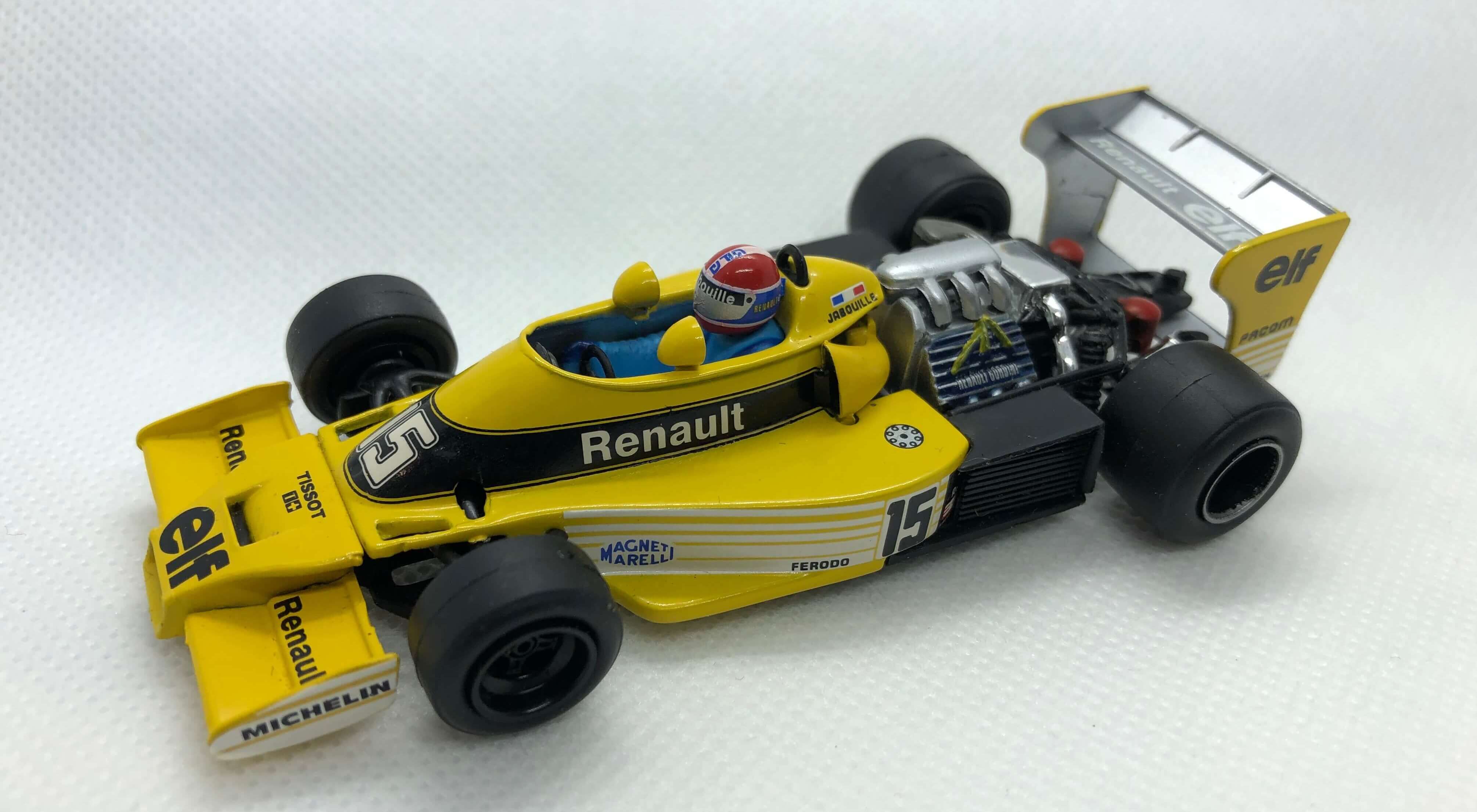 Quartzo: Renault RS01 Jabouille 1977
Quartzo: Renault RS01 Jabouille 1977
Steady improvements were made during the 1978 season (4th place and first points at the US GP) and for 1979, the team expanded to two drivers with René Arnoux joining Jabouille. The power of the turbo engine was becoming evident with the Renault taking pole on six occasions and the fastest lap twice in 1979. The drivability issue was somewhat solved by using a twin turbo and 1979 was to be a breakout year with Jabouille winning the French GP. For Jabouille it was a victory on home soil (Dijon), whilst driving a French car on French tyres (Michelin), powered by a French engine burning French fuel (Elf). For the 1980, 81 and 82 seasons, Renault was regularly competing for race wins with Alain Prost replacing the retiring Jabouille in 1981. Ferrari was the next team to defer to turbo power and introduced their own engine for 1981. By 1982, Toleman (Hart engine) and Brabham (BMW) had joined the turbo brigade, with Alfa Romeo joining in 1983. In 1983, Renault and Prost came very close to winning the World Championship eventually losing out to Nelson Piquet by 2 points.
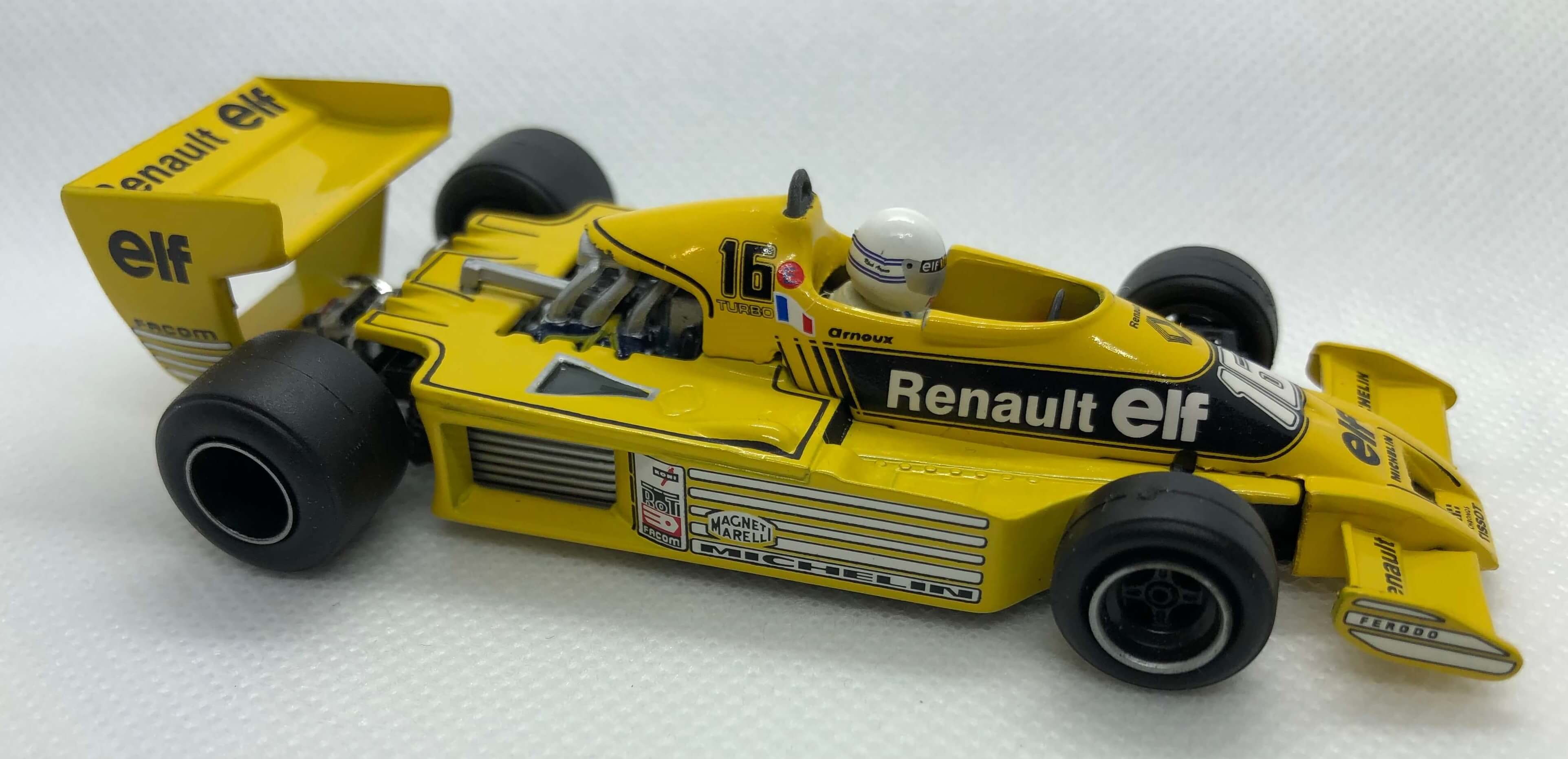 Quartzo: Renault RS01/3 Arnoux 1979
Quartzo: Renault RS01/3 Arnoux 1979
Prost was fired from Renault after the 1983 season following his public comments about the team's lack of development which resulted in his loss to Piquet. The fortunes of the team declined in 1984 and 1985 with other teams doing a better job with their turbo engines. Major financial problems emerged at Renault in 1985 and they could no longer fund their racing program. Renault withdrew from F1 at the end of the season, by that time all teams were using turbo charged engines.
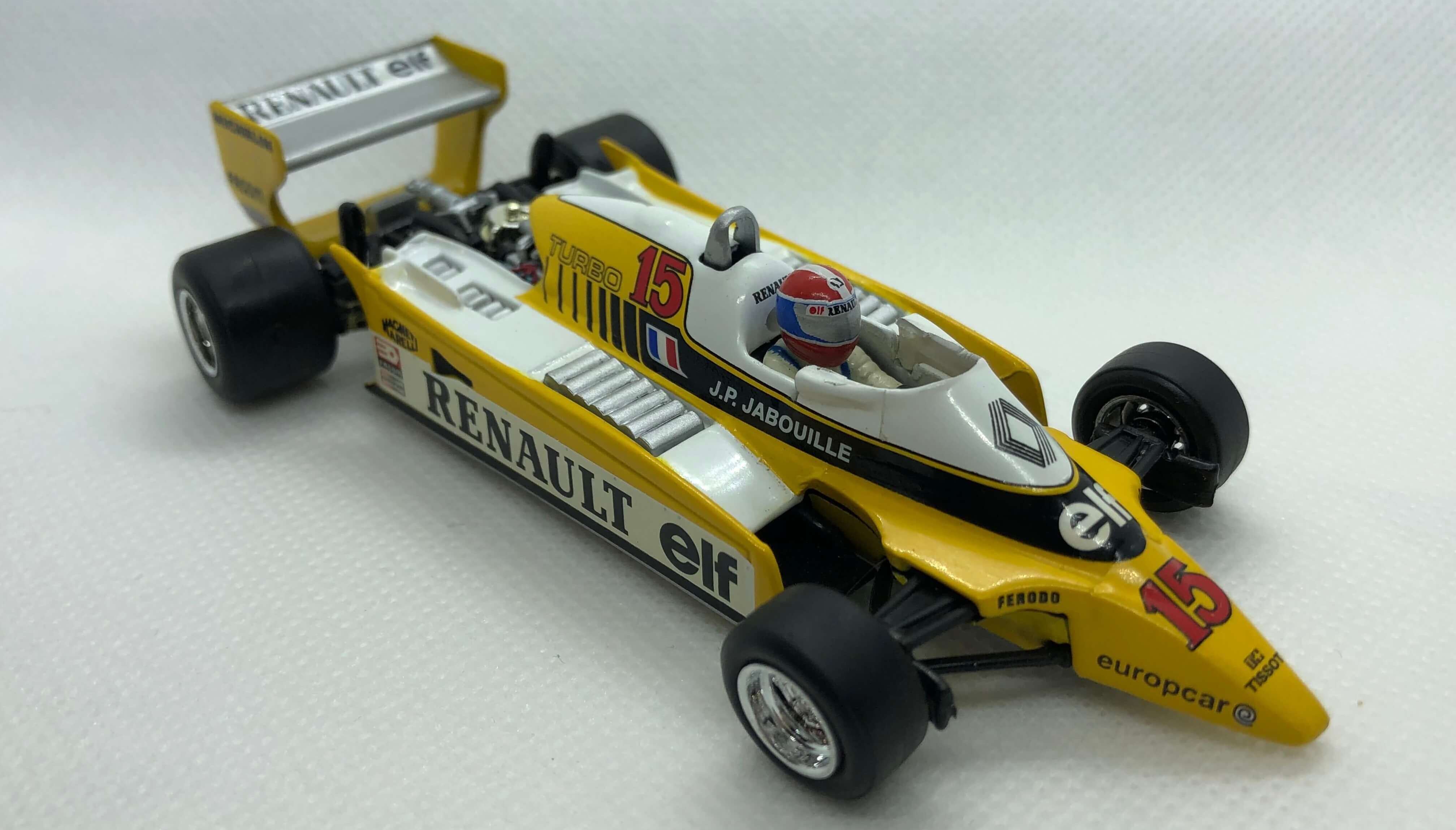 Quartzo: Renault RE20 Jabouille 1980
Quartzo: Renault RE20 Jabouille 1980
2002 - 2010
Early in 2000, Renault purchased the Benetton team for $120 million to return to F1. The team continued to race using the Benetton name for the 2000 and 2001 season before finally changing to Renault in 2002. For the 2003 season, Fernando Alonso joined the team and won the Hungarian GP, Renault's first win since the 1983 Austrian GP. With seven race wins in 2005, Alonso won the World Drivers Championship and Renault, the Constructors title. Renault were able to maintain the momentum for 2006, Alonso again winning seven GP to win back-to-back titles, with the team winning the Constructors trophy as well. Surprisingly, Alonso left Renault for McLaren in 2007 but his fractious relationship with team mate Lewis Hamilton saw Alonso return to Renault in 2008, now with ING sponsorship. At the 2008 Singapore GP, the Renault team ordered Nelson Piquet Jr. to crash deliberately to trigger the deployment of the safety car in what became known as "crashgate"; allowing Alonso to win the race. Subsequent investigations saw Renault guilty of race fixing. In 2010, Renault sold a majority stake in the team to investment company, Genii Capital with Renault retaining a 25% share.
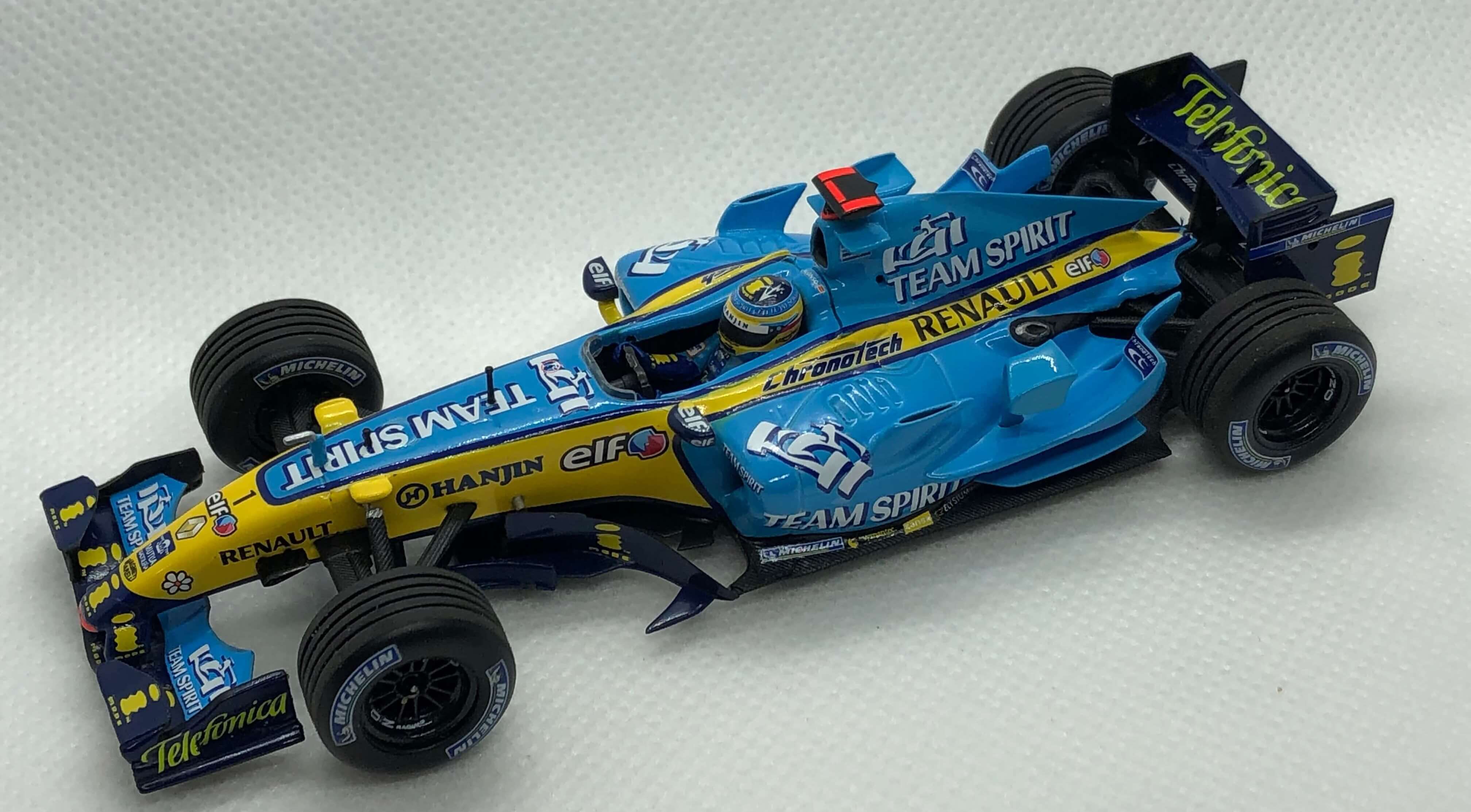 Minichamps: Renault R26 Alonso 2006
Minichamps: Renault R26 Alonso 2006
2011
Renault scaled back its involvement in 2011, eventually selling its 25% stake to Lotus Cars while still remaining as the team's engine supplier. The team was renamed Lotus Renault GP for 2011.
2016 - 2020
Late in 2015, Renault announced that they would be taking over the Lotus F1 team and become known as Renault Sport Formula One Team. This was in response to the collapse of Renault's relationship with Red Bull, so Renault returned to F1 as a full-works constructor team in 2016. The 2020 season was to be Renault's best season after rejoining the championship with Daniel Ricciardo scoring two third place finishes and Esteban Ocon a second place finish. Renault was rebranded as Alpine for the 2021 season.
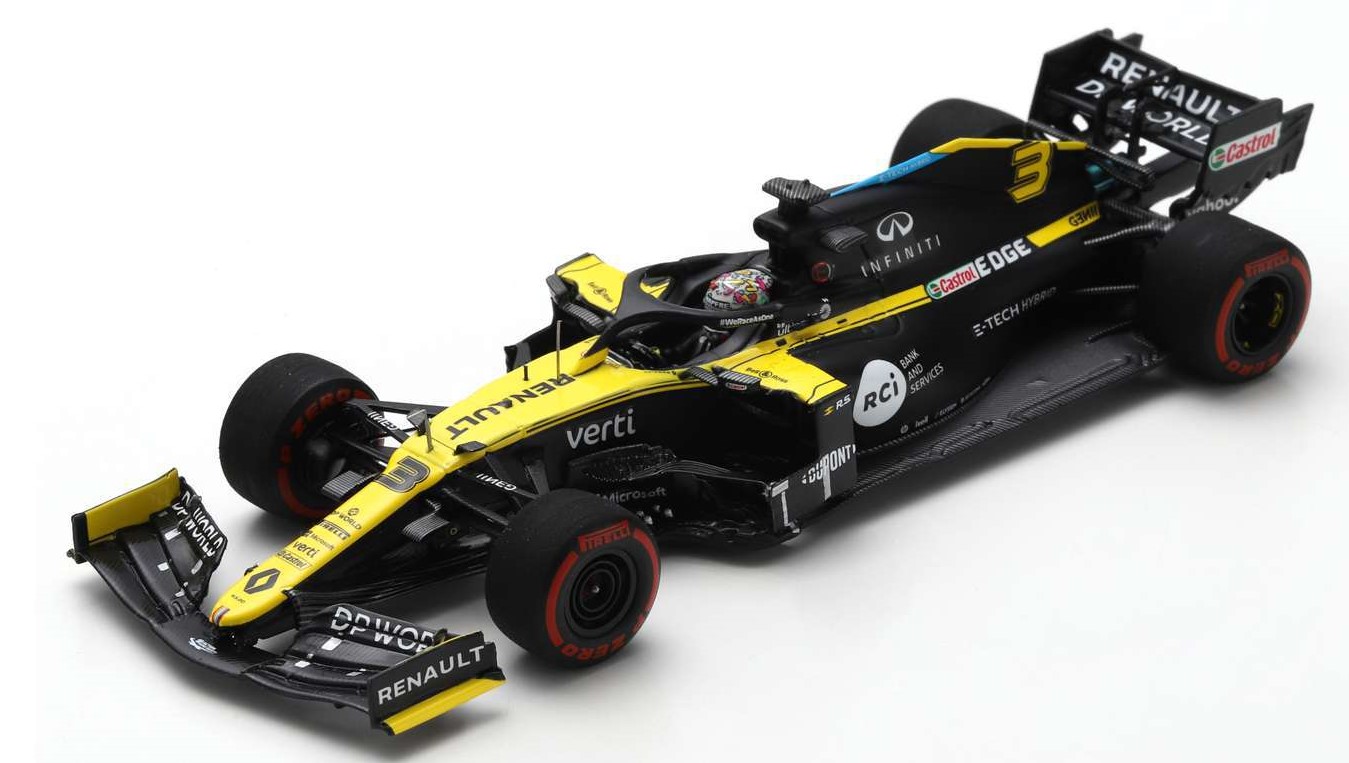 Spark: Renault R.S.20 D. Ricciardo 2020
Spark: Renault R.S.20 D. Ricciardo 2020
Renault - The Engine Supplier
From 1983, Renault began to supply other F1 teams with engines. The French company Mecachrome was given the responsibility of preparing and assembling the engines for these customer teams such as Lotus-Renault in 1983 and Ligier-Renault in 1984. Renault engines powered Williams and Benetton to six consecutive Constructors' Championships between 1992 and 1997 as well as five Drivers' titles. Red Bull-Renault dominated F1 from 2010 to 2013 with Sebastian Vettel. At various times, Renault engines were rebranded and appeared as Mecachrome, Playlife, Supertec and Tag Heuer.
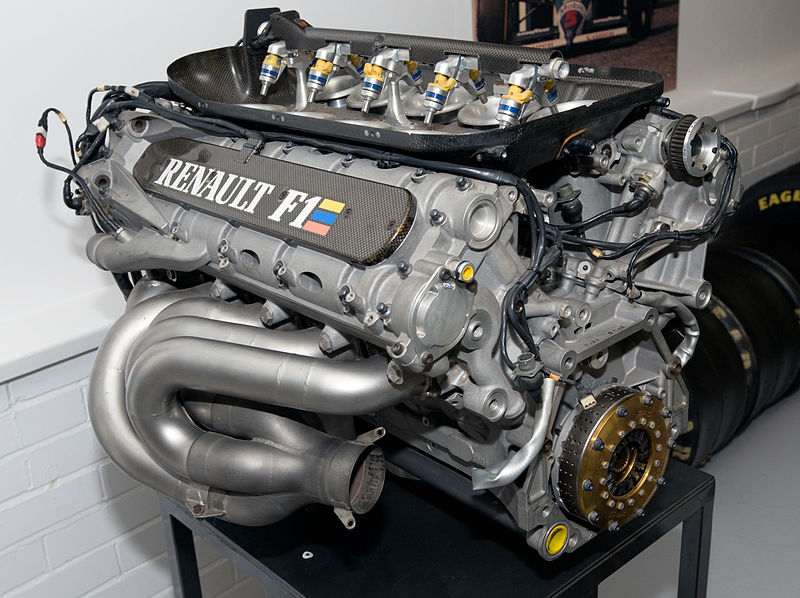 The Renault RS7 V10 engine was used by Benetton to win the Constructors' Championship and the Drivers' Championship for Michael Schumacher in 1995. (Photo: Morio)
The Renault RS7 V10 engine was used by Benetton to win the Constructors' Championship and the Drivers' Championship for Michael Schumacher in 1995. (Photo: Morio)
Note (1): Louis Renault, an early adopter of the "win on Sunday, sell on Monday" marketing strategy, sold 1,619 cars in 1906. The following year, 3,066 vehicles were sold.
 Vale: Dietrich Mateschitz (20 May 1944 - 22 Oct 2022) Red Bull Racing Founder
Vale: Dietrich Mateschitz (20 May 1944 - 22 Oct 2022) Red Bull Racing Founder
New Additions: October 2022
Hi and welcome to the October update; where has the year gone? Thank you to all those who dropped by my stand at the Hawkesbury Model and Hobby Show on the weekend of 17/18th September. A big shipment of Spark models arrived recently as well as some Brumm and Autocult models. Here are my highlights.
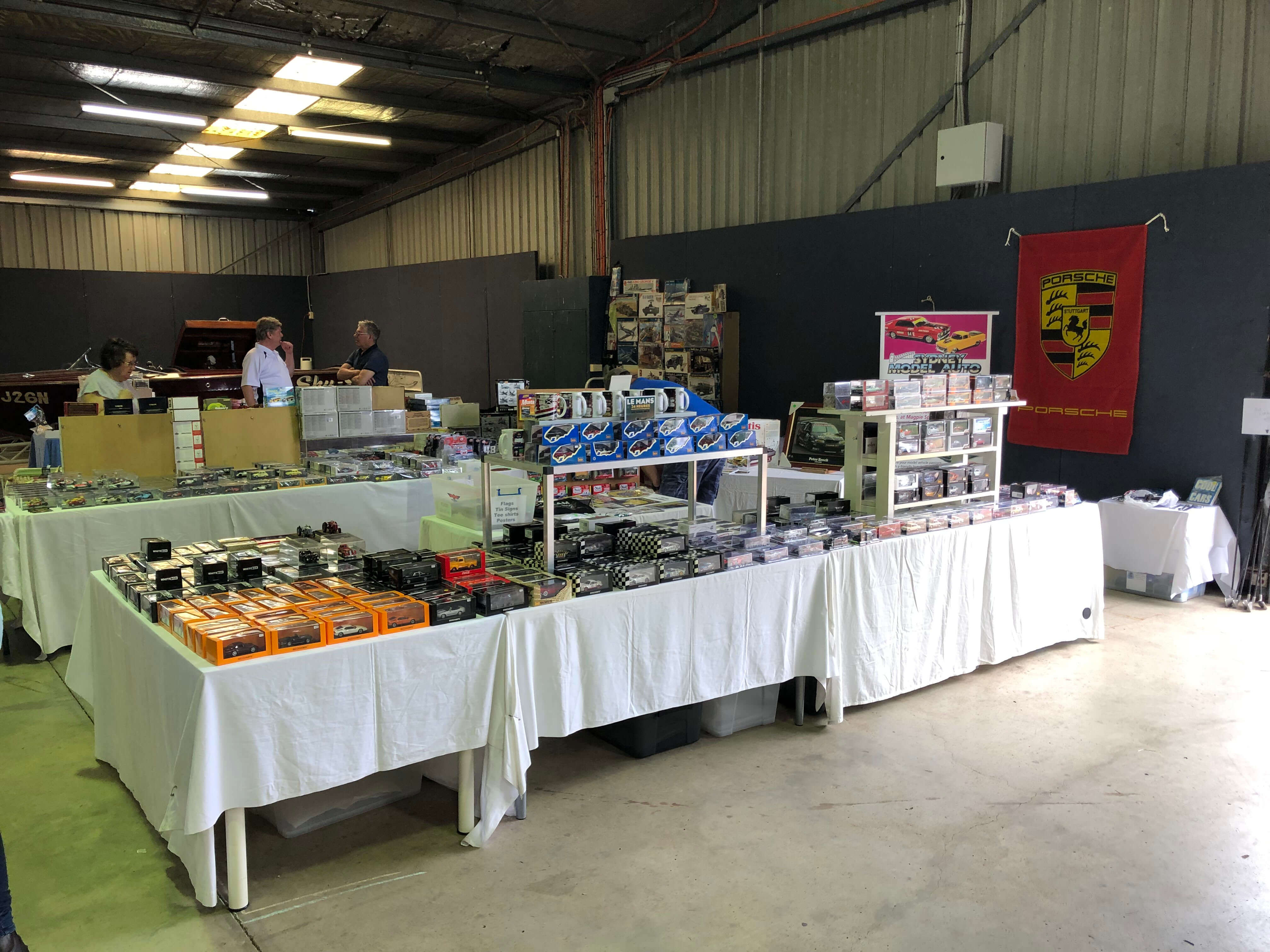 Hawkesbury Model &Hobby Show Sept. 2022
Hawkesbury Model &Hobby Show Sept. 2022
Very little is known about this unique Russian car named after its designer Akardij Dmitirevich Babich. Babich designed and built his own vehicles and his third car was a large 2-seater convertible. Overall, the construction period was three years and the car was finally completed in 1956. The "Babich Leningrad" was powered by a six-cylinder 'GAZ' engine with a displacement of 3.5 litres and an output of 90hp giving it a top speed of 130 kph. His privately built convertible was heavily inspired by the U.S. automobile industry which was frowned upon in the former USSR. However, the designer was still permitted to use his extraordinary American boulevard cruiser on public roads. The one-off car somehow survived and in 2014, in a state of disrepair, began a period of restoration which was finally completed in 2020. The German model maker, Autocult, is known for producing long since forgotten motor vehicles which stand out due to its extraordinary shape or its groundbreaking construction and the Babich Leningrad is a great example of its ethos. All Autocult models are limited editions of 333 models.
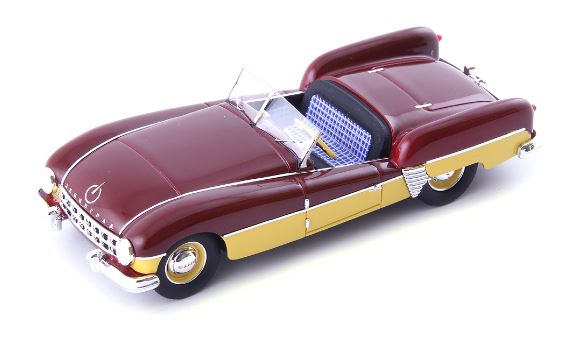 Autocult: Babich Leningrad 1956
Autocult: Babich Leningrad 1956
Chevron Cars Ltd is an English manufacturer of racing cars, founded by Derek Bennett in 1965. Bennett was a largely self-taught, intuitive engineer and a talented amateur racing driver. In 1967, Bennett produced the Chevron B8 sports racer which was both a success on the racing track and in the sales room. This success inspired Bennett to produce a prototype for the popular European 2-Litre Championship to be called the Chevron B16. Cosworth developed the 1.8-litre FVC for the new Chevron and Bennett designed and built the chassis. He out-sourced the body-work design to Specialised Mouldings who produced the beautiful, aerodynamic fibre-glass shell that impressed all who saw it. The B16's first race was in September 1969 at the Nurburgring 500 where works driver Brian Redman dominated the race to take a debut victory. The B16 became a regular winner and orders flooded in. In addition to the Ford FVC engine, customers were able to race using BMW and Madza rotary engines. A total of 23 cars were produced by Chevron, three of which were used in the Steve McQueen movie "Le Mans". Several models of the Chevron B16 have been replicated by Spark.
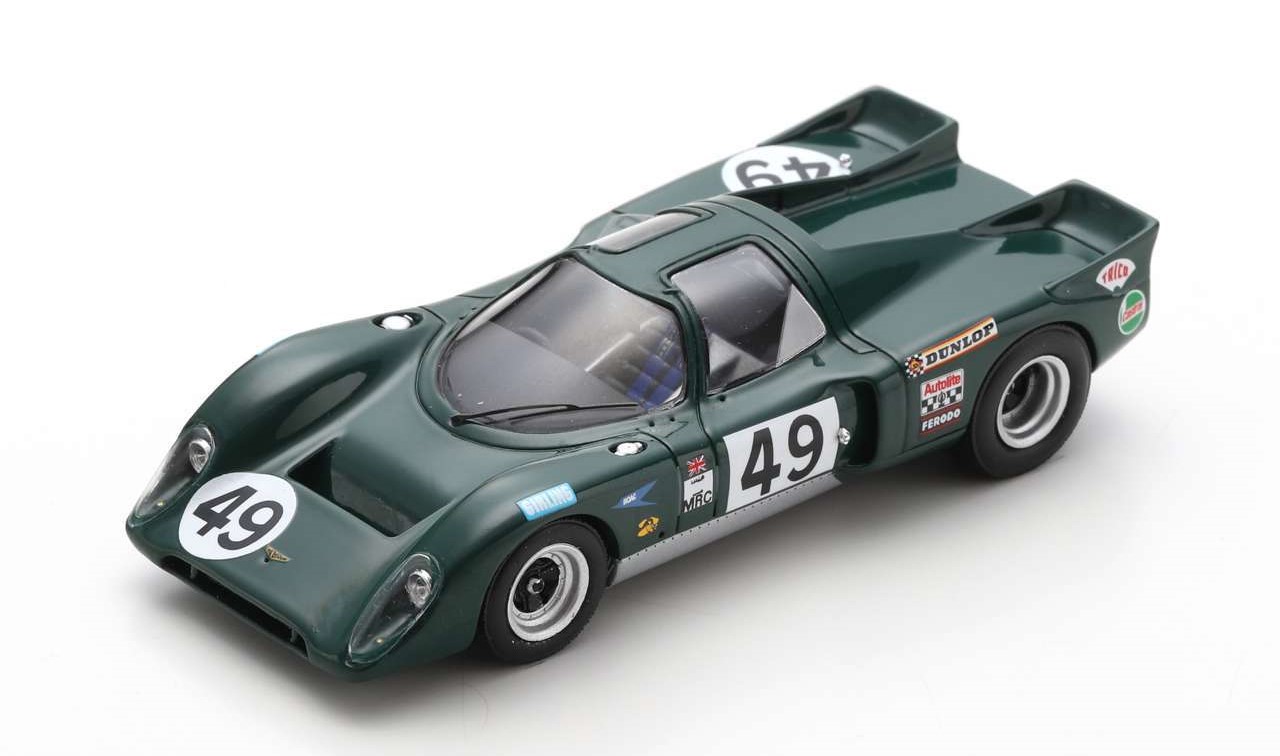 Spark: Chevron Ford B16 Le Mans 1970
Spark: Chevron Ford B16 Le Mans 1970
OK, that's it for another month. Just one model fair for October, the regular first Friday event (7 Oct) at the Epping Creative Centre hosted by the Sydney Model Auto Club. The club will also be having a model car display in two cabinets within the venue so come and check out what the club members collect. Also of interest is the Windsor High School Car Show on 16 October where the organisers expect 250+ cars of all makes and models. Check out their flyer here. Unfortunately, I'm unable to attend this show as a stallholder. Until next month, happy collecting.
Formula One
- 1961 Cooper Climax T55, J.Brabham (10) 6th Dutch GP (Spark)
- 1961 Cooper Climax T53, S.Moss (4) 1st International Trophy Non-Champ Race (Spark)
- 1968 Cooper BRM T86B, B.Redman (6) 5th Brands Hatch ROC (Spark)
- 1968 Cooper BRM T86B, L.Bianchi (7) 3rd Monaco GP (Spark)
- 1968 Cooper BRM T86B, L.Scarfiotti (6) 4th Monaco GP (Spark)
- 1968 Cooper BRM T86B, V.Elford (30) 4th French GP (Spark)
- 1961 Lotus Climax 21, J.Clark (15) 3rd Dutch GP (Spark)
- 1962 Lotus Climax 18/21, M.Trintignant (12) 1st Pau GP (non-Champ race) (Spark)
- 1962 Lotus Climax 18/21, N.Vaccarella (18) 6th Pau GP (non-Champ race) (Spark)
- 1962 Lotus Climax 21, J.Siffert (22) Belgium GP (Team Ecurie Filipinetti) (Spark)
- 1962 Lotus Climax 21, J.Hall (25) Mexican GP (non-Championship race) (Spark)
Le Mans / Sports cars
- 1970 Chevron Mazda B16, Vernaeve/Deprez (48) Le Mans (Spark)
- 1970 Chevron Ford B16, Skailes/Hine (49) Le Mans (Spark)
- 1971 Citroën SM, de Jamblinne/Bagrit (26) Spa 24hr (Spark)
- 1972 Citroën SM, Verrier/Foucault (55) Practice Le Mans (Spark)
- 1961 Lotus Elite Type 14, Kosselek/Massenez (40) 13th Le Mans (Spark)
- 1962 Lotus Elite, F.Gardner/Hobbs (44) 8th overall,1st GT1.3 Le Mans (Spark)
- 1971 Porsche 917K, Attwood/Charlton (3) Lucky Strike 9h Kyalami (Brumm)
- 1971 Porsche 917K, Elford/Larrousse (3) Team Martini 1000 km Monza (Brumm)
- 1971 Porsche 917K, Marko/Van Lennep (4) Team Martini 1000km Monza (Brumm)
- 1971 Porsche 917K, Martin/Pillon (57) 24h Le Mans (Brumm)
- 1974 Porsche 911 Carrera RSR 3.0, Schenken/Stommelen (57) Le Castellet 1000km (Spark)
- 1975 Porsche 911 Carrera RSR, Schenken/Ganley (59) Le Mans (Spark)
- 1977 Porsche 911 Carrera RSR, Schimpf/Fischhaber (16) Nurburgring 1000km (Spark)
American Racing Series
- 1955 Porsche 356 Speedster, James Dean (23F) Palm Springs Road Race (Brumm)
- 1955 Porsche 550A RS Spider, James Dean (130) Little Bastard (Brumm)
- 1970 Porsche 917K, Larrousse/Van Lennep (35) 6 hr Watkins Glen (Brumm)
- 1970 Porsche 917K, Ahren/Elford (3) Daytona 24h (Brumm)
- 1971 Porsche 917K, Martin/Brea (34) 1000km Buenos Aires (Brumm)
- 1971 Porsche 917K, Siffert/Bell (30) 1st 1000km Buenos Aires (Brumm)
- 1971 Porsche 917K, Fittipaldi/Reutemann (28) 1000km Buenos Aires (Brumm)
- 1984 Renault Alliance, T.Archer (33) Laguna Seca (Spark)
- 1963 Scarab Chevrolet MkIV, AJ.Foyt (77) 1st Nassau Trophy Race (Spark)
Road Cars
- 1956 Babich Leningrad in dark red/yellow (Autocult)
- 1954 Bentley Type R La Sarthe in grey (Autocult)
- 1958 Citeria 600 Roadster in dark green (Autocult)
After Thoughts: "He's led hundreds of laps in F1, but you may never have heard of him." In fact, of the current drivers, only Lewis Hamilton and Sebastian Vettel have led more laps than this driver, that's because Bernd Mayländer drives the F1 Safety Car. Born in Germany, Mayländer is an accomplished racing driver, starting out in karts before graduating to Formula Ford, Porsche Carrera Cup and the original DTM. He won the Nurburgring 24 hour race in 2000 driving a Porsche 911 GT3-R. In 1999 at the San Marino F1 GP, Mayländer was racing in the Porsche Supercup support race when he was unexpectedly summoned by then race director, Charlie Whiting who asked Mayländer to drive the safety car for the F3000 support race. The incumbent safety car driver was unavailable as he was entered in F3000 that weekend. So began Mayländer's tenure as a safety car driver.
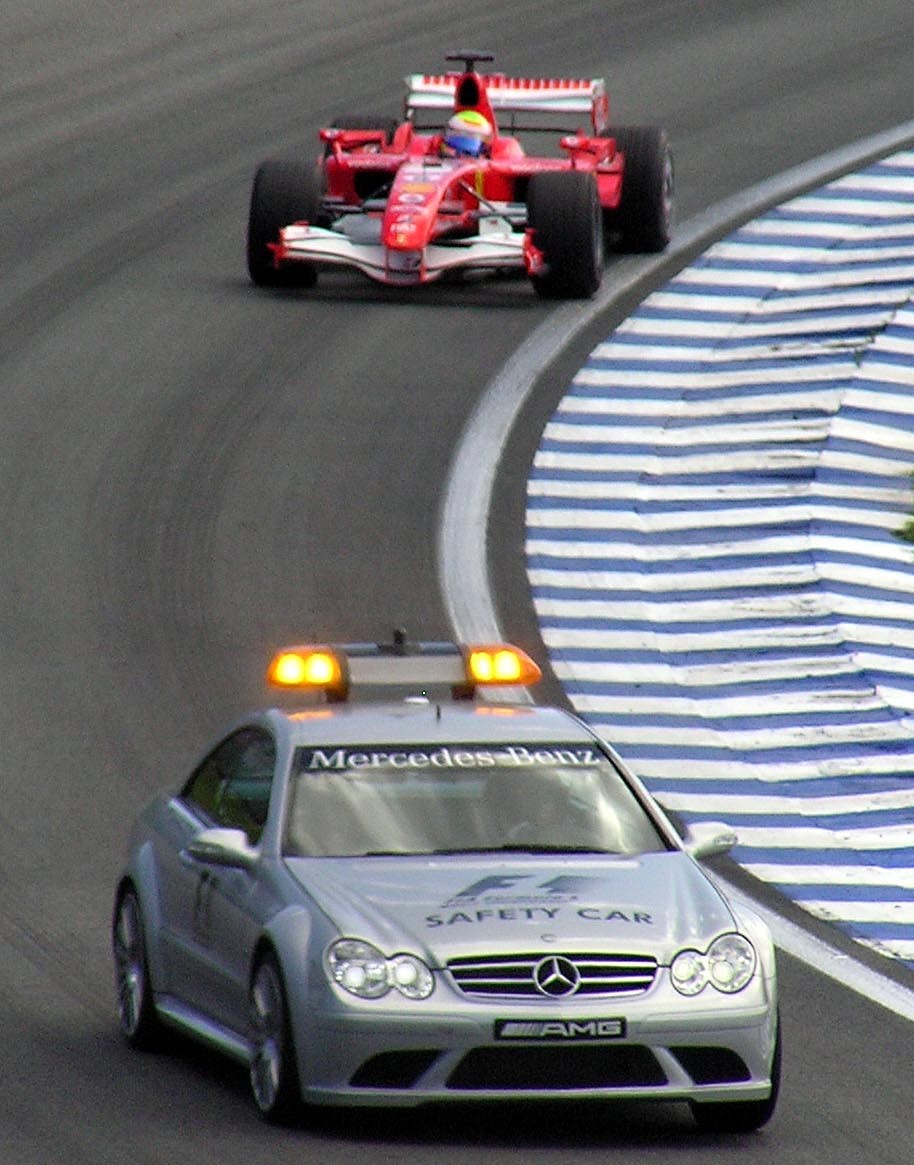 Mercedes CLK63 leading Massa 2006 Brazil (Photo: Morio)
Mercedes CLK63 leading Massa 2006 Brazil (Photo: Morio)
In 2000, Mayländer was officially appointed the safety car driver for all Formula One races1, missing only two races to date and in 2004, Mayländer decided to quit racing completely to devote his time fully to his safety car driving duties. Mayländer has so far spent more than 700 laps in the lead of GP races; putting this into perspective, this equates to about 12 races in the lead2. When the safety car is deployed by the race director, Mayländer drives his car on the limit at braking points and corners but on the straights, he has to lift off to allow cars to rejoin at the back. If he can do 250 kph on the straights, he would limit his speed to 150 kph which often incurs the wrath of the leading F1 car. Early in the 2022 season when Mayländer was in an Aston Martin Vantage, Max Verstappen radioed his crew to complain the green Vantage was a "turtle" that was too slow to allow him to keep heat in his tryes. Fortunately, Mayländer can not hear the drivers radio transmissions. Mayländer estimates that he is about 8-9 seconds slower than an F1 car over a kilometre which is still seriously quick and luckily he has never spun the safety car while leading the pack.
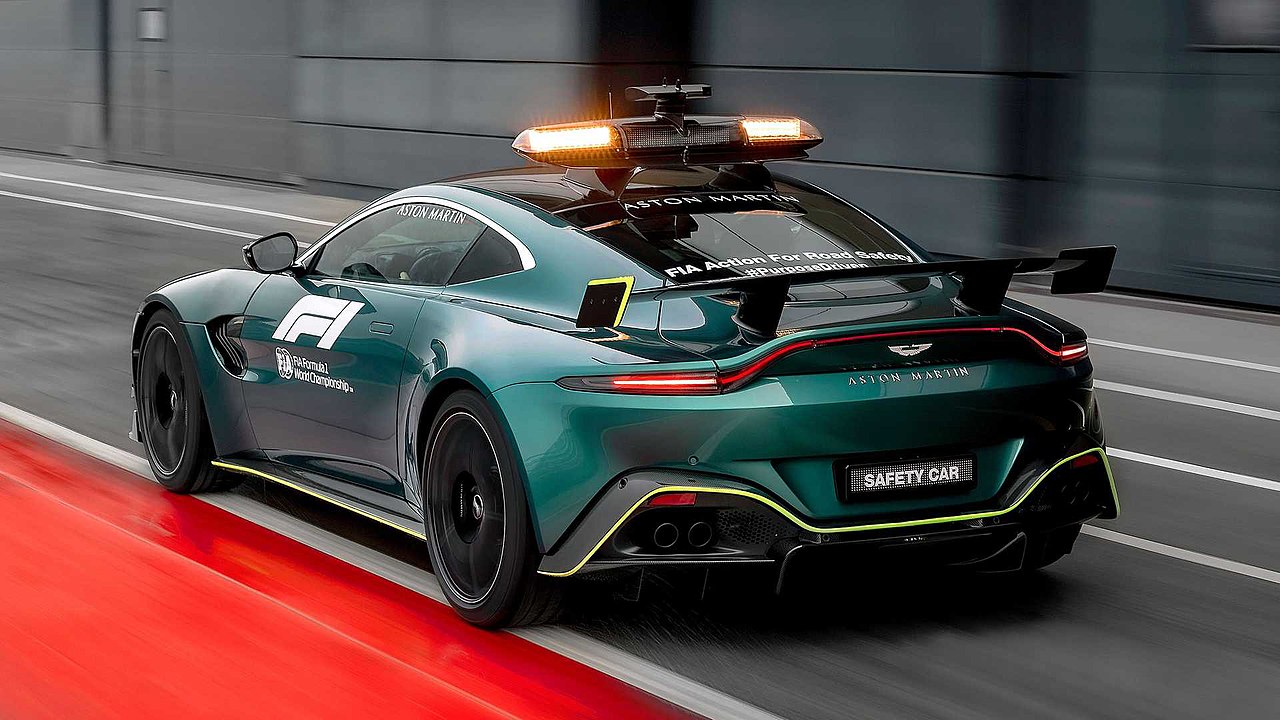 Aston Martin Vantage Safety Car (Photo: Yoyodu10)
Aston Martin Vantage Safety Car (Photo: Yoyodu10)
Mayländer nominates threes races in which he had to drive in atrocious condtions; Fuji 2007 where he was deployed three times and his car was in danger of running out of fuel, Montreal 2011 where he spent 34 laps out in front, more than any other driver in that race and China 2009 with the rain so heavy that Mayländer admitted to nearing 'losing' his car. Whilst in the F1 safety car3, Mayländer has to assess the track conditions, letting the race director know where there is standing water, where a dry line in forming and he recommends when he should pull into the pits. The safety car's co-driver does all the communications with race control but Mayländer has a live TV feed of the on-track action, a GPS map where he can see the position of all the cars on track and he also has a Marshalling System that tells him the flag colour around the track.
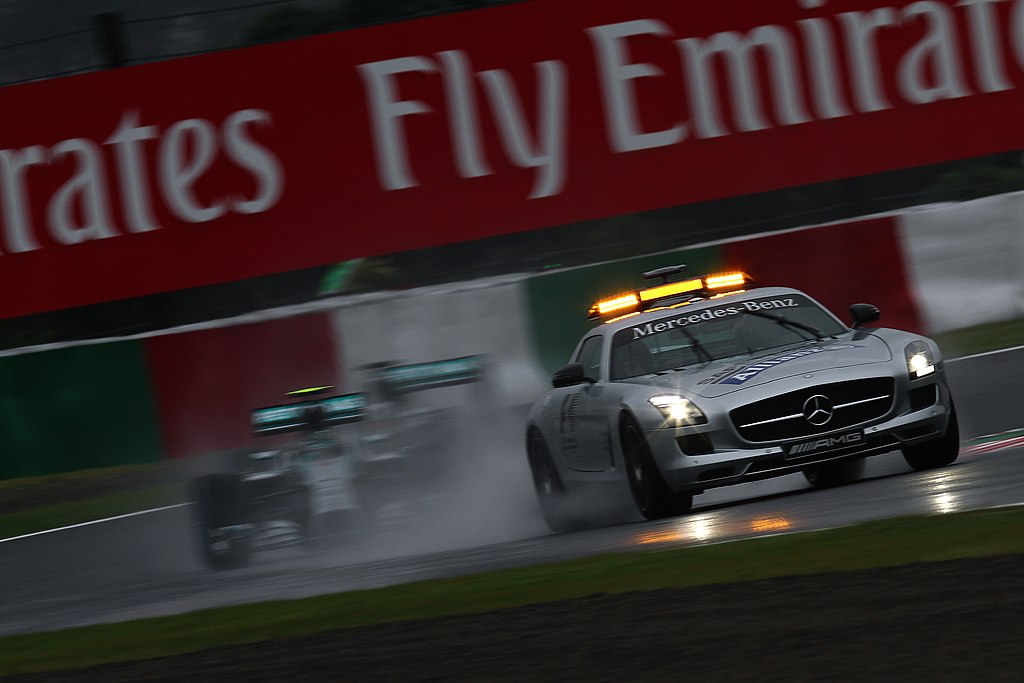 Mercedes SLS AMG 2014 Japan (Photo: T.Suzuki)
Mercedes SLS AMG 2014 Japan (Photo: T.Suzuki)
The safety cars that Mayländer has driven are typically fast, world-class coupes, sedan and supercars. The first one he drove in 1999 was a road going Mercedes CLK55 with 360 hp. In 2000 he drove a virtual show room Mercedes CL55 and only from 2001 was development work done on safety cars to improve performance particularly tyres and brakes. Today he drives an AMG GTR Black Series with 730 hp, alternating with the Aston Martin Vantage. Over the years there have been many different cars used as safety cars since they were first deployed in 1973 (Porsche 914). Some of the more memorable ones include the Lamborghini Countach in 1983, the Porsche 911(930) in 1976, the Porsche 993 GT2 in 1995, the Honda Prelude in 1994, the Mercedes SLS AMG in 2010, the Aston Martini Vantage in 2021 and the Fiat Tempra and Renault Clio Williams also made an appearance.
Note (1): Mayländer drives the safety car for all GP support races over the race weekend in addition to the F1 race.
Note (2): Based on an average of 60 laps per race
Note (3): There are always two safety cars at each GP; one is used for the F1 race and the other for all the support races.
New Additions: September 2022
Hi and welcome to the September update. Firstly, thank you to everyone who dropped by my stall at the Shannons Sydney Classic at the Sydney Motor Sport Park on 14 August. Thankfully, the weather was fine and there was a good turnout of cars on display; I hope you all had a great day. Quite a large shipment of Spark models arrived during the previous month and my highlighted models are ...
The Bonneville Salt Flats in western Utah is a unique natural feature, stretching over 120 square kilometres. Every year, the Bonneville Speed Week organised by the Southern California Timing Association is held on its perfectly flat, thick crusted salty soil for a variety of automotive classes where drivers compete to set the highest speed. In 2016, a Renault Dauphine (produced from 1956 - 1967) was entered in the Classic Gas Coupe class for vehicles made between 1928-1981 with minimal bodywork modifications and engine management systems limited to the original fitted by the manufacturer. The Dauphine is a rear-engined car equipped with an 845 cc engine and was driven by Nicholas Prost to a best run of 122.3 kph. This attractive car with its dazzling blue paintwork has been produced by Spark under its Bizarre brand.
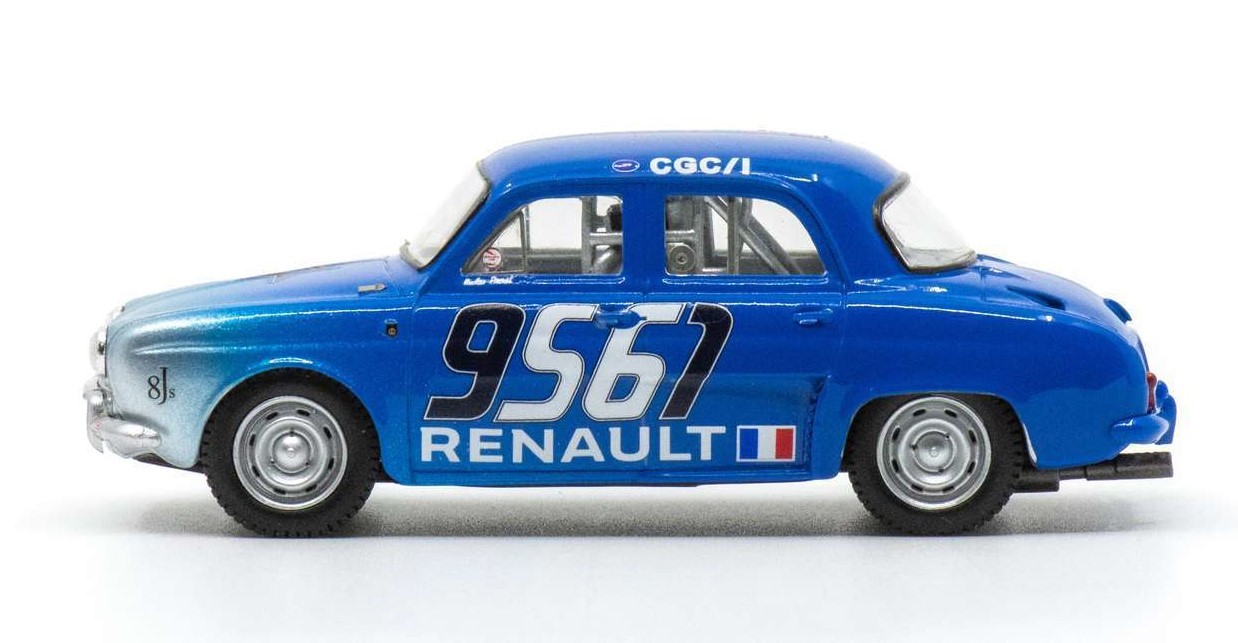 Bizarre: Renault Dauphine 2016 Bonneville
Bizarre: Renault Dauphine 2016 Bonneville
The Automobile Club de l'Ouest (organisers of the Le Mans 24h race) recently announced a new hydrogen class starting from 2025 and a prototype has been jointly produced by the ACO and GreenGT called MissionH24. There are several ways of producing hydrogen and the ACO has naturally opted for 'green hydrogen', i.e. produced using a carbon-free process. The MissionH24 prototype has four electric motors on the rear wheels (two on each) to provide propulsion. The hydrogen fuel-cell (developed by GreenGT) is where molecules of dihydrogen and oxygen atoms combine to form water (H2O); this reaction produces heat and electricity which powers the electric motors. The MissionH24 car has been undergoing testing by development driver, Norman Nato at different circuits across Europe including some tests at Le Mans. The data from these tests will form the basis of creating the regulations for the new category. The MissionH24 prototype has been produced by Spark.
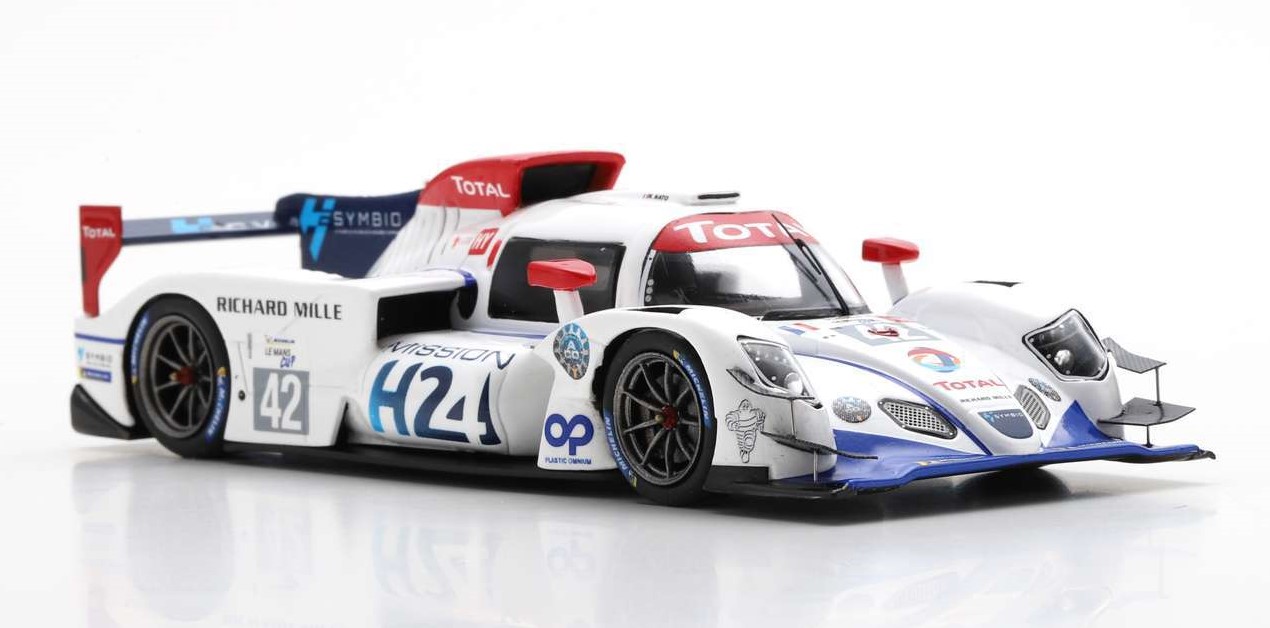 Spark: MissionH24 Hydrogen prototype
Spark: MissionH24 Hydrogen prototype
The 2nd round of the 1983 All Japan Endurance Championship was held on the 6.033 km Suzuka Circuit and was raced over 1000 kilometres. The race was for Group A, B and C cars and was won by the Group C Porsche 956 co-driven by Vern Schuppan. The hotly contested Group B consisted of seven Mazda RX-7s with one Toyota Corolla and one Subaru Leone making up the field. The Corolla finished 2nd in Group B with the Subaru coming in 4th in class. The Subaru Leone E-AB5 had an engine capacity of 1800 cc and the second generation model was produced from 1981 to 1994. In motorsports, the Subaru Leone is better known as a rally car competing in several World Rally Championship events between 1980 abd 1989. The Leone that raced at Suzuka has been faithfully reproduced by Spark as a Japanese National release with a limited edition of 500.
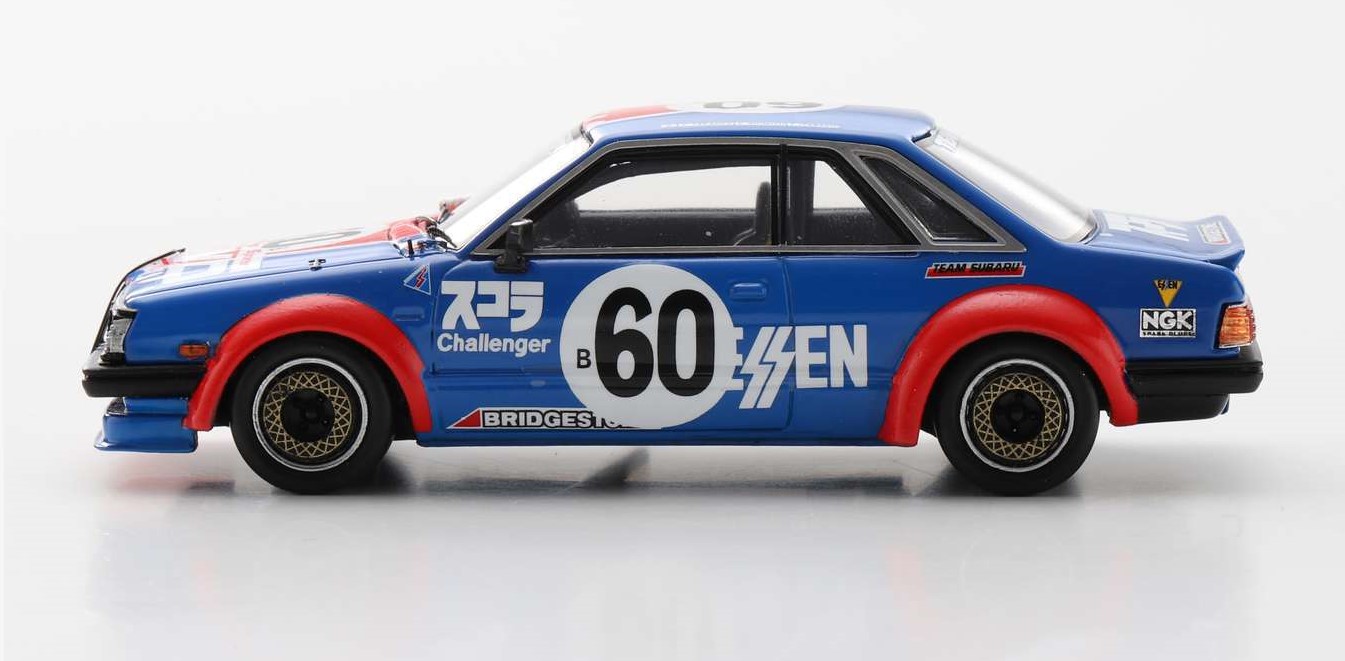 Spark: Subaru Leone 1983 Suzuka 1000km
Spark: Subaru Leone 1983 Suzuka 1000km
OK, that's it for another month. The latest news is the All British Day, scheduled for 11 September has been cancelled again. Previous cancellations were due to Covid but this year the event, which is held at the Kings School, North Parramatta has been cancelled due to the school grounds being still too wet to accommodate hundreds of cars. The organisers are trying to find another date instead of permanently cancelling it until next September. The other events for September are the monthly Sydney Model and Toy Fair (2 September at Epping) and the Hawkesbury Model and Hobby Show (17 and 18 September). The Hawkesbury show is part of the Clarendon Classic Machinery Rally for antique machinery. I hope to see you there, until then happy collecting.
Formula One / Two / Race Transporters
- 2021 Alpha Tauri Honda AT02, P.Gasly (10) 3rd Azerbaijan GP with pit board (Spark)
- 2021 Alpha Tauri Honda AT02, Y.Tsunoda (22) 9th Bahrain GP (Spark)
- 2021 Alpine Renault A521, E.Ocon (31) Bahrain GP (Spark)
- 1983 Arrows Ford A6, A.Jones (30) Long Beach GP (Spark)
- 1983 Arrows Ford A6, M.Surer (29) Brazilian GP (Spark)
- 1983 Arrows Ford A6, C.Serra (30) Brazilian GP (Spark)
- 1968 Matra Ford MS7, J.P.Beltoise (10) 3rd Grand Prix de Pau F2 (Spark)
- 2021 Mercedes AMG W12, L.Hamilton (44) 1st Spanish GP (100th pole) (Spark)
- 2021 Red Bull Honda RB16B, S.Perez (11) 1st Azerbaijan GP with pit board (Spark)
- 2021 Red Bull Honda RB16B, M.Verstappen (33) 2nd Spanish GP (100th GP) (Spark)
- 1974 Surtees Ford TS16, J.Mass (19) Brazilian GP (Spark)
- 1984 Toleman Hart TG184, A.Senna (19) 2nd Monaco GP (Spark)
- 1984 Toleman Hart TG184, J.Cecotto (20) Monaco GP (Spark)
- 1947 Morris PV, Elva Engineering Race Support Truck (1956) (Spark)
- 1948 Morris PV, Michelin Tyres van (Spark)
Le Mans / Sports Cars
- 1953 Alfa Romeo 6C/3000 CM, Sanesi/Carini (21) Le Mans (Spark)
- 1953 Alfa Romeo 6C/3000 CM, Kling/Riess (23) Le Mans (Spark)
- 2018 McLaren 720S GT3, Van Gisbergen/Parente/Barnicoat (5) 8th Gulf 12 hr (Spark)
- 1955 Mercedes-Benz 300 SLR, Fangio/Moss (19) Le Mans (Spark)
- 1955 Mercedes-Benz 300 SLR, Levegh/Fitch (20) Le Mans (Spark)
- 1955 Mercedes-Benz 300 SLR, Fangio (1) 1st Kristianstad GP (for Sports Cars) (Spark)
- 2020 MissionH24 Prototype, Norman Nato Hydrogen-electric prototype (Spark)
- 1950 Panhard Dyna X84, Eggen/Escale (57) 29th Le Mans (Spark)
- 1953 Peugeot 203C, Constantin/Aunaud (66) 25th Le Mans (Spark)
- 1973 Porsche 908/2, Ortega/Merello (4) 7th Le Mans (Spark)
- 1983 Subaru Leone RX 4WD, Shimizu/Takaoka/Itabashi (60) Suzuka 1000km (Spark)
Australian Racing Series
- 1971 Chevrolet Camaro ZL-1, B.Jane (7) 1st ATCC (Armco)
American Racing Series
- 1981 Lola Chevrolet T600, B.Redman (7) 1st Laguna Seca 100 miles (Spark)
- 1982 Lola Chevrolet T600, J.Paul Jr. (18) 1st Laguna Seca 100 miles IMSA (Spark)
- 1982 Lola Chevrolet T600, Field/Whittington (0) 1st Riverside 6hr IMSA (Spark)
- 1983 March Chevrolet 83G, Wolters/Lanier/Hinze (88) 2nd Daytona 24hr (Spark)
- 1972 Porsche 914/6 GT, Rojas/Rebaque (5) 1000km de Mexico (Spark)
- 2020 Bamber/Jaminet/Vanthoor (912) 2nd GTLM Daytona 24h (Spark)
Rally / LSR
- 2016 Renault Dauphine, Classic Gas Coupe class 122.3kph - Bonneville N Prost (Bizarre)
- 1963 Citroen DS19, Toivonen/Jarvi (233) 2nd Monte Carlo Rally (Spark)
- 1956 Renault Dauphine, Thirion/Ferrier (9) 1st Tour de Corse Rally (Spark)
Road car
- 1958 Lotus Elite Type 14 in British Racing Green (Spark)
After Thoughts: "Long Live the House that Haas Built." Immediately after winning the F1 World Championship in 1992, Nigel Mansell made the audacious decision to quit F1 to race in the American Indy Car racing series. The team he joined was Newman/Haas Racing. With five wins in his rookie season, Mansell won the Indy Car World Series and into the history books as holding both F1 and Indy Car titles in the same year. This legendary race car that Mansell drove is one of many that Newman/Haas will be offering for sale by auction.
The Newman/Haas team was founded by businessman Carl Haas and actor Paul Newman in 1983 and raced until its withdrawal at the end of the 2011 season. This illustrious and successful IndyCar team has now decided to auction off its vast collection of cars and other memorabilia. A total of 40 racing cars representing both ends of the team's racing spectrum are among the 78 lots that will go under the hammer in an auction run by RM Sotheby's on 29 October. Given that Carl Haas' company was the official Lola distributor in the U.S., the Indy cars to be sold are predominantly made by this UK marque but there are also Panoz, Dallara and Swifts cars as well. Race-worn helmets and numerous trophies, race suits, artwork and model cars are also up for auction.
Here, reproduced is a shorten version of RM Sotheby's introduction to the forthcoming auction.
"With an overall record of 108 wins and 8 championship seasons, the Newman/Haas Racing team has amassed a history of winning that puts them in the top tier of Indy Car teams. Fielding undisputed superstars like Michael and Mario Andretti, Nigel Mansell and Sebastien Bourdais, the team founded by Carl Haas and Paul Newman dominated both the CART and Champ Car series between 1983 and 2011. Now, the private team plans its most public outing in years, an international auction hosted by RM Sotheby's of Newman/Haas Racing's treasured, race-proven chassis and many artifacts from their history.
Though Haas and Newman were fierce competitors in the Can-Am era, they shared a goal of rising to the top of the Indy Car leaderboard. The driving force pushing the team to victory was Mario Andretti, a veteren of varied formats and a tireless competitor. While driving a 1984 Lola-Cosworth, Andretti scored six victories and went on to win the CART PPG Indy Car World Series.
Newman/Haas Lola 1984 T800 Cosworth 1984 (Photo: RM Sotheby's)
In 1991, in Michael Andretti's second year with the team, he won the Indy Car World Series. The sucess continued in 1993, when Haas managed a miracle, signing Nigel Mansell away from F1 after his winning season with Williams. After winning five races outright, Mansell took home the PPG Indy Car World Series trophy after the penultimate race, becoming the only person to have won back-to-back championships in the same year in F1 and Indy car.
Newman/Haas 1993 Lola T93/00 Cosworth (Photo: RM Sotheby's)
Nine years later, after seven races and seven pole positions, Cristiano da Matta became the 2002 Indy Car world champion. One year later, the most-awarded driver in Champ Car history, Sebastien Bourdais, started his ascendency for the Newman/Haas team. The result was historic, with Bourdais taking home the championship four years in a row, from 2004 to 2007.
Newman/Haas 2005 Lola B05/00 Cosworth (Photo: RM Sotheby's)
Having been described as the largest importer of race components on the American continent, Carl Haas forever altered the fabric of competitive driving in America. Now, the artifacts of Haas' success are offered to the public for the first time. These race-proven chassis still tell a full story, one of dedication from every member of the Newman/Haas team and an undeniable pattern of victory; a foundation built on winning that will remain legendary forever. Long live the house that Haas built."
New Additions: August 2022
Hi and welcome to another monthly update. Again, I'd like to thank all those who braved the wet and cold weather to attend the second Sydney Toy and Hobby Fair at Epping - will the rain ever stop in Sydney? This month sees no fewer than 15 Spark F1 models added to my stock. Spark have been sending out huge shipments of models from its factory recently and this has prompted one leading commentator to express his concern about the long-term health of our hobby. His argument is that not many collectors can afford to buy everything they want, most of us have to exercise some fiscal restraint. Some may even give up collecting all together, frustrated with overwhelming releases and knowing they can't afford to collect what they want. As a smaller dealer, I have had to place pre-orders with my Spark distributor thinking they would be released in consistent, manageable quantities but the constant huge releases are making cash-flow management a challenge; this applies to distributors, as well as dealers and collectors. I hope Spark would just think about reducing the number of new releases to allow everyone to catch their breaths. OK, enough of my ranting, so what are the highlights this month?
Having competed in Formula 3000 in 1985 and '86 with mediocre results, Automobiles Gonfaronnaises Sportives (thankfully better known as AGS) decided to try Formula 1 by entering the 1986 Italian GP. The Italian GP was the 13th of 16 races and amazingly AGS had just 7 employees and operated from the owners' petrol station in a provincial French village. Predictably, technical issues prevented AGS from finishing the two races entered that year. For the team's first full season in 1987, a new chassis was designed to be powered by a normally-aspirated Cosworth DFZ 3.5 litre engine and the single entry was driven by Pascal Fabre. Fabre was a reliable driver, finishing most of the 14 races entered but never looked likely to score points. For the last two races, Roberto Moreno was given the AGS drive and in the last race at Adelaide, he finished 6th scoring one championship point. Spark have released this significant point-scoring car.
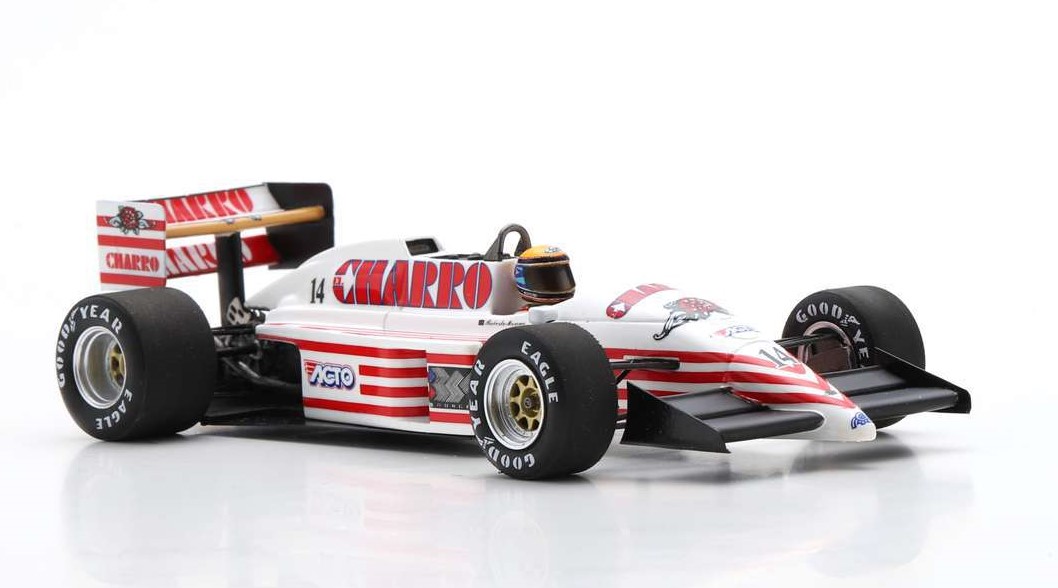 Spark: AGS JH22 R.Moreno 6th Australian GP 1987
Spark: AGS JH22 R.Moreno 6th Australian GP 1987
Last month, I highlighted the 2018 Australian Porsche Carrera Cup winning car of Jaxon Evans. This month it's the turn of the 2020 championship car of Cooper Murray. 2020 was a year badly affected by Covid with only the first round at the Adelaide street circuit fully completed and just one race at the Australian GP. The three races at Adelaide were won emphatically by Cooper Murray from the McElrea Racing squad. The next round was to be a support category to the Australian GP in Melbourne and one race was completed on Thursday before a Formula 1 mechanic contracted Covid. The GP was cancelled and officials ended the Porsche meeting. Cameron Hill won the race on Thursday with Murray in 3rd place. Officially, no champion was crowned but Murray was leading when racing was cancelled. Spark have produced the Porsche of Cooper Murray.
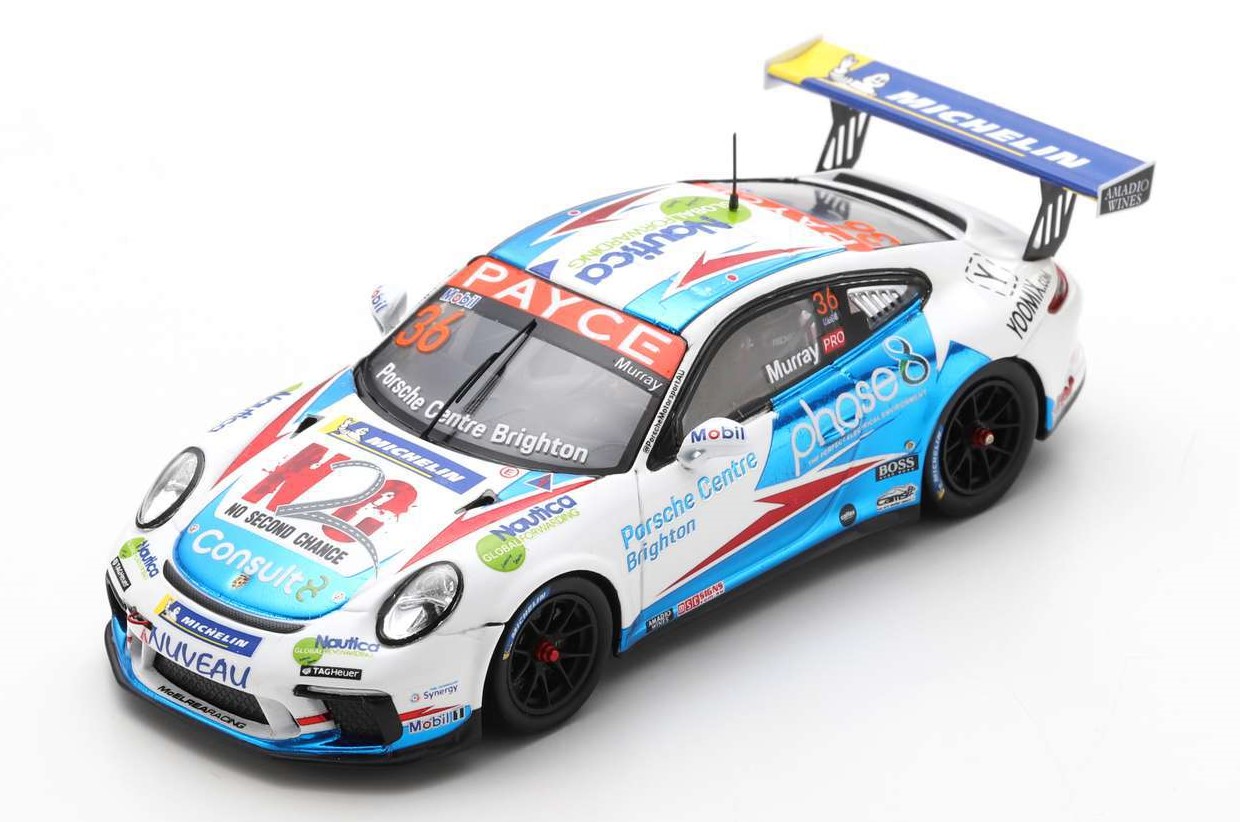 Spark: 2020 Carrera Cup car of Cooper Murray
Spark: 2020 Carrera Cup car of Cooper Murray
Well, that's it for another month. I've rushed a bit to get this update uploaded in time to remind everyone of the Collector Con Fair on 31 July. In August we have a number of events scheduled; firstly, the Friday evening Toy Fair at Epping on the 5th, the Hunter Model Auto Club's Toy Fair in Newcastle on 7th and then the Shannons Sydney Classic Day on 14th August. The Classic Day at the Sydney Motorsport Park should be huge day. Unfortunately, I won't be able to make the Hunter Toy Fair this year but I hope to see you at the other two events, until then happy collecting.
Formula One
- 1987 AGS Ford JH22, R.Moreno (14) 6th Australian GP (Spark)
- 1966 Lotus Climax 33, P.Rodriguez (2) French GP (Spark)
- 1972 March Ford 711, C.Pace (22) South African GP (Spark)
- 1973 March Ford 731, R.Wisell (27) DNQ Swedish GP (Spark)
- 1973 March Ford 731, R.Williamson (14) British GP (Spark)
- 1973 March Ford 731, J.P.Jarier (14) Monaco GP (Spark)
- 1975 March Ford 751, M.Donohue (28) 5th British GP "Penske" (Spark)
- 1974 McLaren Ford M23, D.Charlton (23) South African GP "Lucky Strike" (Spark)
- 1975 McLaren Ford M23, E.Fittipaldi (1) 1st British GP "Texaco" (Spark)
- 2020 Racing Point Mercedes RP20, S.Perez (11) 1st Sakhir GP with pit board (Spark)
- 1981 Tyrrell Ford 011, M.Alboreto (4) Dutch GP (Spark)
- 1982 Tyrrell Ford 011, S.Borgudd (4) South African GP (Spark)
- 1983 Tyrrell Ford 011, M.Alboreto (3) 1st US GP (Spark)
- 1983 Tyrrell Ford 011, D.Sullivan (4) 5th Monaco GP (Spark)
- 1974 Williams Ford FW, J.Laffite (21) German GP (Spark)
Australian Racing Series
- 2017 Porsche 911 GT3 Cup, D.Wall (38) 1st Carrera Cup Australia "Payce" (Spark)
- 2020 Porsche 911 GT3 Cup, C.Murray (36) Carrera Cup Australia (Spark)
Road Cars
- 1967 Fiat 850 in red (Edicola)
- 1968 Fiat 124 in beige (Edicola)
- 1931 Ford Model A, US Mail Van in brown (MotorHead)
- 1931 Ford Model A, Sutton Florist Van in black (MotorHead)
- 1940 Ford Panel Van, Russ Dawson Genuine Ford Parts in grey (MotorHead)
- 1940 Ford Panel Van, Bedick's Dairy in dark blue (MotorHead)
- 1955 Ford Thunderbird Coupe in yellow (MotorHead)
- 1955 Ford Thunderbird Coupe in red (MotorHead)
- 1955 Ford Thunderbird Coupe in blue (MotorHead)
- 1954 Mercedes Benz 170D, Automotores Juan M Fangio (service van) (Edicola)
- 1968 Mercury Cougar Coupe in pale yellow (MotorHead)
- 1961 Renault Ondine in silver (Edicola)
- 1964 Renault R4 in blue (Edicola)
- 1964 Renault R8 in beige (Edicola)
- 1964 Volvo 121 Amazon in light blue (Edicola)
After Thoughts: "The Unheralded Driver Series #6 - Marc Surer." Switzerland has produced some prominent grand prix drivers over the years which is remarkable given that circuit motor racing was banned in the country from 1955 to 2015. In fact, there were 32 Swiss drivers who have entered Formula One races, with 23 of them having started a race. Some noteworthy drivers include Jo Siffert (Switzerland's first GP winner), Clay Regazzoni (5 GP wins) and the most recent Swiss driver, Sebastien Buemi. To this list should be added Marc Surer who competed in 88 Grand Prix over eight seasons in the premier formula.
 Marc Surer Logo
Marc Surer Logo
Born on 18 September 1951, Marc Surer like many other F1 drivers, started his career in karting. Due to the motor racing ban in his home country, he relocated to Germany in 1974 to pursue his passion for racing in the local Formula Vee Championship. By 1976 he had moved up to European F3 and by 1977 he was racing in F2 finishing second in 1978. After winning the F2 championship in 1979, Ensign decided to give Surer a run in its car in place of Patrick Gaillard for the last three races of the season starting with the Italian GP at Monza. Unfortunately, Marc was one of four drivers who failed to qualify. He also failed to qualify for the following race in Canada but started from 21st in the US GP where engine problems end his race early.
For the 1980 season, Surer was contracted to the ATS Team and finished 7th in the second race at Brazil before moving to South Africa for the following race. While qualifying at the Kyalami circuit, the brakes on his ATS failed on the fast straight, sending Surer into the wall head-on and resulted in badly broken legs. Remarkably, Surer only missed the next three races while recuperating. However, his time at Team ATS was not successful, scoring zero points.
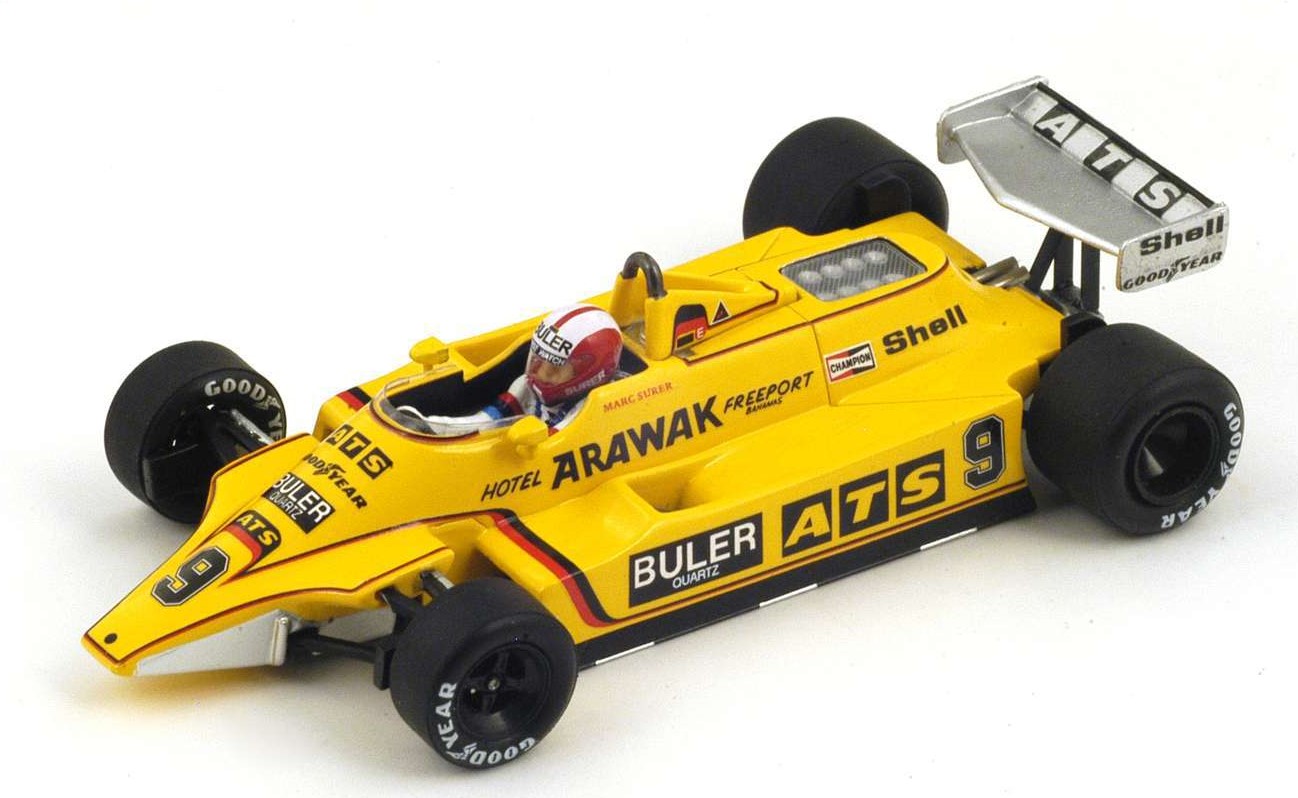 Spark: ATS Ford D4 - M.Surer 1980
Spark: ATS Ford D4 - M.Surer 1980
In 1981, Surer rejoined Mo Nunn's Ensign team on a race-by-race basis, scoring 4 points by mid-season before he was replaced by a better paying driver. He switched to Theodore Racing to see out the season. Although regularly finishing races, the Theodore Ford TY01 was not competitive and no points were forthcoming. Unsurprisingly, Surer ranks the Theodore as the worst car he's driven. Jackie Oliver saw potential in the Swiss driver and recruited him to drive the Arrows Ford A4 for 1982. The team went to Kyalami for pre-season testing and with incredibly bad luck, the suspension failed at high speed and Surer broke his legs again! This time the accident was worse; he lost some movement in his leg, slowing the time to move his right foot between pedals. This forced Surer to become an early-adopter of left-foot braking. With great fortitude, Surer was back in the Arrows after missing 4 races and finishing 7th in his first race. He finished the '82 season with 3 points. For '83, Surer remained with Arrows and with the A6 scored points in 3 of the first 4 races. It was to be the only points for the year.
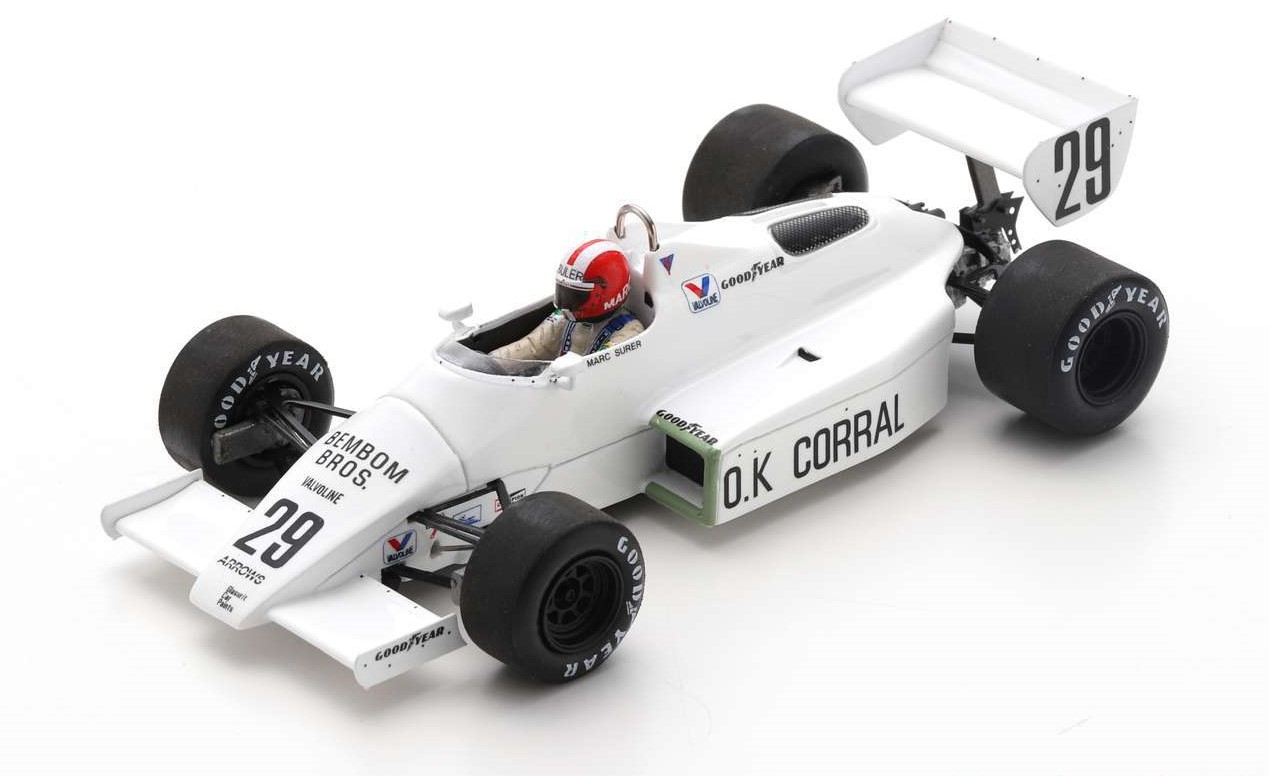 Spark: Arrows A6 M.Surer 1983 French GP
Spark: Arrows A6 M.Surer 1983 French GP
Marc stayed with Arrows for the '84 season which was the year the team transitioned from Cosworth DFV power to BMW turbo power. The year started with the old A6 chasis (no points) then finished with the brutal turbo-powered A7. The many technical issues with the new chassis/engine combination led to a string of retirements but a surprising 6th place at the Austrian GP was the only highlight of an otherwise disappointing year. During his pre-F1 days, Surer was part of the BMW racing program and his BMW connections led to an offer in 1985 to drive for Brabham when pay-driver Francois Hesnault failed to impress. Surer, in the Brabham BMW BT54 had his best season, scoring one 4th and two 6th place finishes. His best race was at Brands Hatch for the European GP when 12-laps from the finish, he had worked his way into 2nd place, having passed Senna (Lotus-Renault) along the way before turbo failure ended his run.
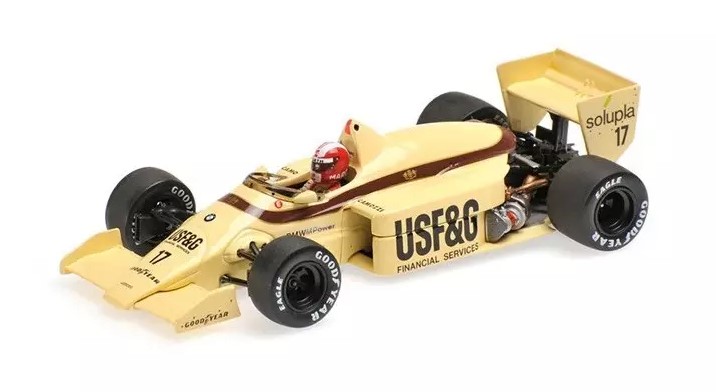 Minichamps: Arrows BMW A8 M.Surer 1986
Minichamps: Arrows BMW A8 M.Surer 1986
For 1986, Surer returned to drive for the Arrows team but the Arrows BMW A8 proved to be a troubled package and Surer failed to score points in his first five races. Due to his love of motor racing, Surer had started rallying in 1984 with a Renault 5 Turbo and on 29th May 1986 he was racing at the ADAC Rallye Hessen in a Group B Ford RS200. While battling with Peugeot's Michelle Mouton for the lead of the rally, Surer lost control and slid off the road into the trees. Surer was dragged from the burning wreck, with burns to his neck and 14 broken bones, his co-driver was trapped inside the remains of the burning car and did not survive. It took over a year for Surer to recover from his injuries but his racing career was over. Marc Surer continues to be involved in motor racing as a commentator on SwissTV and Sky Sports. On a final personal note, Marc has been thrice married; his first two wives were former Playboy models.
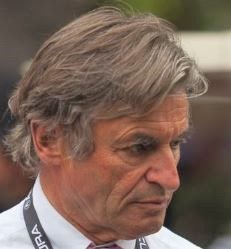 Vale: Alain de Cadenet (27 Nov 1945 - 2 Jul 2022)
Vale: Alain de Cadenet (27 Nov 1945 - 2 Jul 2022)
New Additions: July 2022
Hi and welcome to the July update. Thank you to everyone that stopped by my stall at the Sydney Toy and Hobby Fair at the new Epping venue. I think it was a successful night for both traders and visitors given that it clashed with a major fair in Adelaide. Just a note for those intending to visit in the future; the stalls are spread out over two halls and one room with another overflow room available as required. It can only get bigger and better with your help.
There are a number of new additions this month and here are a few that deserve a special mention. In the mid-1960s, the Tasman series was one of the most important series of races in the world outside of Formula One and a number of F1 drivers and teams headed to Australia/New Zealand during F1's winter break. Jack Brabham had built a customer car, the BT7A based on the F1 BT7 for Frank Matich in the inaugural series in 1964 as well as one to drive himself. The following year, Brabham received additional orders for cars to compete in the series so he built the Brabham BT11A which was similiar to the current F1 BT11, except for a larger 2.5-litre Coventry Climax engine and stronger Hewland HD5 gearbox. The Brabham BT11A won two of the seven races that comprised the series with Jim Clark winning the title in his Lotus Climax 32B. Spark have produced three of the BT11A's that raced in the 1965 series.
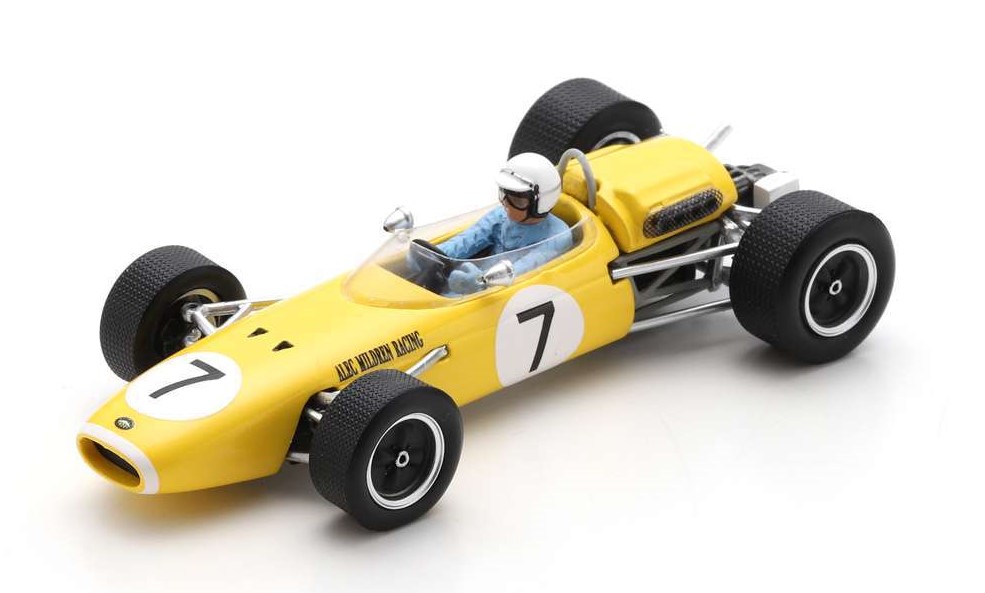 Spark: Brabham BT11 F.Gardner, Levin GP 1965
Spark: Brabham BT11 F.Gardner, Levin GP 1965
The Sunbeam Alpine was a two-seater sports roadster that was produced by the Rootes Group from 1953 to 1955 and then from 1959 to 1968. A six-car works team was set up for the 1953 Alpine Rally (also known by its official name Coupe des Alpes). The Alpine Rally was based in Marseille and although it started and finished in France, the route incorporated famous mountain passes in Austria, Germany, Italy and Switzerland. The rally was very popular during its heyday, in fact the car manufacturer Alpine was named after the event in 1955 and the Sunbeam Alpine also took its name from the rally. Stirling Moss, more famously known as a Formula One driver, was also a competent rally driver and he was one of three drivers to have won the Coupe d'Or (Gold Cup) for three consecutive penalty-free runs on the Alpine Rally. Matrix have produced the Sunbeam Alpine that Moss drove in the 1953 Alpine Rally.
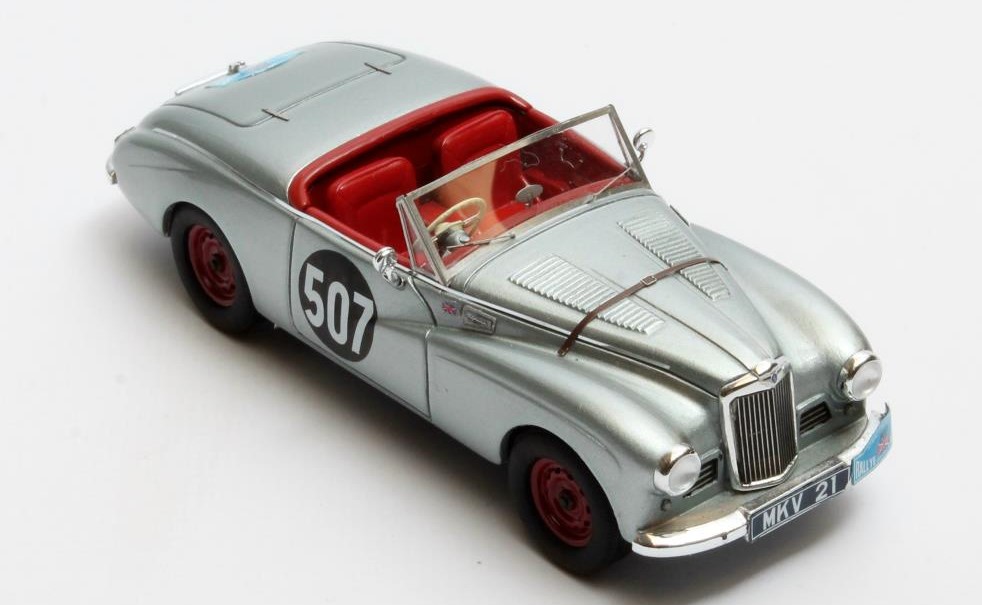 Matrix: Sunbeam Alpine S.Moss 1953 Alpine Rally
Matrix: Sunbeam Alpine S.Moss 1953 Alpine Rally
The Porsche Carrera Cup is undoubtably the world's most popular and successful one-make national and regional racing series using different iterations of the Porsche 911 GT3 car. The series was first held in Australia in 2003 and is currently known commercially as the Porsche Paynter Dixon Carrera Cup Australia. During it's history, NZ driver Craig Baird has been the most successful driver with five series win to his credit. Spark have previously produced the cars of 2016 Champion Matt Campbell and David Wall, the 2017 winner. Joining this list is the car of Jaxon Evan who won in 2018 with six race wins and 10 podiums. Evans is currently a factory Porsche 911 RSR driver competing in the FIA World Endurance Championship.
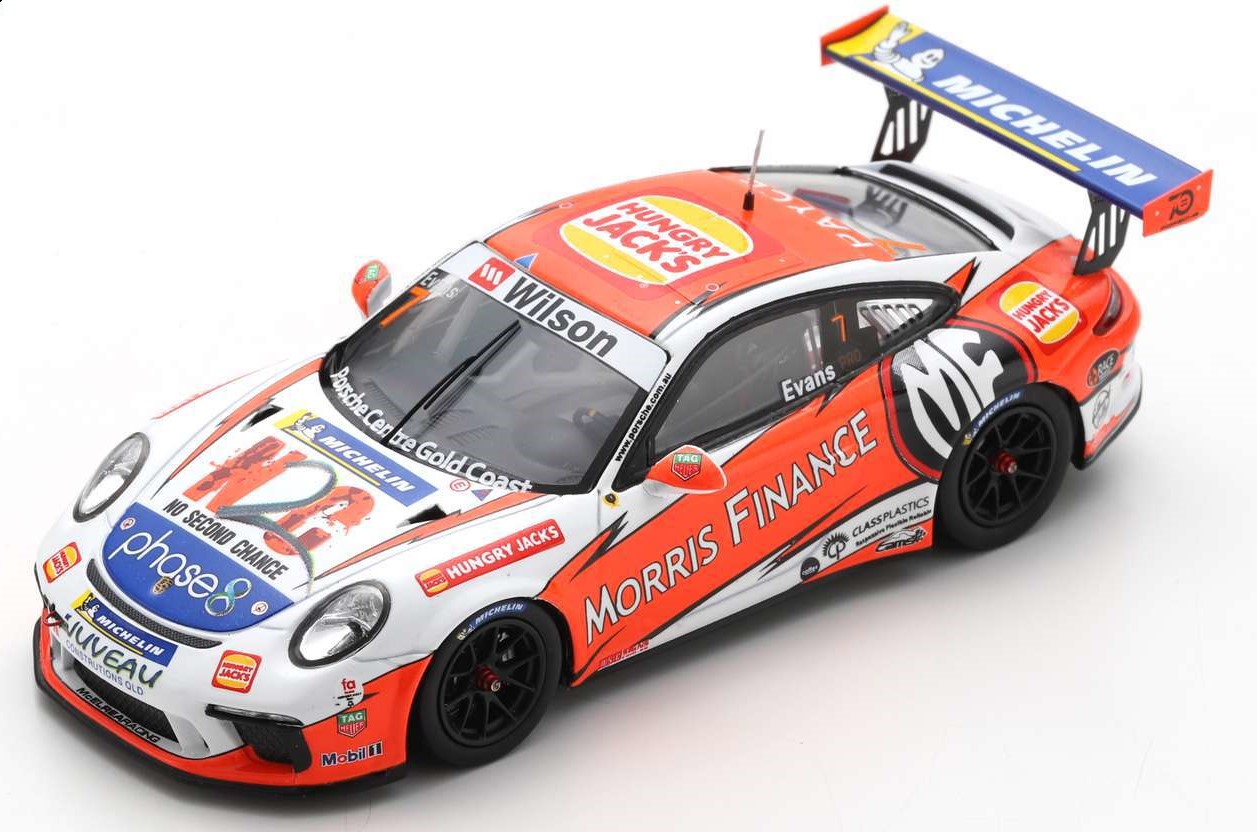 Spark: Australia Porsche Carrera Cup 2018 J.Evans
Spark: Australia Porsche Carrera Cup 2018 J.Evans
Well that's it for another month. The Sydney Toy Fair at Epping will be held on 1 July and the Collector Con event is scheduled for 31 July. Please note the Hunter Toy and Hobby Fair will be held on 7 August at a new venue, see the Swap Meets link for further information. This will be the Hunter Model Auto Club's first event since October 2019. Until next month, happy collecting.
Formula One / Helmets
- 1965 Brabham Climax BT11A, G.Hill (2) 1st NZ GP (Tasman Series) (Spark)
- 1965 Brabham Climax BT11A, F.Gardner (7) 2nd Levin GP (Tasman Series) (Spark)
- 1965 Brabham Climax BT11A, J.Brabham (4) 1st Sandown Park Cup (Tasman) (Spark)
- 1994 Ferrari 412T1, J.Alesi (27) race car (GP Replicas)
- 1990 Lotus Lamborghini 102, J.Herbert (12) Japanese GP (Spark)
- 1976 Parnelli Ford VPJ4B, M.Andretti (27) 6th South African GP (Spark)
- 2020 Helmet - L.Hamilton Turkish GP helmet 1:5 (Spark)
- 2021 Helmet - L.Hamilton Mercedes-AMG helmet 1:5 (Spark)
- 2021 Helmet - L.Norris McLaren F1 helmet 1:5 (Spark)
Australian Race Series
- 2018 Porsche 911 GT3 Cup, J.Evans (7) 1st Australia Carrera Cup (Spark)
- 2020 McLaren 720S GT3, Parente/Barnicoat/Blomqvist (60) 2nd Bathurst 12Hr (Spark)
- 1971 Ford Falcon XY GTHO P3, Moffat (65E) 1st Hardie-Ferodo 500 1:64 (Biante Minicars)
- 1980 Ford XD Falcon, Moffat/Fitzpatrick (1) Bathurst 'Federation' 1:64 (Biante Minicars)
American Race Series
- 1968 Eagle Chevrolet Mk4, M.Donohue (12) Penske Indy Riverside Raceway (Spark)
- 1964 Aston Martin DP214, Hetreed/Kerrison (27) Daytona 2000km (Spark)
- 1982 Ford Mustang Zakspeed Turbo, R.Mears (6) Sears Point "Team Zakspeed Roush" (Spark)
- 2008 Riley Lexus Mk XI, Pruett/Rojas/Franchitti/Montoya (1) 1st Daytona 24H (Spark)
Le Mans / Sports Car Racing
- 1963 Aston Martin DP214, R.Salvadori (46) 1st Coppa Inter-Europa Monza (Spark)
- 2003 Bentley EXP Speed 8, Kristensen/Capello/Smith (7) Le Mans winner (IXO)
- 2020 Ferrari 488 GT3 Evo, Launch version in red (Looksmart)
- 1965 Ford GT40 Mk2, P.Hill/Amon (2) "Shelby American" Le Mans (Spark)
- 1966 Ford GT40, Neerpasch/Ickx (60) Le Mans (Spark)
- 1968 Ford GT40, Salmon/Liddell (12) Le Mans (Spark)
- 1955 Jaguar D-type, Hawthorn/Bueb (6) 1st Le Mans (AUTOart)
- 2019 Porsche 911 GT3 R, M.Campbell (99) 24H Spa "Rowe Racing" (Minichamps)
Rally
- 1953 Sunbeam Alpine, Moss/Cutts (507) Rallye des Alpes (Matrix)
Road Cars
- 1967 BMW 2000 CS in white (Maxichamps)
- 1974 BMW 520 in metallic green (Maxichamps)
- 1980 Fiat Panda in cream white/grey (Maxichamps)
- 1962 Ford Cortina Mk 1 in light green (Maxichamps)
- 1980 Lancia Beta Coupe in silver (Maxichamps)
After Thoughts: "Share and Share Alike." Imagine this ... Max Verstappen drives his Red Bull slowly along pit lane, his car is pushed back into the garage and he climbs from his strickened car. Two laps later, his team mate Sergio Perez is called to "box" for a scheduled stop while in P2, the tyres only take three seconds to change but it takes a little longer for Perez to climb out of the cockpit and for Verstappen to strap himself in. Verstappen rejoins in P6 but with the help of the safety car, manages to overtake several cars until he is in P1 and takes the win. The 25 points for 1st place are split evenly between Verstappen and Perez.. Of course, this winning scenerio could never happen today but it has in fact occurred on three occasions in the past; at the 1951 French, the 1956 Argentine and the 1957 British Grand Prix.
The 1951 French GP was held at Reims-Gueux and was the fourth of eight races in the championship. Alfa Romeo fielded a strong team of 4 drivers and they qualified in P1, 2, 5 and 7 with Juan Manuel Fangio on pole. Ten laps into the race, Fangio's engine began misbehaving and veteran team mate, Luigi Fagioli was ordered to swap cars with Fangio. Problems with the four Ferrari 375's enabled Fangio to fight his way to the lead and to win the race, while Fagioli in Fangio's original, ailing car finished 11th. Incidentally, Alberto Ascari with a broken Ferrari took over the car of Gonzalez and he went on to finish the race, sharing the points for second place with his team mate. However, Luigi Fagioli was so furious over giving up his car to Fangio that he immediately quit Grand Prix racing for good(1). Fangio would go on to win the 1951 Championship by a margin of 6 points from Ascari.
.jpg) Alfa Romeo 159, Fangio 1951 (Photo: L.Coopmans)
Alfa Romeo 159, Fangio 1951 (Photo: L.Coopmans)
In 1956 Fangio was now with Scuderia Ferrari and his first race for his new team was the Argentine GP. With the withdrawal of Mercedes from GP racing following the tragedy at Le Mans the previous year, the grid at Argentina was completely composed of Italian cars, five Ferraris and eight Maseratis. Fangio, in his Ferrari D50 was on pole but Maserati dominated the early race. Fangio's race was hampered with a faulty fuel pump so he took over Luigi Musso's car on lap 29, rejoining in 5th place. As the race progressed, each of the leading cars suffered mechanical issues and Fangio finished unchallenged and shared the points for 1st place with Musso. Fangio would eventually win his 4th World Championship with a margin of 3 points from Stirling Moss.
Stirling Moss, having just missed out on the 1956 Championship, had switched from Maserati to drive for Vanwall in 1957. The British GP was held on 20 July at the Aintree Circuit, near Liverpool with Moss on pole and team mate Tony Brooks in P3. The two Englishmen were split by pre-race favourite Jean Behra (Maserati) with Fangio (Maserati) in P4. Moss led from the start but on lap 21 he pitted to try to fix a stammer in his engine but the misfiring persisted. Eventually the team decided Moss should switch to Brooks' car since Brook was still affected by injuries he'd received in a crash at Le Mans. Moss resumed in 9th but was soon chasing down new leader Behra. The British crowd went wild when Behra coasted to a stop with a broken clutch allowing Moss to take the chequered flag and the shared points with Brooks.
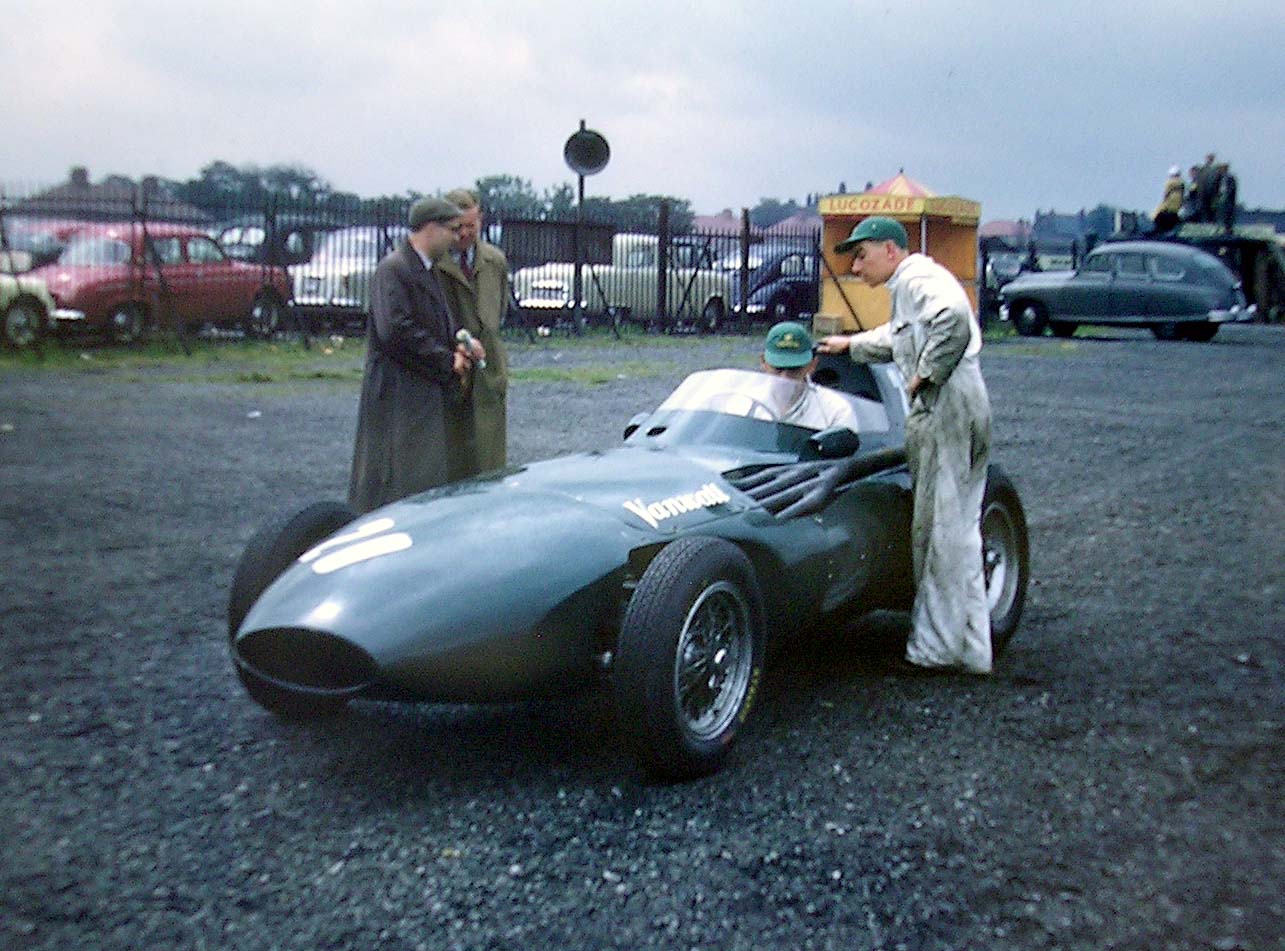 Vanwall VW5 British GP 1957 (Photo: T.Whalebone)
Vanwall VW5 British GP 1957 (Photo: T.Whalebone)
There were many other occasions of shared drives in the 1950's that resulted in shared points; perhaps the most noteworthy was at the 1956 Italian GP where Fangio had an eight point lead over Ferrari team mate Peter Collins. It was the final race of the championship and Fangio had to retire with a broken steering arm. Musso was told to hand over his car to Fangio but refused to do so. Collins sportingly handed his car to Fangio, sacrificing his own chance at the title and Fangio finished second, scoring enough shared points to take the Championship. In 1958(2) the governing body tried to discouraged the practice of sharing cars by announcing that points would no longer be awarded to the drivers. The last time a shared drive occurred was at the 1964 USA GP when Jim Clark and Mike Spence shared a Lotus to finish 7th(3). It is unknown when the sharing of cars was finally banned (or has it?).
Note (1): His shared win with Fangio was to be Fagioli's only win which also put him in the record book as the oldest ever GP winner at 53 years old and the only GP winner to be born in the 19th Century.
Note (2): Unverified
Note (3): Clark could not score points but hoped that he could take them away from his rivals.
New Additions: June 2022
Hi and welcome to the June update. If you haven't heard already, then let me be the bearer of glad tidings; Granville is dead, long live Epping! As the school at Granville was no longer hiring out their school hall, the Sydney Model Auto Club went looking for another venue for their long-running, popular fair and they found one at the Epping Creative Centre, 26 Stanley Road, Epping. Their monthly model fairs will now be held on the first Friday of every month, starting on 3 June. Please see the Swap link for further details. There's plenty of off-street parking behind the venue.
There aren't many new additions this month but the highlights are ...
In 2019, the Swiss Rebellion Racing team entered two cars in the Le Mans 24 Hour endurance race. Both their LMP1 cars sported very colour livieries and during the traditional Drivers' Parade, the team decided their parade cars should have similiar coloured schemes. They used a Mercedes-Benz 600 and Cadillac Eldorado to carry their six drivers through the town. These two models from Spark would display nicely next to the race cars which finished 4th and 5th.
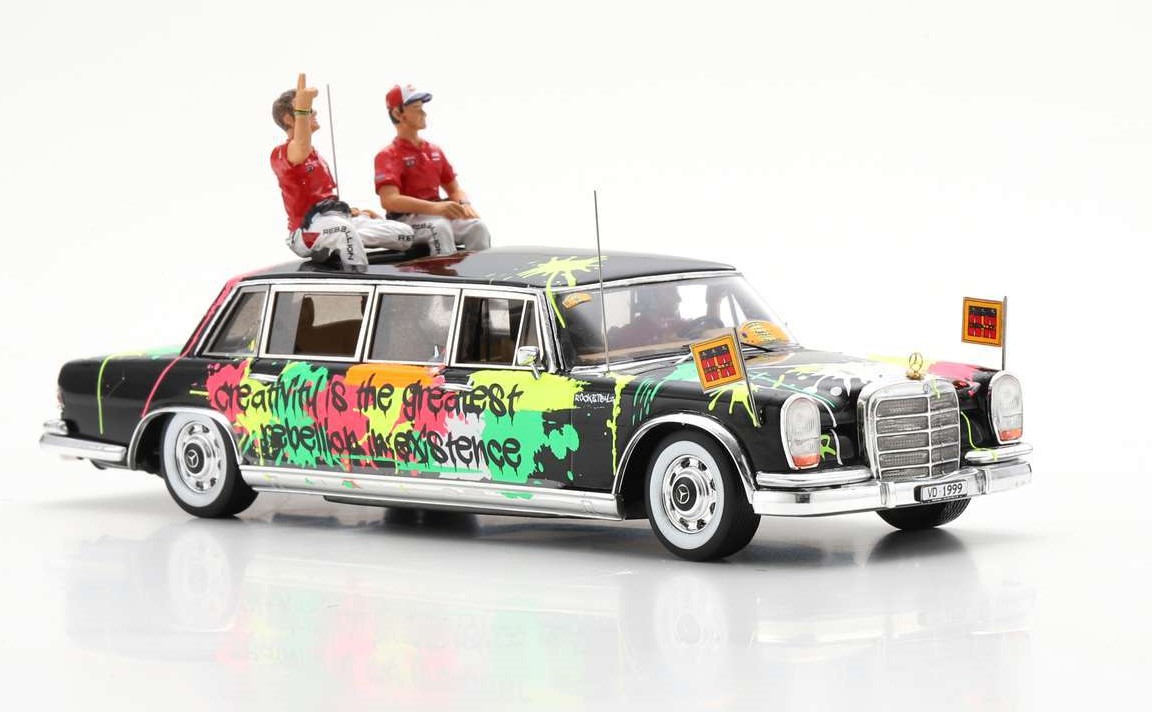 Spark: Mercedes_Benz 600 Drivers Parade Car
Spark: Mercedes_Benz 600 Drivers Parade Car
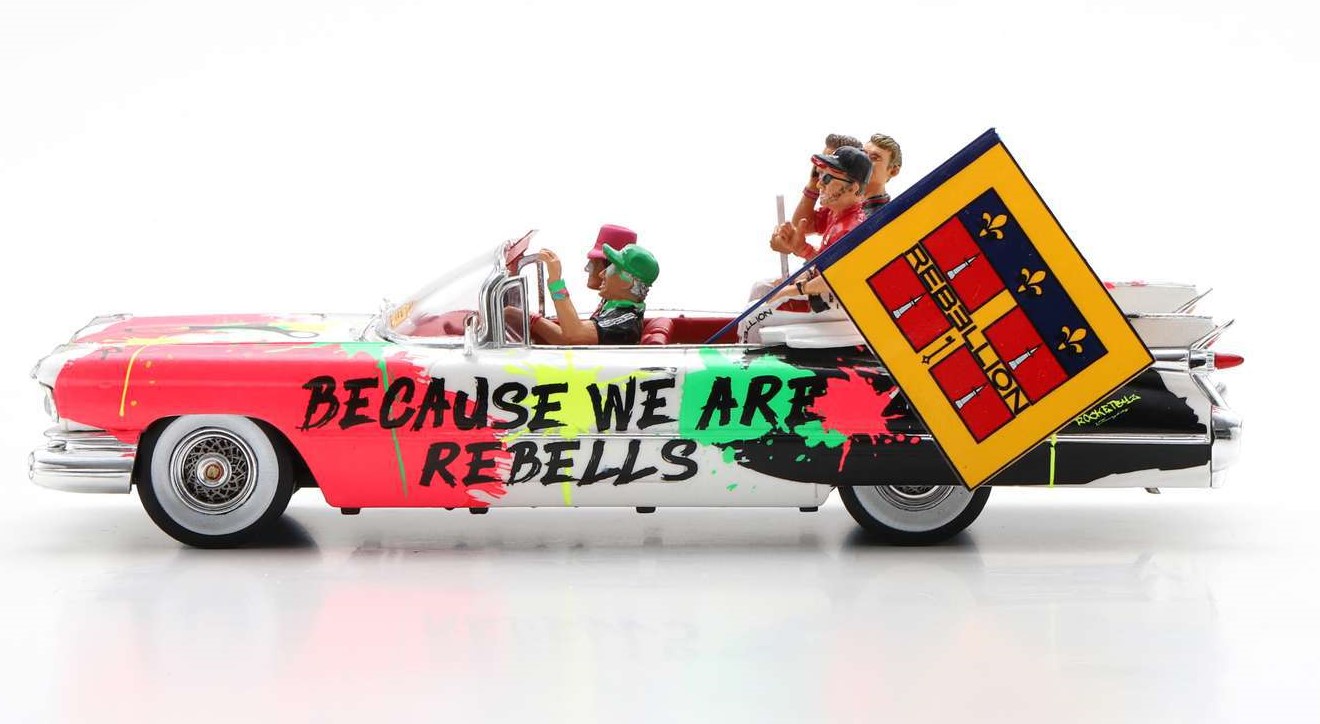 Spark: Cadillac Eldorado Drivers Parade Car
Spark: Cadillac Eldorado Drivers Parade Car
During the month, I also acquired a number of Johnny Lightning and Matchbox cars, too many to list individually so check these out in the Misc Scales stocklist. The Hunter Model Auto Club have announced the recommencement of their annual model fair, scheduled for 7 August from 10am to 2pm. The new venue is the Edgeworth Sport and Recreation Club, 1A Park Street, Edgeworth 2285. Finally, just another reminder of the Epping Model Fair on 3 June, I hope to see you there. OK, that's it for this month, until next time, happy collecting.
Formula One
- 1983 Arrows Ford A6, M.Surer (29) French GP (Spark)
- 2021 McLaren Mercedes MCL35M, D.Ricciardo (3) 1st Italian GP (Spark)
- 2021 Red Bull Honda RB16B, Verstappen (33) 2nd Turkey GP (Spark)
- 2021 Red Bull Honda RB16B, Verstappen (33) 1st Abu Dhabi GP (Spark)
Le Mans / Sportscars
- 1975 Mirage Ford GR7, Ganley/Schenken (4) 2nd Nurburgring 1000Km (Spark)
- 2019 Rebellion Cadillac Eldorado, Rebellion LM Drivers Parade - Car 3 (Spark)
- 2019 Rebellion Mercedes Benz 600, Rebellion Racing LM Drivers Parade - Car 1 (Spark)
American Racing Series
- 1957 Renault Dauphine, Frere/Lucas (66) Sebring 12H (Spark)
Road Cars
- 1980 Alfa Romeo GTV 2.0 in silver (Spark)
1:18 Models
- 2020 Alpha Tauri Honda AT01, P.Gasly (10) 1st Italian GP (Spark)
- 2020 Mercedes AMG W11, L.Hamilton (44) Turkish GP with pit board (Spark)
- 2020 Ferrari SF1000, C.Leclerc (16) Tuscan GP (1000th Ferrari Race) (Looksmart)
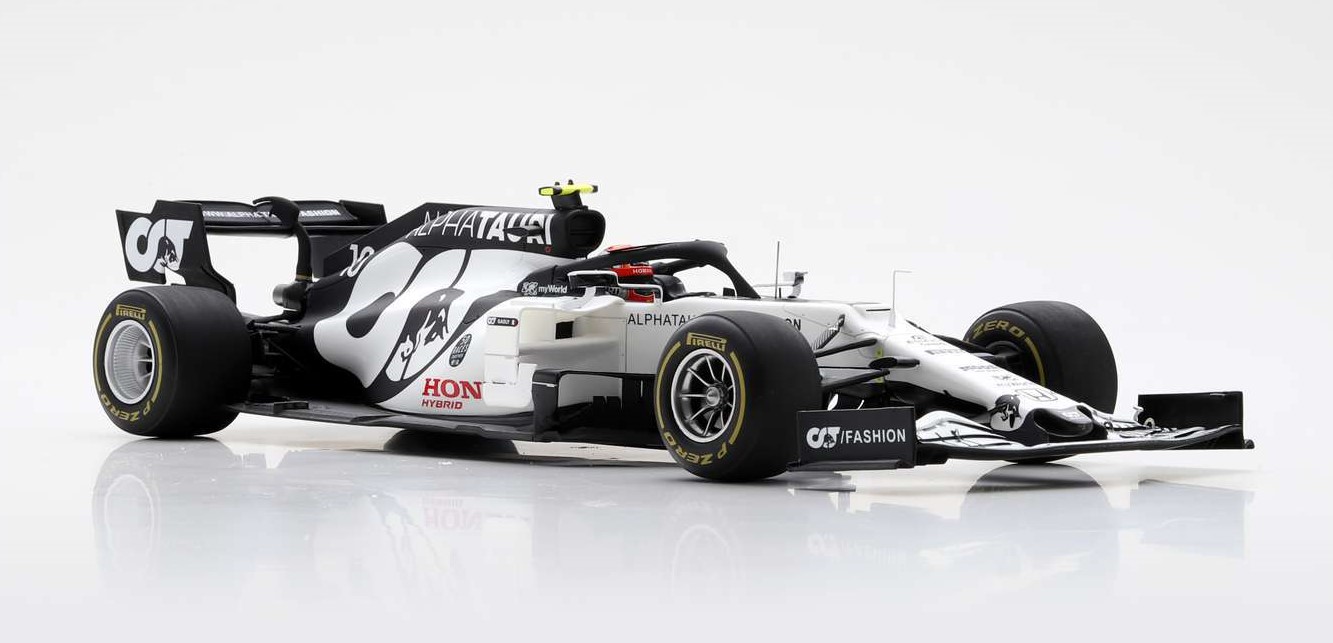 Spark: Gasly's Alpha Tauri in 1:18 scale
Spark: Gasly's Alpha Tauri in 1:18 scale
After Thoughts: "Ten Years ... and Counting." This is one anniversary that no Formula One team wants to acknowledge and certainly not by a team with such an illustrious history as Williams Grand Prix Engineering. It has now been ten long years since Williams last won a Grand Prix. Formed in 1977 by Frank Williams and Patrick Head, the team has won nine Constructors' and seven Drivers' championships as well as 114 Grand Prix but their fortunes have since plummeted. This is an opportune time to revisit that last GP win.
The scene ten years ago was the Spanish Grand Prix at the Barcelona Circuit held on 13 May 2012 and the Williams team arrived with two Williams Renault FW34 for Brazilian, Bruno Senna and Venezuelan, Pastor Maldonado. Senna was in his third and final year in Formula One while Maldonado was enjoying his second year in the top category after winning the GP2 Championship.
After a disappointing two years running with the uncompetitive Cosworth CA2011K power unit, the Williams team was optimistic for 2012 with Renault power. The team was hoping for consistent top-10 finishes, even a few top-5 and in fact, leading up to the Spanish GP, the team did score 3 top-10 finishes. The mood was buoyant, Frank Williams had celebrated his 70th birthday less than a month before and coming to Barcelona, the FW34 was due for a substantial aerodynamic upgrade, but the new aero package was late, arriving only on Saturday morning of the race weekend. It was a big package; new floor, sidepods, suspension and front wing. Normally in F1, it's very unusual for every upgrade to work together immediately, but Maldonado knew right away the team had produced something good. He immediately noticed the extra downforce and the car was nicely balanced; pole position was a definite possibility. But Maldonado's lap time was only good enough for P2, however polesitter Lewis Hamilton (McLaren) was disqualified when he ran out of fuel on his in-lap so Pastor was promoted to P1 and Fernando Alonso (Ferrari) to P2.
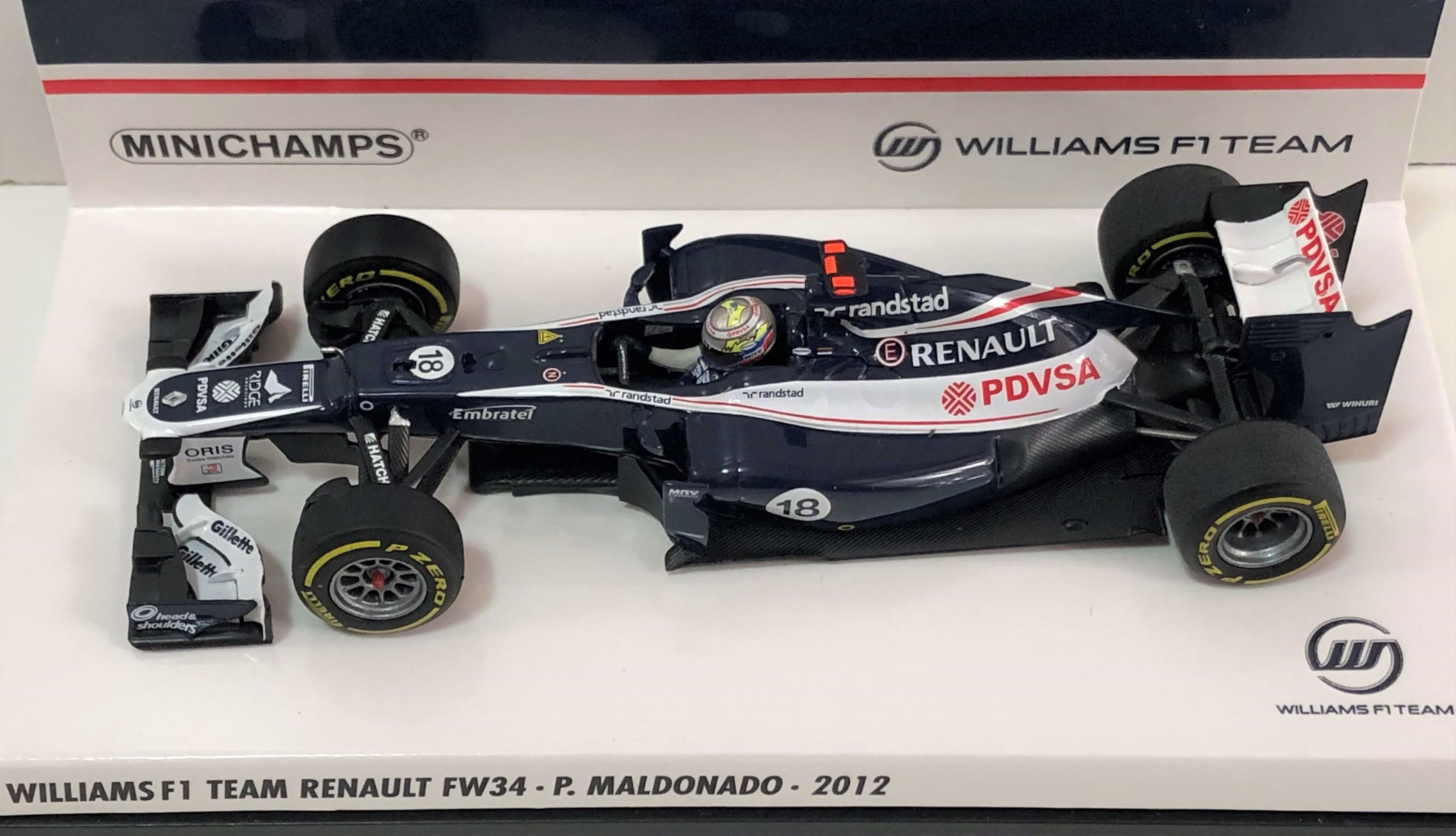 Minichamps: Williams Renault FW34
Minichamps: Williams Renault FW34
At the start of the race, the 82,000 strong Spanish crowd were cheering loudly for their hero Alonso, and even more so when he passed Maldonado on the inside line on the run into Turn 1. Undetered, Maldonado kept close to the Spaniard and on lap 25 the team from Grove triggered the undercut, sending Maldonado out into clear air to push hard on fresh Pirelli tyres. Meanwhile, a frustrated Alonso was struggling to clear the backmarkers until Ferrari called him to the pits two laps later but it was too late, P1 belonged to Maldonado when Raikkonen (Lotus) pitted a few laps later. Maldonado created a seven-second gap to Alonso right through to the 3rd pitstop. In a heart-in-mouth moment during the third and final stop, Maldonado's left front wheel was slow to go on and he lost time to Alonso. Then out on track, the freshly-shod Williams caught up with Raikkonen in P1 who wasn't looking to pit anytime soon and the Lotus was slowing Maldonado down, allowing Alonso to catch up. Maldonado knew if he wanted to win his first GP, then he had to be assertive so with the Ferrari closing in fast, Maldonado pounced on Raikkonen. With the help of DRS (introduced in 2011), he closed in on Raikkonen and shot past in the Turn 1 braking zone to reclaim the lead and the race win. Against a field of star-studded drivers, including world champions Schumacher, Hamilton, Alonso, Vettel and Raikkonen, the unheralded Maldonado emerged victorious. For Williams, it ended a victory drought stretching back to Brazil 2004 but who would have foreseen that ten years later, they would still be waiting for their next.
.jpg) Vale: Tony Brooks (25 Feb 1932 - 3 May 2022)
Vale: Tony Brooks (25 Feb 1932 - 3 May 2022)
Breaking News 10 May: New Venue for Sydney Toy and Hobby Fair
After a Covid induced hiatus of over two years, the Sydney Toy and Hobby Fair will be restarting on 3 June 2022. Hosted by the Sydney Model Auto Club, the Fair had been held in a school hall in the suburb of Granville for many years but the venue was no long available for hire. A new venue has been found at the Epping Creative Centre, 26 Stanley Road, Epping and will be held on the 1st Friday of every month, starting on 3 June. See Swap link for further details. Please spread the word to your follow collectors.
New Additions: May 2022
Hi and welcome to the May update. Firstly some changes to the website; previously I had appended Rally and Land Speed Record cars to the end of the "1:43 Le Mans Car" stocklist but I've now created a separate stocklist "1:43 Rally and LSR Cars" where you can now find these cars. The number of Rally and LSR cars in stock has grown to the extent they now warrant their own separate and logical entry.
Now to some Covid news; daily infection rates in NSW are bouncing around between 7 to 20K and life seems to be getting back to normal as we learn to "live" with the virus. As reported last month, Covid has caused the permanent cancellation of the Sydney Model Auto Club (SMAC) model fair at Granville which had become an iconic event over the decades. At the last club meeting there was much discussion about the future format of the model fair; whether it should continue as a regular monthly event or just held a few times a year. Ideally, the club would like to run a regular monthly event but a suitable venue needs to be found. I've searched for a venue myself and it's not as simple as some might like to think. The new venue needs to tick a number of boxes; ample off and on-street parking, availability of tables, central location within Sydney, available on same day every month, size and cost, just to list a few. Any suggestions should be directed to the president of the club (dennis.mitchell@live.com.au).
There are a number of new additions this month and here are the models that deserve a special mention. If there was ever a prize for the ugliest Formula One car, then the Ensign N179 that practiced at the 1979 South African GP would be a strong contender. The N179 was equipped with a new system of radiators stacked on the nose of the car that allowed wing-shaped tunnels to be located on either side of the cockpit for additional downforce. The awkward looking radiators led to the nicknames "step ladder" and "cheese grater" being given to the car. The N179 made its first appearance at the South African GP where Derek Daly failed to qualify. The stack of radiators proved to be an inefficient design and were eventually moved back to the side-pods. Spark has produced this historically significant but really ugly car.
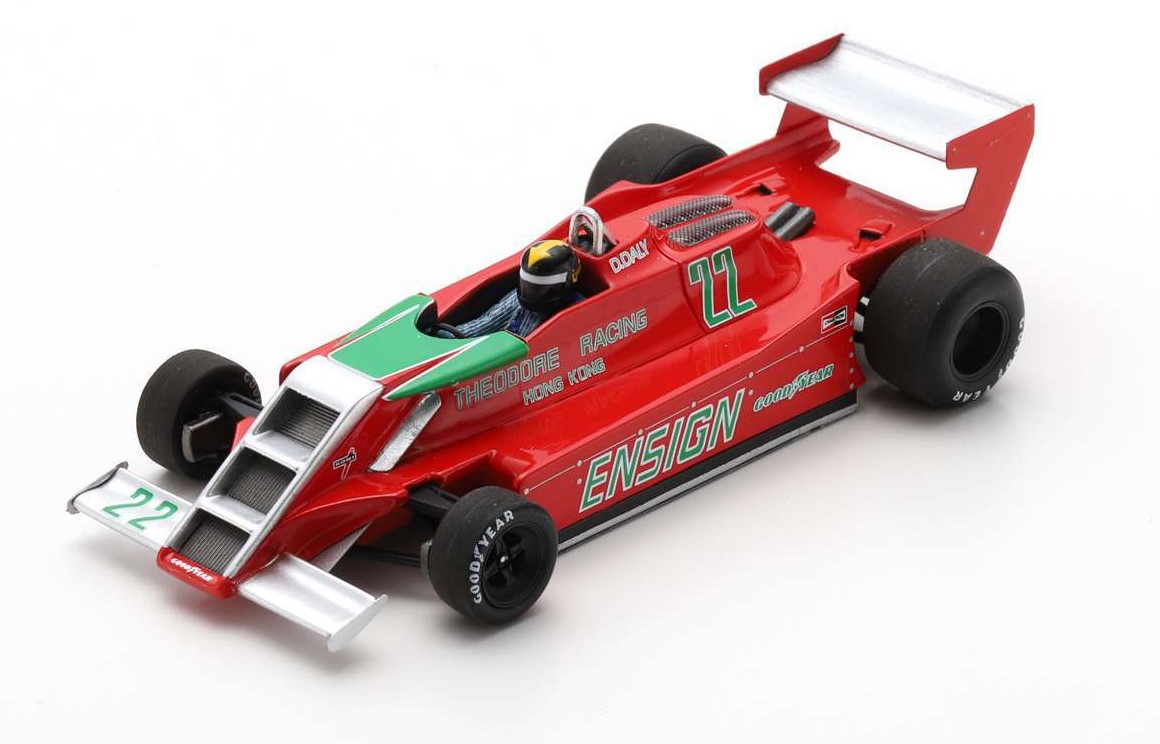 Spark: Ensign Ford N179, 1979 South African GP
Spark: Ensign Ford N179, 1979 South African GP
Mexican Hector Rebaque ran his own F1 team in 1978 and '79, mostly running customer Lotus cars. For the 1979 season, Rebaque drove the Lotus 79 but usually qualified at the rear of the grid and sometimes missing the cut. For the last three races of the season, he fielded his own car designed by Penske Racing which he called the Rebaque HR100. It was essentially a Lotus 79 copy with parts interchangeable between the two cars. Rebaque did not qualify the car in Italy or the United States but lined up 22nd for the Canadian GP, eventually retiring from last place. The Rebaque team folded at the end of the year. Another historically significant but ultimately unsuccessful car, again modelled by Spark.
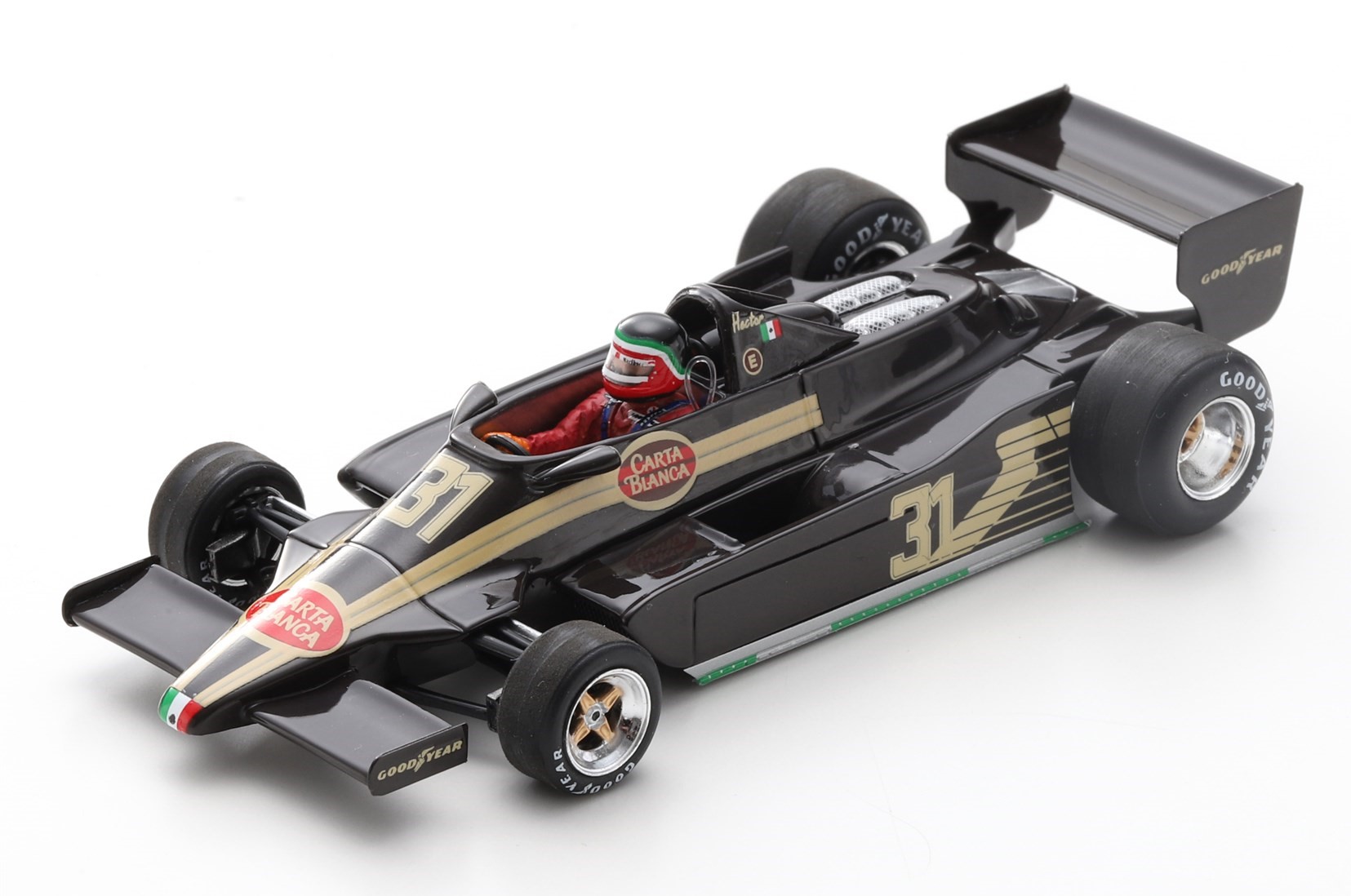 Spark: Rebaque Ford HR100 1979 Canadian GP
Spark: Rebaque Ford HR100 1979 Canadian GP
A number of Australians have competed in Formula One over the years starting with Tony Gaze back in 1952. Larry Clifton Perkins was another who made it to the top tier of motor racing in the 1970's making his first appearance at the 1974 German GP for Chris Amon Racing. Perkins raced for the Boro F1 team in 1976 but when the money ran out he finished the last three races of the season with the Brabham Alfa team. He finished 17th at the Canadian GP. Spark's model of Larry's Brabham Alfa BT45 will be much sought-after by collectors with an interest in Australian F1 drivers.
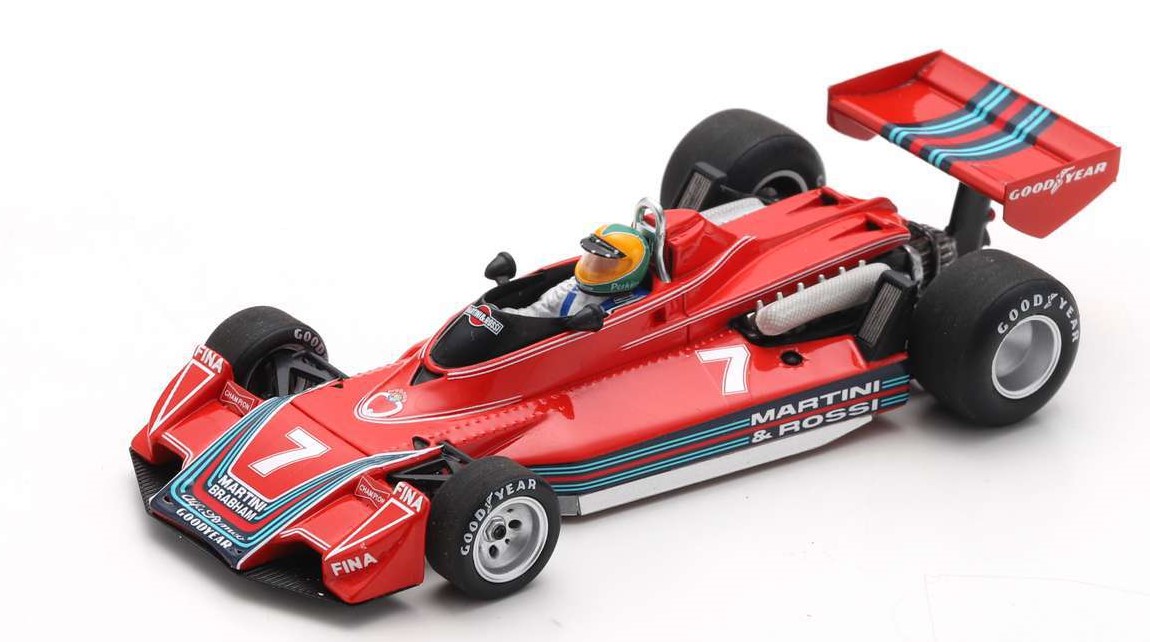 Spark: Brabham BT45 Larry Perkins 1976
Spark: Brabham BT45 Larry Perkins 1976
OK, that about wraps it up for another month. There are a couple of Sydney collectables fairs in May; the Collector Con Toy and Hobby Fair at Campbelltown (see Swap Meets link for details) on 29 May and the Penrith Collectables Fair at the Glenmore Park Community Centre on 22 May. I will not be attending either of these shows. I believe both shows are a bit light on model cars but worth a visit if you have nothing else to do. Also, the All British Day is now confirmed for 11 September. Until next month, happy collecting.
Formula One / Helmet
- 2021 Alpine Renault A521, F.Alonso (14) Bahrain GP (Spark)
- 2021 Aston Martin Mercedes AMR21, S.Vettel (5) Bahrain GP (Spark)
- 1976 Brabham Alfa BT45, L.Perkins (7) Canadian GP (Spark)
- 1972 BRM P180, H.Ganley (19) Monaco GP (Spark)
- 1979 Ensign Ford N179, D.Daley (22) Practice South African GP (Spark)
- 1975 Lotus Ford 72F, B.Henton (6) US GP "JPS" (Spark)
- 1971 March Ford 711, M.Beuttler (19) Canadian GP (Spark)
- 1978 McLaren Ford M23, N.Piquet (29) Austrian GP (Spark)
- 1979 Rebaque Ford HR100, H.Rebaque (31) Canadian GP (Spark)
- 2020 Lando Norris - McLaren F1 British GP helmet 1:5 (Spark)
American Racing Series
- 1971 Porsche 914/6 GT, Gregg/Haywood (59) 1st V.I.R IMSA (Spark)
Le Mans
- 2020 Aston Martin Vantage AMR, Lynn/Martin/Tincknell (97) 1st LMGTE Le Mans (Spark)
- 2005 Audi R8, Lehto/Werner/Kristensen (3) Le Mans winner (Spark)
- 1987 Porsche 962C, Bell/Stuck/Holbert (17) 1st Le Mans (Spark)
- 2019 Rebellion Gibson R13, Jani/Lotterer/Senna (1) 4th Le Mans (Spark)
- 2019 Rebellion Gibson R13, Laurent/Menezes/Berthon (3) 5th Le Mans (Spark)
- 1986 Rondeau Ford M383, Justice/Oudet (45) DNF Le Mans (Spark)
Misc. Scale (1:64)
- 2019 McLaren 720S GT3, Presentation car (Spark)
- 1983 Porsche 956, Wollek/Ludwig/Johansson (8) 6th Le Mans (Spark)
- 1984 Porsche 956, Hobbs/Streiff/van der Merwe (33) 3rd Le Mans (Spark)
- 1985 Porsche 956, Palmer/Weaver/Lloyd (14) 2nd Le Mans (Spark)
1:18 Scale
- 1969 BMW 2500, "New Horizon" Pink Panther Art Car (by H.Meyer) (Minichamps)
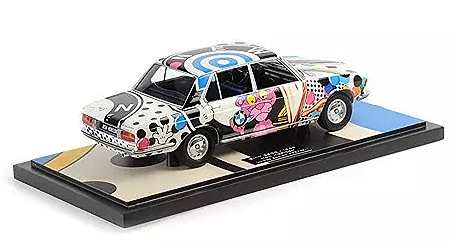 Minichamps: BMW 2500 Pink Panther Art Car
Minichamps: BMW 2500 Pink Panther Art Car
After Thoughts: "The Forgotten F1 Circuits Series #3 - Bremgarten, Switzerland." You could be forgiven for not having heard of the Swiss F1 Grand Prix, given that the last edition on home soil(1) was held back in 1954.
The Circuit Bremgarten, located in the Bremgarten Forest north of Bern was a 7.28 km track built in 1931 for motorcycle racing. It was a fast stretch made up of public roads that went through the picturesque countryside and forest, sweeping from corner to corner without any real straights. It was acknowledged to be a very dangerous circuit with its tree-lined roads and changes in road conditions especially after rain.
 Circuit Bremgarten used in 1934-39, 1947-54 (Lispir)
Circuit Bremgarten used in 1934-39, 1947-54 (Lispir)
The circuit hosted the first Swiss Grand Prix for cars in 1934, a non-championship race with Hans Stuck winning in an Auto Union and underlining the hazards of the track, a Maserati driver was killed in a horrific accident. The Swiss GP counted towards the European Drivers' Championship from 1935 to 1939. During this period, the GP was dominated by German cars with Auto Union winning once and Mercedes winning four times. The racing returned in 1947 and in 1950 the Swiss GP became part of the new Formula One World Championship. After the war, it was Italian cars which dominated the racing at Bremgarten, with Alfa Romeo winning four races with Ferrari winning three races. Mercedes scored a single victory in 1954 before the Swiss GP was unexpectedly cancelled.
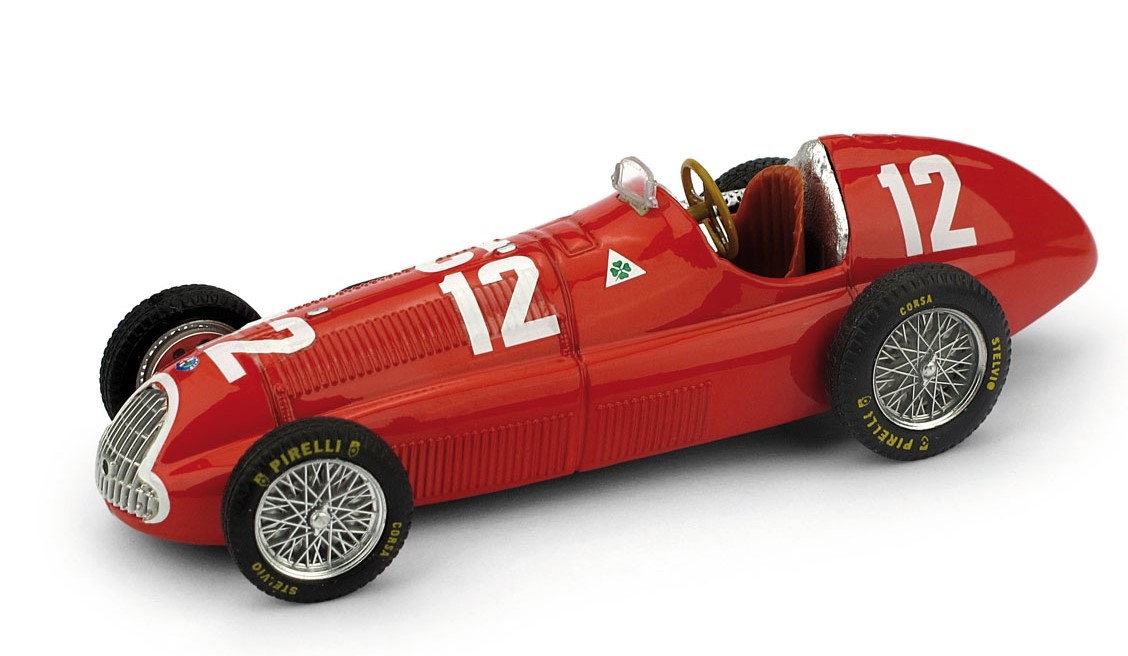 Brumm: Alfa Romeo, 2nd place Swiss GP 1950
Brumm: Alfa Romeo, 2nd place Swiss GP 1950
On 11 June 1955, 83 spectators died when Pierre Levegh's Mercedes 300SLR flew into the tightly packed crowd watching the Le Mans 24 hours endurance race. The Swiss government declared circuit motor racing to be an unsafe sport and promptly banned the Swiss Grand Prix that year(2). The Bremgarten circuit was ultimately abandoned and was never used again for motor racing.
Note (1): The Swiss GP was "revived" in 1975 as a non-championship F1 race but was held in neighbouring France at the Dijon_Prenois circuit. The next Swiss GP was held in 1982, an official around of the Championship but again, it was held at Dijon-Prenois and was the last running of the event to date.
Note (2): Only in 2015 did the Swiss government relax the law banning motorsport road racing but only for electric vehicles. In 2018 Switzerland hosted its first motor race in 63 years when the first Zurich ePrix was held as a round of the all-electric Fornula E championship.
 Vale: Vic Elford (10 June 1935 - 13 March 2022)
Vale: Vic Elford (10 June 1935 - 13 March 2022)
New Additions: April 2022
Hi and welcome to the April update. Firstly, I'd like to thank all those who stopped by my stall at the Collector Con Fair on 27 March, I hope everyone enjoyed the day despite the terrible weather and the lack of parking. The organisers have some plans to address the parking issue for the next fair on 31 July. Now for some Covid-related news; daily infection rates in NSW seem to be hovering between 20 to 25K and there are almost no restrictions in place (except mask wearing on public transport). Despite this, I have heard directly from the Sydney Model Auto Club, that their monthly Friday night Granville fair will no longer be held at the school hall. The school authorities have said the club will not be allowed back, presumably due to Covid issues. The club will be appealing this decision but it's very doubtful this will succeed so the club has started to look for another venue. I will keep you posted but if you have any suggestions for a possible venue, please contact the club at sydneymodelautoclub@hotmail.com or via their Facebook page.
There's only a few new additions this month but here are my highlights:
The Carrera Panamericana was a rally event held on open roads in Mexico from 1950 to 1954 and was described as the most dangerous race of any type in the world. It's cancellation after the 1954 race was due to safety concerns after 27 people had died during the five years of the race. The cars of that period were of a high-speed, low-safety design and it was almost impossible to provide medical assistance over the long stage sections with serious crashes often going unnoticed for hours. In 1988, the race was revived as a stage rally on closed public highways over seven days. The cars are organised into 10 classes, which are differentiated by car age and authenticity so virtually any car with a classic bodyshell is eligible. The bulk of the entries are 1950's and 60's American stock cars; the most popular being the 1953/54 Studebakers. In 1999, Pierre de Thoisy in a Studebaker Coupe with 500bhp under the bonnet won the event. Unfortunately, the dangers of the past continued to haunt the event; two spectators and two competitors were killed that year. Spark has reproduced the bright yellow winning Studebaker from 1999.
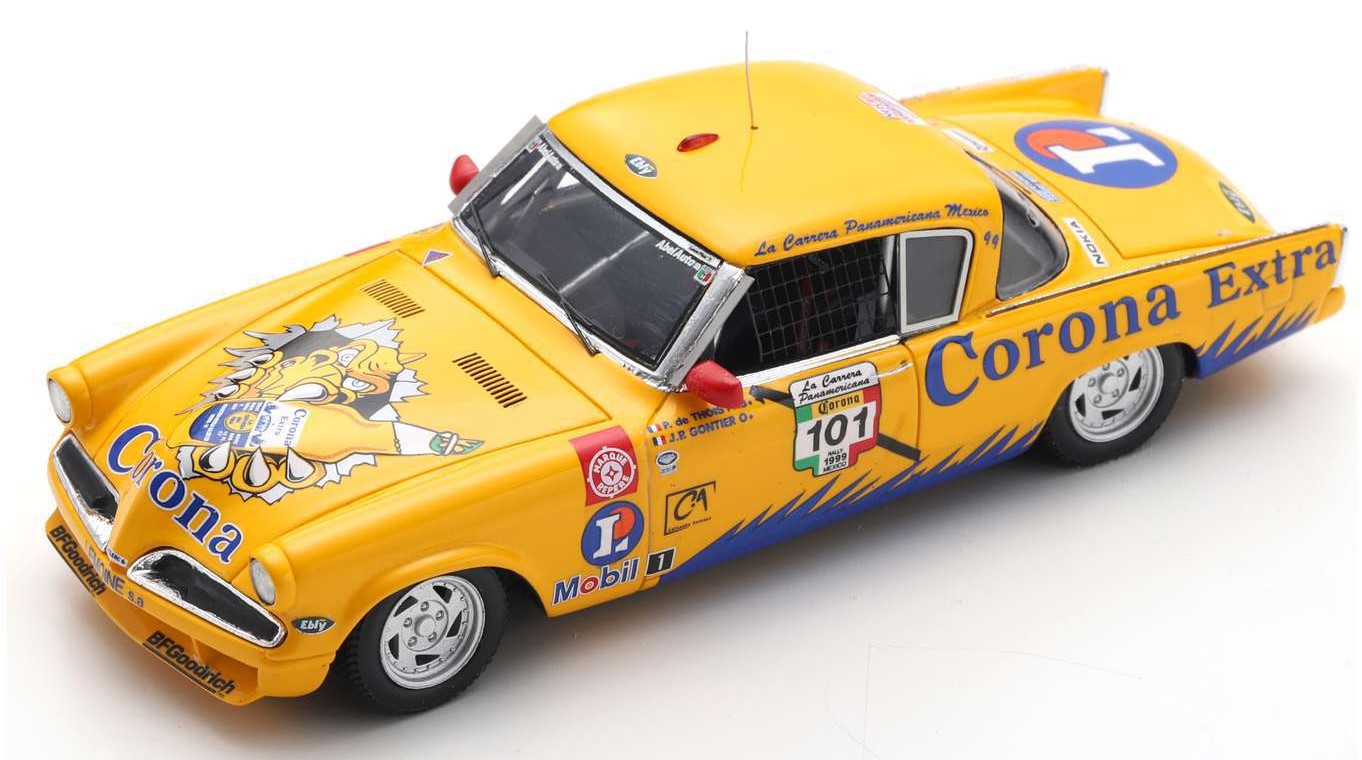 Spark: Studebaker, 1st 1999 Carrera Panamericana
Spark: Studebaker, 1st 1999 Carrera Panamericana
The Citroen DS was one of the most revolutionary cars ever made. Launched in 1955 it continued to evolve until it stopped production in 1975. Its final evolution came in 1973 with the DS23. The DS may appear an unlikely racing car, it seemed like it was too big, too heavy, not fast enough, too complicated and unreliable but they proved to be excellent competitors especially when the going got rough. As a rally car, the DS excelled on poor terrain, beating more credentialled opponents and thereby proving the car was robust and reliable. The DS' first outing was in the Monte Carlo Rally in 1956 and achieved a first in its class. Spark has released two DS23's that participated in the Paris-Dakar Rally in 1980 (car #112) and '81 (car #145).
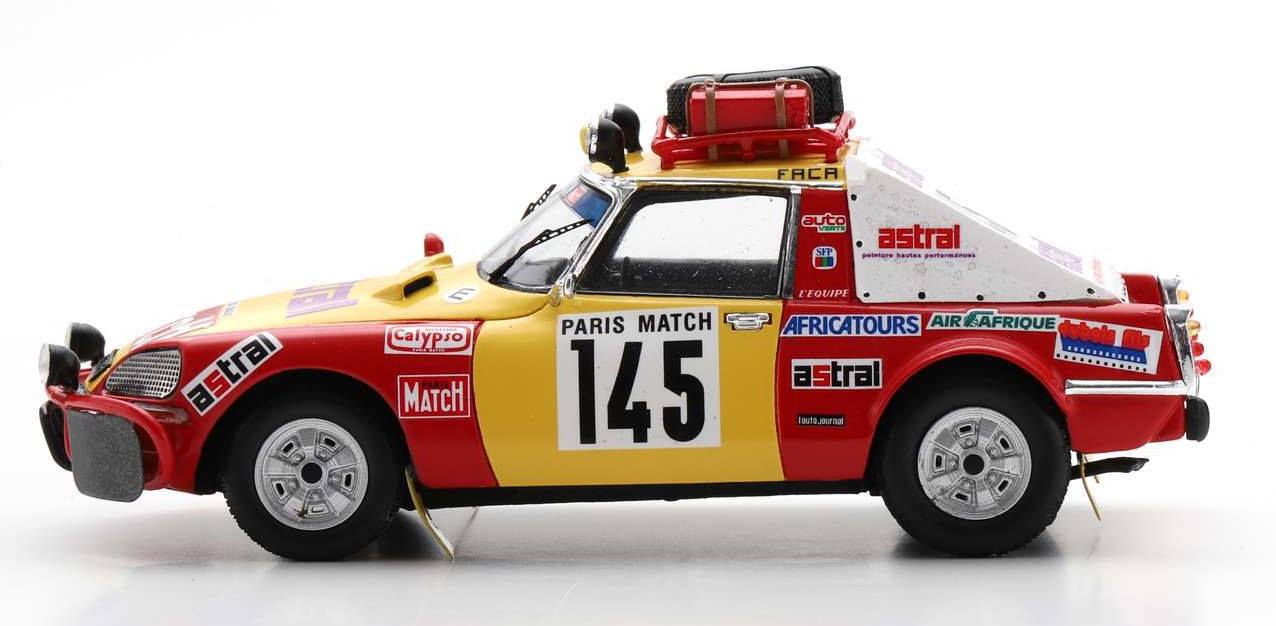 Spark: Citroen DS Paris-Dakar rally cars
Spark: Citroen DS Paris-Dakar rally cars
OK, that's it for another month. April will be another barren time for model swapmeets with the next confirmed show being the Collector Con Fair on 29 May at Campbelltown, which I will not be attending. Good news is the Shannon's Classic Car Show will be held on 14 August. Just another reminder that you can order your model cars by sending me an email to info@f1scalemodels.com. I hope to see you soon, until then happy collecting.
Formula One
- 1967 Cooper Maserati T86, J.Rindt (11) DNF British GP (Spark)
- 1991 Lotus Judd 102B, Hakkinen (11) Australian GP (Spark)
- 2020 Renault R.S.20, E.Ocon (31) Sakhir GP (Spark)
Le Mans / Sports Cars / Rally
- 1965 Ford GT40 Mk2, Miles/McLaren (1) Le Mans (Spark)
- 1971 Porsche 917 LH, Larrousse/Elford (21) Le Mans (Spark)
- 1971 Porsche 908/03, Larrousse/Elford (8) Targa Florio (Spark)
- 2020 Toyota TS050 Hybrid LMP1, Buemi/Hartley/Nakajima (8) 1st Le Mans (Spark)
- 1980 Citroen DS23, Delles/Lamy/Biron (112) Paris Dakar (Spark)
- 1981 Citroen DS23, Ronci/Quenti/Darmendrail (145) Paris Dakar (Spark)
American Race Series
- 1964 Aston Martin DP214, Salvadori/Salmon (26) Daytona 2000k (Spark)
- 1999 Studebaker Champion, de Thoisy/Gontier (101) 1st Carrera Panamericana (Spark)
1:18 Scale
- 1976 Ligier Matra JS5, J.Laffite (26) 4th place Long Beach GP (Spark)
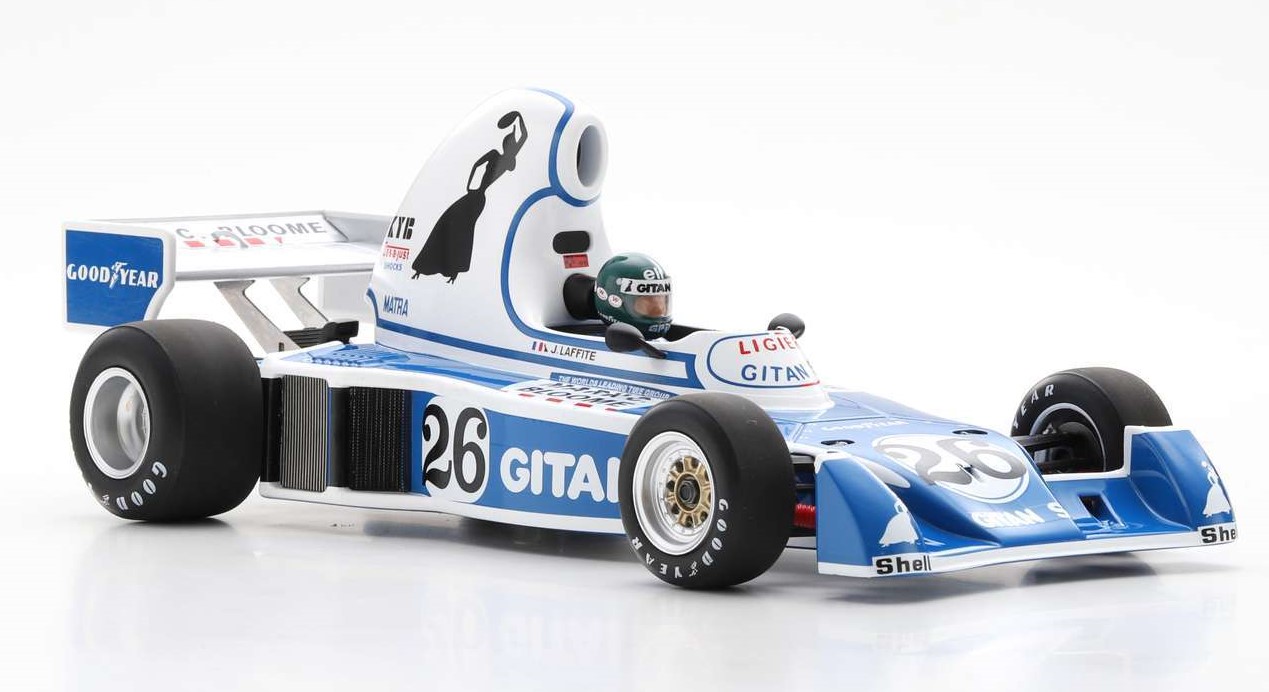 Spark: Ligier JS5 Long Beach 1:18
Spark: Ligier JS5 Long Beach 1:18
After Thoughts: "The Great Designers - Aldo Costa." Aldo Costa is a name that may not be immediately familiar to fans of F1 but probably should be. Why? Because he has won more world titles than any other designer in history - 26 in total.
Costa was born in Parma, Italy on 16 June 1961. After graduating with a degree in mechanical engineering from the University of Bologna, he joined Abarth, part of the FIAT group. But he soon moved to Minardi F1 in 1988 focusing on suspension design, eventually becoming chief designer and then technical director of the team. Upon his arrival at Minardi the team consisted of a total of just 32 people but had grown to 120 by the end of his seven years at the team. During his time at Minardi, Costa's achievements included a 2nd place qualifying position at the 1990 US GP and 4th place finish at Imola in 1991. Aldo then joined Ferrari in 1996 with great expectations.
Ferrari 1996 - 2011
When Costa arrived at Maranello his first task was to develop the Ferrari F50 road car for Le Mans. A few months later he joined the F1 program where he found a staff of just four in the chassis design office. At this time, all the design work was being done by John Barnard and his group in England but Ferrari were in the process of bringing that work back in-house. Costa was not the only new signing that year, a driver named Michael Schumacher also joined the Scuderia. Costa initially worked with Ross Brawn and Rory Byrne, with Costa taking over as technical director in 2006 after Byrne's retirement. During his time at Ferrari, Costa was involved with the design of eight championship winning cars that won eight Constructors and six Drivers Championships (5 for Schumacher, 1 for Raikkonen). The decline of Ferrari's fortune began after 2008 and after a very bad start to the 2011 season, Costa was removed as technical director and given a lesser role within Ferrari. In July 2011, Ferrari announced that Costa would leave the team and by September, Costa would be joining the Mercedes F1 team as Engineering Director.
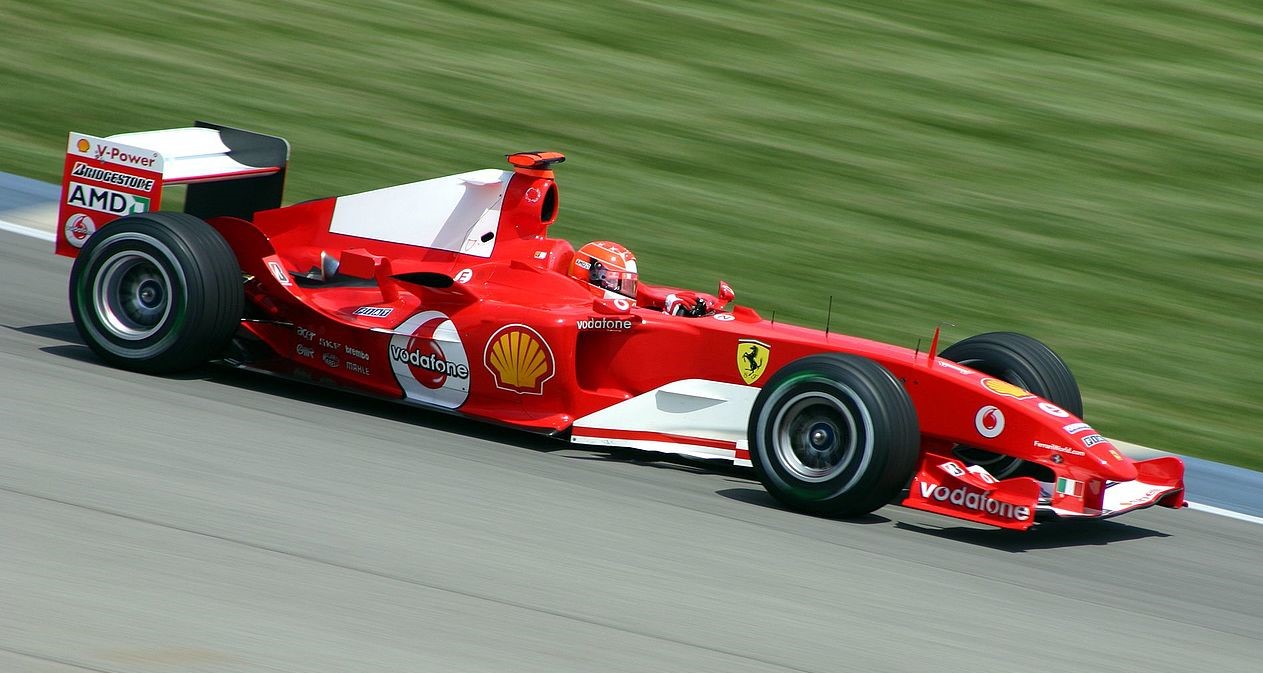 Ferrari F2004 (Photo: R.Dikeman)
Ferrari F2004 (Photo: R.Dikeman)
Mercedes 2012 -2019
Costa relocated to England where the Mercedes team was based and renewed his relationship with Ross Brawn and Michael Schumacher. Mercedes secured its first win in 57 years when Nico Rosberg won the 2012 Chinese GP. Schumacher's come-back finished at the end of 2012 and it was announced that Lewis Hamilton would be driving for the team. Costa led the design of the 2013 W04 car which won three Grand Prix and earned 2nd place in the Constructors Championship. Then as designer/engineering director, Mercedes won six Constructors and six Drivers Championships (5 for Hamilton, 1 for Rosberg) from 2014 to 2019. After many years working at the pinnacle of F1 Costa decided to spend more time with his family who had remained in Italy, so in 2020 he left Mercedes to join Dallara Automobili S.p.A as Chief Technical Officer. At Dallara, Costa's role would allow him to continue working across a breadth of racing and automotive projects, including F1 through their association with Haas.
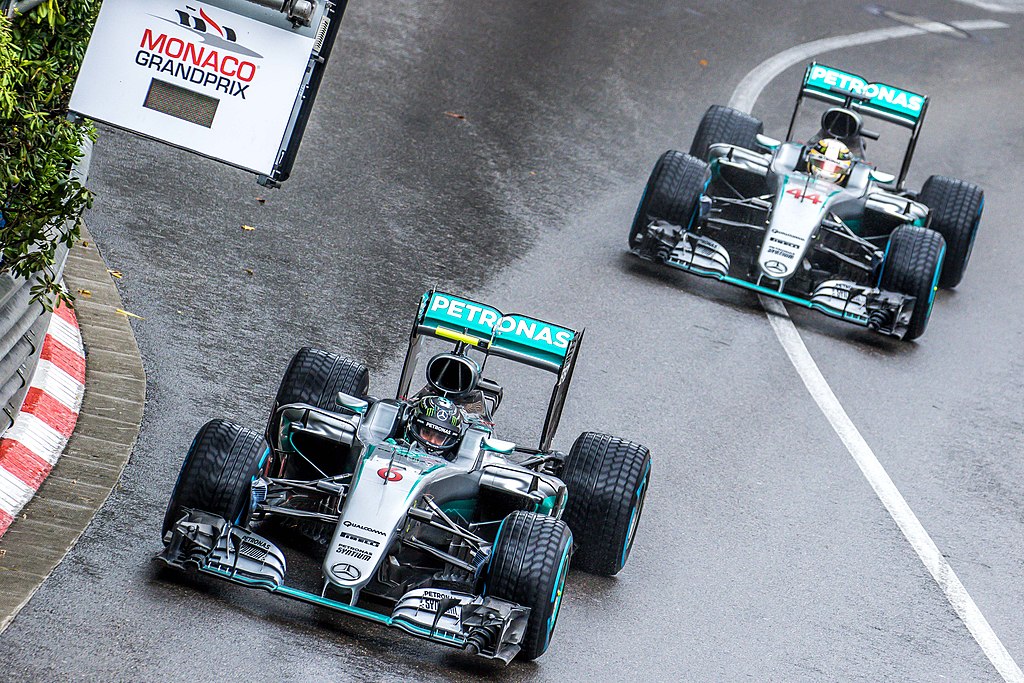 Mercedes W07, 2016 Monaco GP (Photo: A.Locking)
Mercedes W07, 2016 Monaco GP (Photo: A.Locking)
New Additions: March 2022
Hi and welcome to the March update. As in previous updates, I'll start with some Covid news and how it's affecting the model car scene in Sydney. Daily Covid infections in NSW are bouncing around the 5K to 10K mark so the State government has removed most restrictions, most notably the restrictions on crowd sizes for events and masks mandates for most indoor situations. Also, parents are allowed back onto school grounds so the Granville Model Fair (held in a school hall) could restart soon, but in my opinion more likely in April than March. The Collector Con fair at Cambridge Park, near Penrith is a definite starter on 27 March so please spread the word! See the Swap Meets link for details.
Ok, just a few additions to my stocklist this month and here are my picks for the month.
Over the years, there have been a number iconic motorsport liveries that have stayed firmly in our memories, for example who can forget the Gulf, Marlboro or JPS cars. One livery has flown a little under the radar but if I had my time again, I'd be happy to add "Jagermeister" cars to my collection. The distinctive orange with the unique gothic Jagermeister font and stag logo have adorned over a hundred cars since the company started their motorsport sponsorship back in 1972. The company has been involved in F1 and many German and European racing series with cars such as Porsche, BMW and Opel. Jagermeister ended their involvement in sports sponsorship in 2000; from the company's perspective, alcohol and sports do not mix, but the orange vehicles have become much sought-after collectors items. Scale model versions have also become collectors items and this BMW M1 from Spark is the latest model available.
Roger Penske dipped his toes into the F1 pond for 3 years between 1974 to 1976. The team's best year by far was 1976 with a single car for Ulsterman, John Watson. The year started with the Penske Ford PC3 being qualified inside the top ten and a best result of 5th at the South African GP. Watson was unable to score any more points until the PC3 was replaced by the PC4 mid-season. Then Watson scored one GP win, two third places and a sixth to finish 7th in the Drivers' Championship and Penske 5th in Manufacturers Cup. At the end of the year, Roger Penske in a shock announcement, said he was going to discontinue the F1 programme to concentrate his racing efforts on USAC and NASCAR competition. This model from Spark represents the PC3 that Watson raced to 7th place in the Belgian GP.
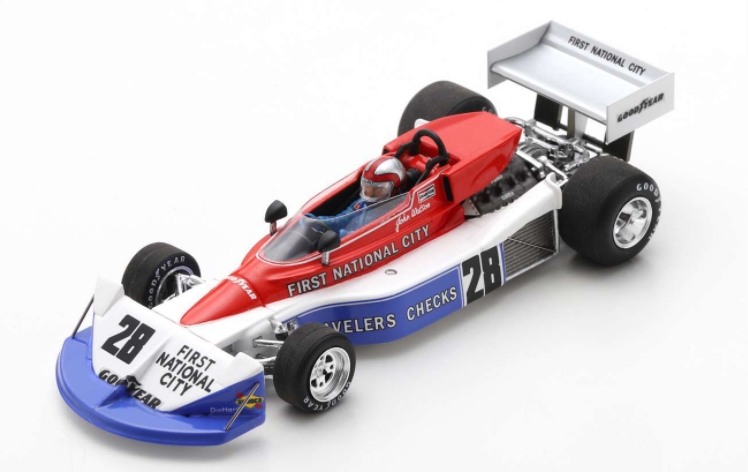 Spark: Penske Ford PC3 Belgian GP 1976
Spark: Penske Ford PC3 Belgian GP 1976
Well, that wraps it up for another month. With great pleasure I'd like to confirm the Collector Con Fair is going ahead on 27 March at the Penrith Valley Regional Sports Centre, 30 Herbert Street, Cambridge Park. The doors are open from 9:00am to 2:30pm and the show has a full capacity of stall holders, the organisers having to open the third hall to cater for the extra demand for tables. Please note, to attend this fair you need to pre-purchase your entry tickets via the Eventbrite website. Please go to the Eventbrite website and then search for Collector Con Penrith (sorry, the direct link doesn't seem to be working from my web page). Tickets cost $9.50 for an adult visitor arriving at 9:00am and $7.50 if arriving after 11:00am; children under 12 will be admitted free. Please spread the word to all your friends.
Collector Con have confirmed the dates for all their fairs for 2022; three fairs at Cambridge Park (Penrith) and two at Campbelltown. At this stage, I'm not planning to attend Campbelltown, please see the Swap Meets link for details. Also, the Hawkesbury Model and Hobby Show has been confirmed for the weekend of 17/18 September. I hope to see you all on 27 March, until then happy collecting.
Formula One
- 2021 Haas Ferrari VF-21, Mick Schumacher (47) Bahrain GP (Minichamps)
- 1995 Ligier Mugen Honda JS41, O.Panis (26) 4th Canadian GP (Spark)
- 1965 Lotus Climax 25, G.Russo "Geki" (28) Italian GP (Spark)
- 1968 Matra Ford MS7, J.Stewart (8) 1st F2 De Pau GP (Spark)
- 2020 Mercedes AMG W11, L.Hamilton (44) 1st British GP (Spark)
- 1976 Penske Ford PC3, J.Watson (28) Belgian GP (Spark)
- 2020 Racing Point Mercedes RP20, N.Hulkenburg (27) 70th Ann. British GP - 7th (Spark)
Le Mans / Rally
- 1982 BMW M1, K.Konig (33) DRM Norisring "Jagermeister" (Spark)
- 1973 Porsche 910, Touroul/Rouget (22) DNF Le Mans (Spark)
- 2020 Porsche 911 RSR, Campbell/Pera/Ried (77) 2nd LMGTE Le Mans (Spark)
- 1972 Datsun 240Z, Aaltonen/Todt (5) 3rd Monte Carlo Rally (Spark)
- 1964 Morris Cooper S, Hopkirk/Liddon (37) 1st Monte Carlo Rally (Spark)
American Racing Series
- 1960 Porsche 718 RS60, K.Miles (50) Riverside SCCA (Spark)
- 2020 Porsche 911 RSR, Campbell/Tandy/Makowiecki (911) 3rd GTLM 24h Daytona (Spark)
Misc. Scale
- 1983 Porsche 956, Andretti/Andretti/Alliot (21) 3rd Le Mans 1:64 (Spark)
- 1983 Porsche 956, Lassig/Plankenhorn/Wilson (18) 7th Le Mans 1:64 (Spark)
- 1986 Porsche 956, Follmer/Morton/Miller (8) 3rd Le Mans 1:64 (Spark)
After Thoughts: "The 50-Day Car." At the end of 1977, with 50 GP starts with four different teams, Jackie Oliver realised his driving career was over when his phone stopped ringing. With no more driving offers, Oliver decided to chart the course of the next stage of his career, as a team owner.
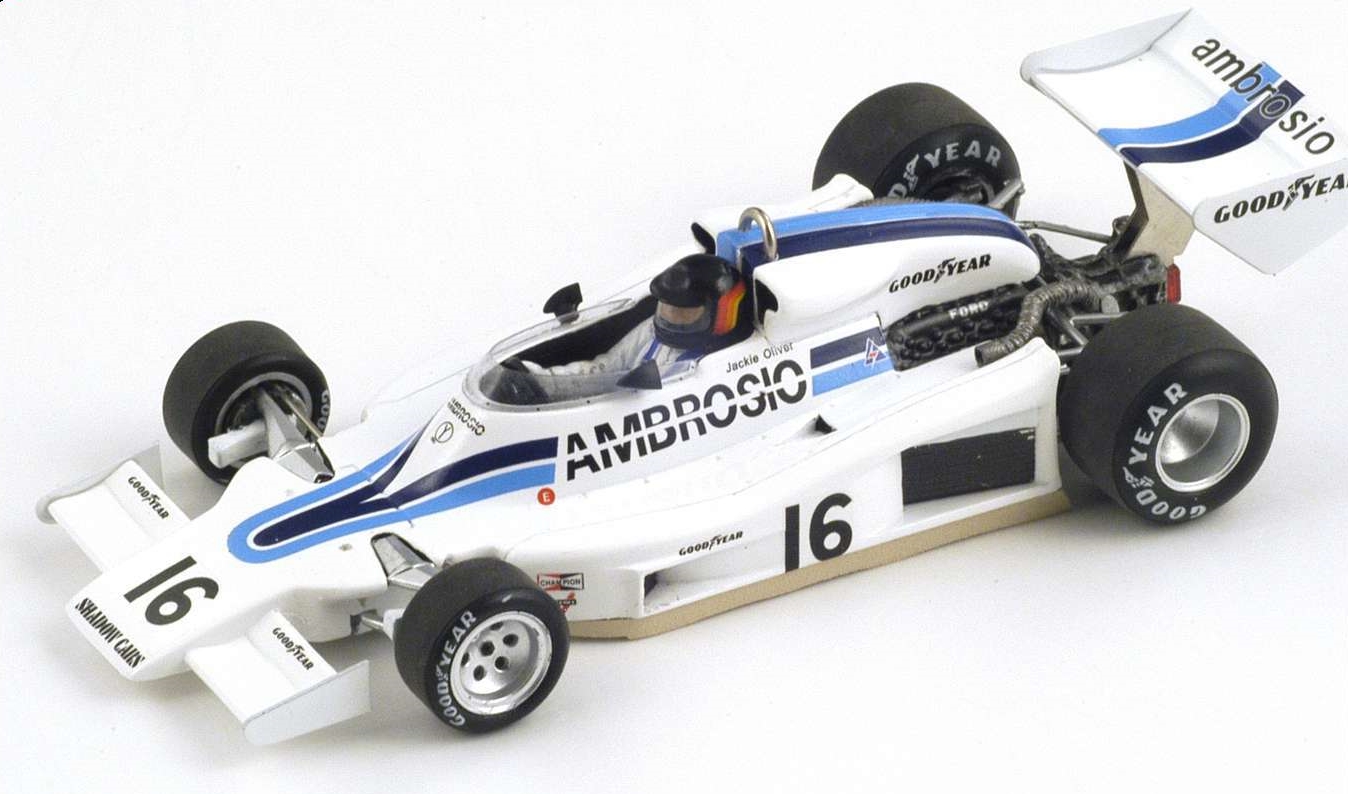 Spark: Shadow DN8 1977 Jackie Oliver
Spark: Shadow DN8 1977 Jackie Oliver
Back in 1973, the American Don Nichols entered F1 with his Shadow team, with Jackie Oliver as the team leader thanks to his association with Nichols' Can-Am programme. From 1974, Oliver became more involved in the management side of the Shadow F1 team, whose UK base was at Northampton while still driving in the Can-Am series and winning that championship in '74. From his close relationship with Nichols, Oliver knew Nichols was thinking about taking Shadow back to the US in 1978 so asked if he could buy the team. Oliver had the backing of Shadow's longstanding sponsor, Franco Ambrosio but Nichols declined the offer(1). Undeterred, Oliver and Alan Rees (Shadow team principal) held an offsite meeting of all Shadow personnel to outline their plans for a new team and virtually everyone agreed to join the team. The notable exception was designer, Tony Southgate who thought the venture was too risky. Oliver proceeded with his plans and purchased a factory in Milton Keynes. When Tony Southgate returned to the Shadow base a few weeks later, he was faced with an empty factory and promptly signed up with Oliver!
Jackie Olivier's new team was taking form and needed a name. He didn't want it to be called "Oliver F1" so it was suggested they create an anagram from the initials of the team directors surnames: Franco (A)mbrosio, Alan (R)ees, Jackie (O)liver, Dave (W)ass and Tony (S)outhgate and so Arrows Grand Prix International was born (with an extra R added). Southgate commenced the design of the first Arrows car in December 1977, the FA1, named in recognition of Franco Ambrosio, the team's main sponsor. When the FA1 was unveiled, it bore an uncanny resemblance to the Shadow DN9 ... because it was a DN9.
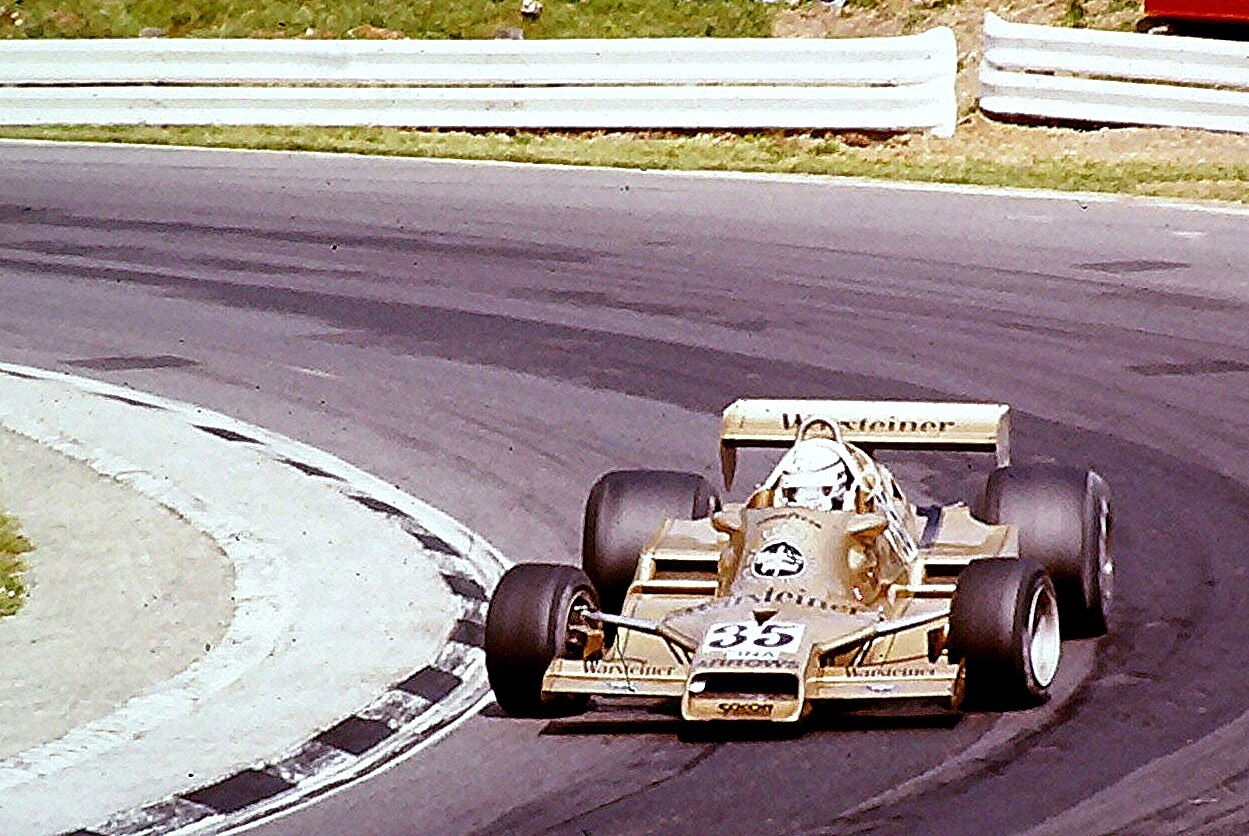 Arrows Ford FA1 1978 (Photo: Martin Lee)
Arrows Ford FA1 1978 (Photo: Martin Lee)
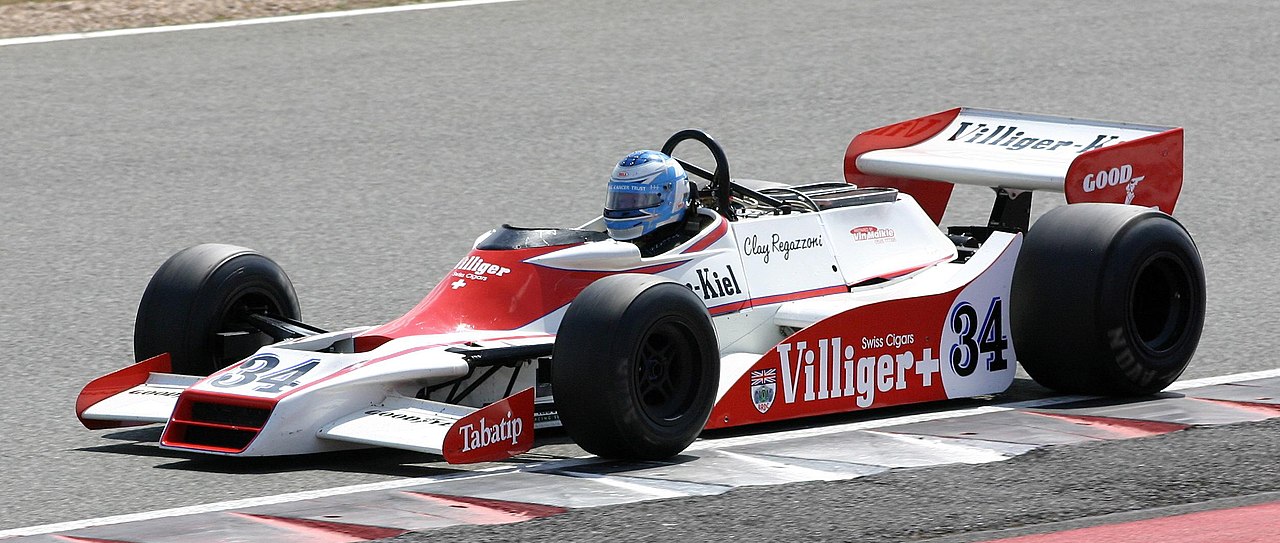 Shadow Ford DN9 1978 (Photo: John Grant)
Shadow Ford DN9 1978 (Photo: John Grant)
Southgate, just as he was leaving the Shadow design office had grabbed his drawings in the mistaken belief the drawings were his. An intellectual property lawyer soon dismissed his assertion stating the drawings belonged to the company that employed him, even though he was working as a contractor. An incensed Don Nichols took legal action and in early 1978, bailiffs searched the Arrows offices and found twelve Shadow drawings behind Tony Southgate's desk. The Arrows FA1 was allowed to race pending legal proceedings and competed in the first half of the season but Arrows knew they would lose in court. Oliver asked his copyright lawyer how long could the court case be held up, the lawyer said maybe 50 days. So Arrows had 50 days to design and build a new car; in fact it took 52 days.
The High Court in London unsurprisingly ruled the FA1 was a direct copy of the Shadow DN9 and banned the FA1 from racing. The day after the ruling, Arrows unveiled the A1, dropping the "FA" designation. By this time Franco Ambrosio had left the team when he was jailed in Italy for financial irrregularities and Warsteiner became the main sponsor. The A1 was ready for the Dutch GP so Arrows did not miss a race and amazingly, the 50-day car was a good car from the get-go.
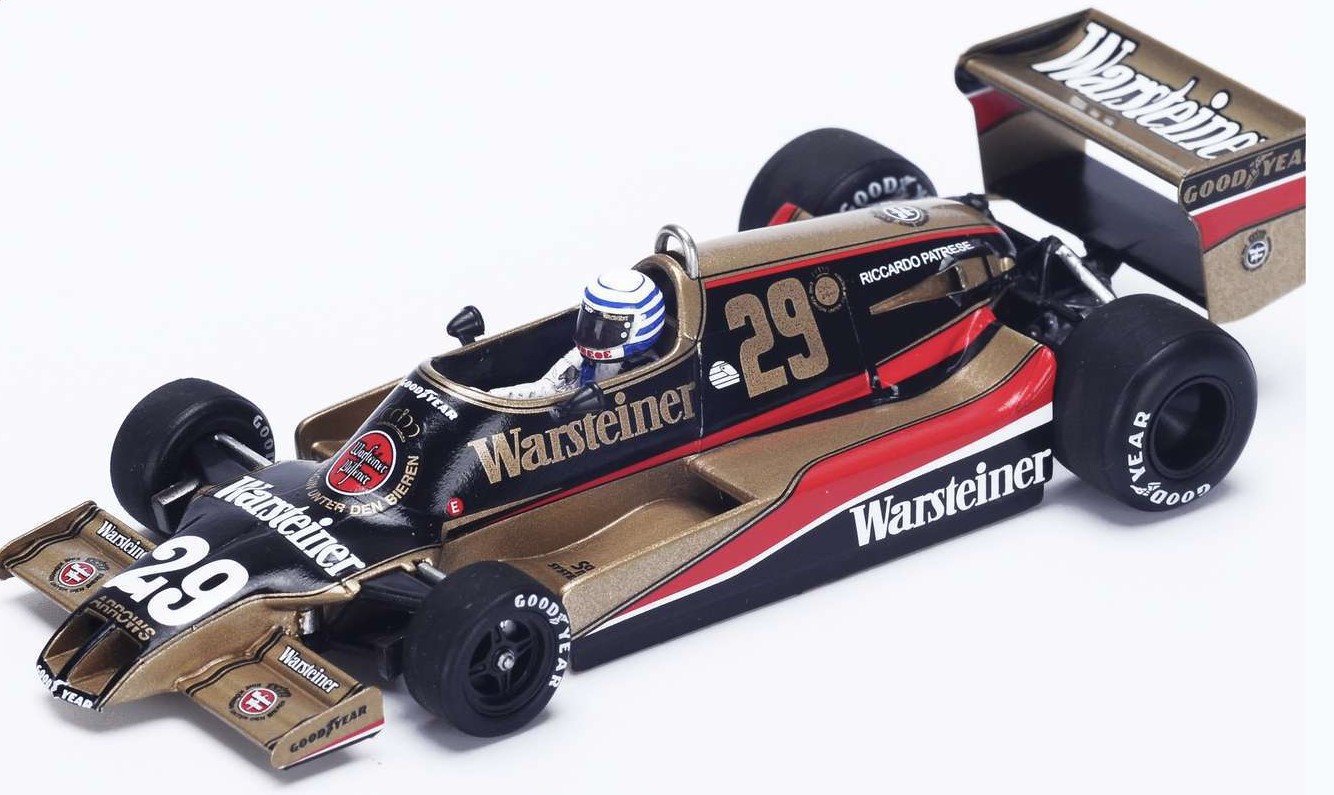 Spark: Arrows Ford A1 1978 Patrese
Spark: Arrows Ford A1 1978 Patrese
Notes (1): Nichols did not take Shadow back to the US but the team's fortune declined from 1978, due in part to the loss of key personnel, until the team was absorbed into the Theodore Racing operation in 1980.
Congratulations to Scott McLaughlin on his maiden Indy Car win on the streets of St. Petersburg on 27 February.
New Additions: February 2022
Hi everyone and welcome to the February update. Firstly, some Covid news; it is now two years since the first case of the virus was detected in NSW and the state has recorded just over 1 million cases since then. We are now seeing around 15,000 to 20,000 infections daily which is down from 30,000 to 40,000 just a few days ago, so some experts are predicting we are over the "peak" of Omicron infections. Even so, restrictions will remain until the end of February. To date, no update on the monthly model fair at Granville so I would assume this won't be resuming this month, especially with the strict precautions pertaining to restarting the new school term (since the model fair is held in a school assembly hall).
At the moment, local supply chains are under severe pressure due to workers needing to isolate which compounds the already long shipping times for imported goods. I'm still waiting for a parcel I ordered in October 2021! Nevertheless, I did receive some new models last month and here are the highlights ...
Aussie, Oscar Piastri did everything he could to get into F1 but still fell short. Making his single-seater debut in 2016, Piastri raced in selected rounds of the Formula 4 UAE Championship before signing up full-time for the 2017 British F4 championship and finishing second overall. Piastri then contested the Formula Renault Eurocup in 2018 and 2019, winning the championship in 2019. For 2020, Oscar joined the reigning FIA Formula 3 championship team, Prema Racing and clinched the championship at the last race. When Mick Schumacher left the Prema Racing Formula 2 team at the end of 2020, Piastri took over the vacant seat and history will record the young Australian became the FIA F2 champion in 2021. Piastri was then rumoured to graduate to F1 in 2022, filling the vacant seat at Alfa Romeo but in reality, he was never in with a chance; in F1 it's not just about talent (e.g. winning three feeder championships in a row), it's also about money, lots of money which Piastri did not have. As one motorsport writer put quite succinctly, Piastri "was bringing coins to a cash fight". Instead, for 2022 Piastri who joined the Renault Sport Academy in 2020 will be the Alpine F1 team reserve driver but will be kept busy with a big testing programme including some free practice sessions at some grand prix races. Piastri's F3 Dallara has been produced by IXO.
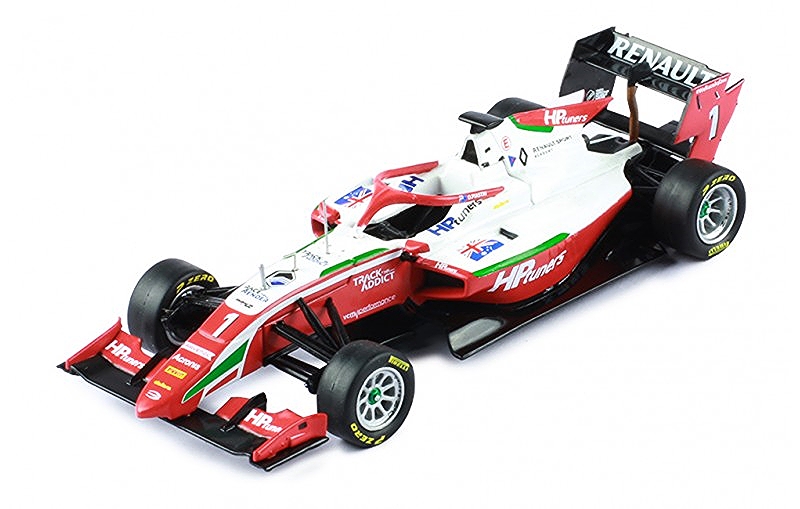 IXO: Dallara Mecachrome F3, 2020 O.Piastri
IXO: Dallara Mecachrome F3, 2020 O.Piastri
In 1975, Fritz B. Busch a 52-year old motoring journalist, decided to demonstrate the capabilities of diesel power by attempting a speed record attempt. In his workshop in his castle in Wolfegg, Germany, Busch worked on his car which used a Formula 2 chassis and a body shell made of 25 square metres of sheet aluminium held together with 3000 rivets. The wedge-shaped bodywork was drawn over the sides to eliminate any destabilising lift at high speed. Mercedes-Benz supported the project. providing a five-cylinder turbodiesel that was mounted as a mid-engine. To improve the performance of the standard 79 hp engine, a more powerful BOSCH fuel injection pump was installed and the engine displacement was adjusted to exactly 3 litres according to the regulations. After all the tuning measures, the engine now had a performance of 187 hp. Busch named his creation "Dieselstar". On November 16, 1975 Busch took his car to the test track of Volkswagen and accelerated from 0 to 100kph in 5.6 seconds, then reaching a top speed of 253.7kph. This top speed meant the car set a record of 136.1kph from a standing start over a distance of 1 kilometre, a significant increase over the previous record of 113.4kph. It is particularly noteworthy that previous records were set in straight driving on smooth salt flats whereas the Volkswagen track was curved, so Busch had to steer and brake around a closed course. The Dieselstar has been faithfully recreated by Autocult in 1:43.
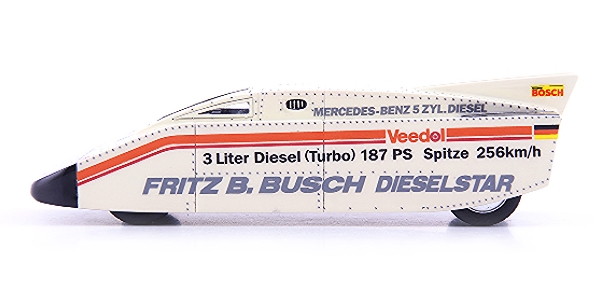 Autocult: Fritz B. Busch Dieselstar
Autocult: Fritz B. Busch Dieselstar
Do you need to jazz up your model car display? Tired of endless rows of cars in your glass cabinet? Here is something that will draw your attention to a particular model - a car trailer. Schuco have a double axle trailer in 1:43 and IXO have one in 1:18. Both are great for elevating your favourite model above the rest and are reasonably priced.
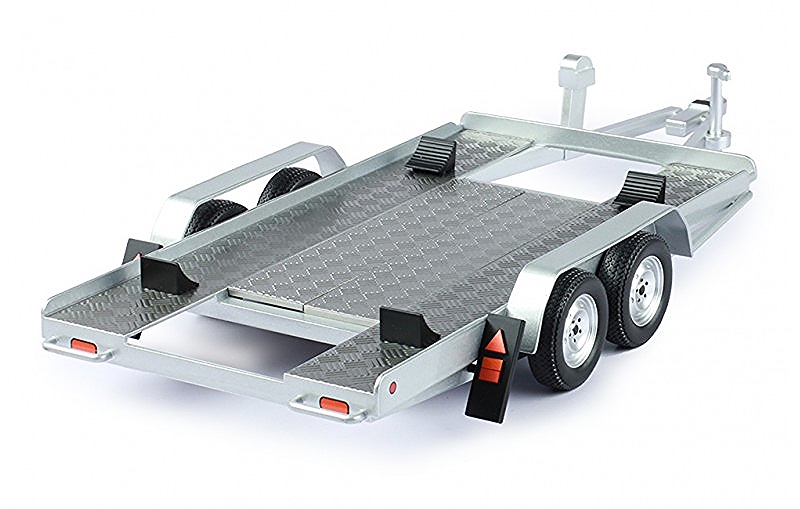 IXO: 1:18 Double axle car trailer in silver
IXO: 1:18 Double axle car trailer in silver
Surprisingly, the very first automobiles (circa 1880's) did not use steering wheels to control the direction of the vehicle, instead they used a tiller arm. It wasn't until 1894 when French engineer Alfred Vacheron was looking for an advantage in that year's Paris to Rouen race that he installed a steering wheel on his Panhard et Levassor, figuring that it would provide more precise control. He didn't win the race, finishing 11th but the steering wheel was here to stay. Being such an integral part of automobiles today, it was only natural for scale models of these devices to be made. Z Models (the sister brand of GT Spirit and OttOmobile) have their focus on diecast metal scale models but they have recently release a 1:2 scale model of the 2019 Renault R.S.19 steering wheel used by Ricciardo and Hulkenburg. This wheel will definitely go well next to your model of the Renault R.S.19 F1 car.
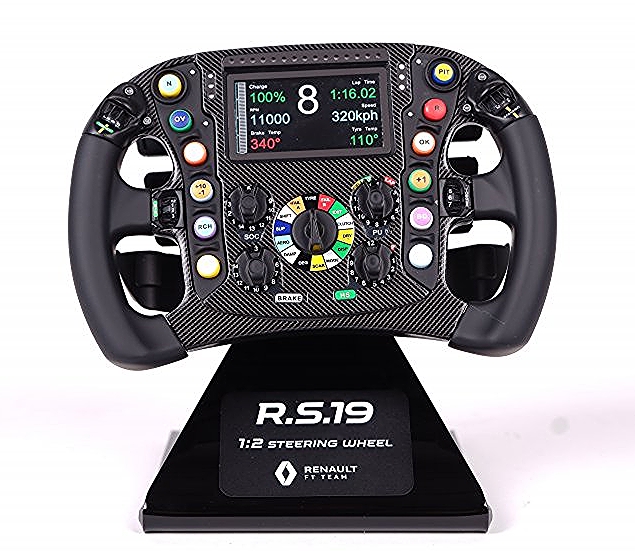 Z Model: 2019 Renault R.S.19 Steering Wheel 1:2
Z Model: 2019 Renault R.S.19 Steering Wheel 1:2
That's it for another joyless month. I know I'm sounding like a broken record but there are no model car fairs for February. Check the "Swap Meets" link for any updates, also please check out my stocklists and if there's anything of interest, I'd be happy to give you a shipping price nationally and internationally. Lastly, I wish everyone a happy and prosperous Lunar New Year and until next month, happy collecting.
Formula One / Formula Three / Race Transporter
- 1988 Ferrari F1-87/88C, G.Berger (28) race car (GP Replicas)
- 1988 Ferrari F1-87/88C, M.Alboreto (27) Race car (GP Replicas)
- 1971 Mercedes-Benz O 317, Porsche Martini Race Transporter Silver
- 2020 Dallara Mecachrome G319, O.Piastri (1) Barcelona GP F3 Champion (IXO)
Formula E
- 2019/20 Porsche 99X, A.Lotterer (36) Santiago ePrix Formula E 2019/20 (Minichamps)
Le Mans / GT Racing / Safety Cars
- 1937 Bugatti Type 57G, Wimille/Benoist (2) Le Mans winner (Edicola/Spark)
- 2017 Mercedes AMG GT3, GT Race car, plain body version in white (Minichamps)
- 2020 Mercedes AMG GT-R F1 safety car - red (IXO)
- 2020 Mercedes AMG GT-R F1 safety car - silver (IXO)
- 1984 Porsche 956K, Bellof/Bell (2) 1st Sandown 1000km "Rothmans" (CMR)
- 2018 Porsche 911 (991) GT3 R, GT Race car, plain body version in white (Minichamps)
Speed Record
- 1975 Fritz B. Busch Mercedes Dieselstar Record Car (Autocult)
Road Cars
- Car Trailer, double axle in silver (Schuco)
- 1967 Chevrolet Impala Sport Sedan in blue (PremiumX)
- 1970 Chevrolet Chevelle SS in green/white (PremiumX)
- 1957 Jaguar XK SS in silver (PremiumX)
- 1965 Shelby GT350 in black with gold stripes (IXO)
1:18 Scale
- Photographer '60s Race Day #2 (American Diorama)
- Photographer '60s Race Day #3 (American Diorama)
- Car Meet Guy series 2 figure #6 (American Diorama)
- Car Trailer, double axle in silver (IXO)
Misc
- 2019 Renault R.S.19 Steering wheel (Hulkenberg/Ricciardo) 1:2 (Z Models)
After Thoughts: "The 65th Anniversary of an American Icon." Probably the most iconic vehicles in American automotive history would be the 1957 Chevrolet ('57 Chevy) models by General Motors. Today, after 65 years since its release the Chevrolet models are still much sought after by car collectors and classic car enthusiasts from all over the world. Over the years it has become an enduring pop culture icon. The 1957 models were first introduced in to the public in October 1956 and was available in three series models: the upscale Bel Air, the mid-range Two-Ten and the One-Fifty. Of the series, the Bel Air series is by far the most desirable models for collectors.
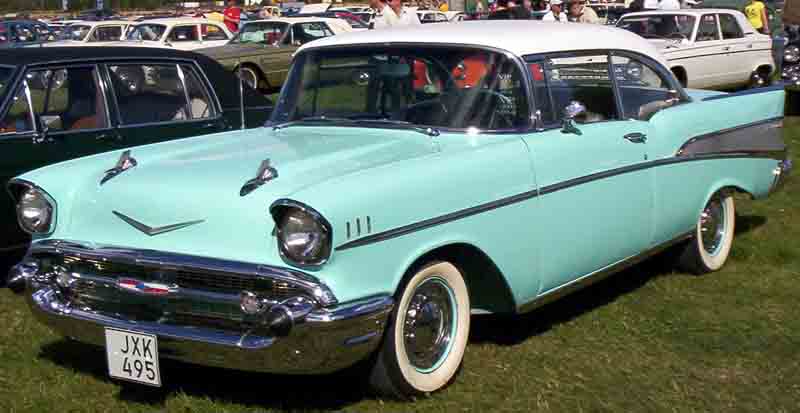 1957 Chevrolet Sport Coupe (photo: L-G Lingren)
1957 Chevrolet Sport Coupe (photo: L-G Lingren)
The '57 Chevy was basically a carry-over from the successful 1955 and 1956 models but minor changes included a wide chromed grille, rear tail-fins and a new dashboard. Surprisingly, when it came to "coolness" the Chevy couldn't really compete with the '57 Plymouth Fury which had much better styling and bigger tail-fins. But it was the Chevy that became an enduring icon, not the Plymouth and definitely not the '57 Ford which actually outsold Chevrolet in 1957.
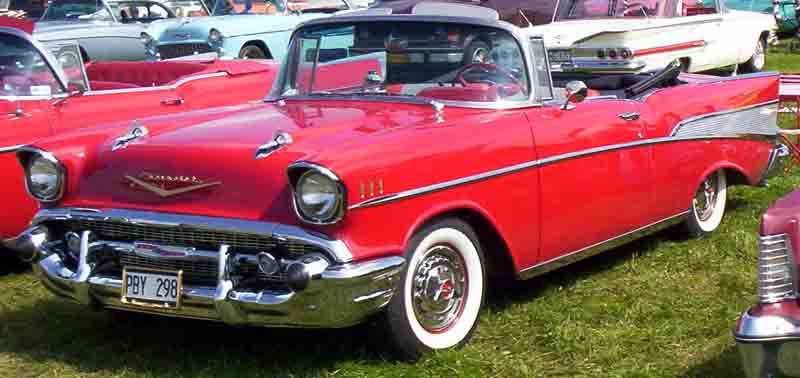 '57 Chevrolet Bel Air Convertible (photo:L-G Lingren)
'57 Chevrolet Bel Air Convertible (photo:L-G Lingren)
So why has the '57 Chevy become an American icon? Its status is credited to a combination of reasons. The '57 Bel Air showcases all the major 1950's styling cues without being outlandish; the chrome conical-shaped bumper guards, headlamps below heavy eyebrows, distinctive hood ornaments, swoopy stainless-steel side mouldings, anodized-aluminium quarter-panel trim with a hint of fins. It was one of those rare automobiles that was almost perfectly proportioned; it just looked good from any angle. A number of engine options were offered but the 283-cu.in V8 with Ramjet fuel injection turned the '57 Chevy into a 250 horsepower "street machine". The Turboglide transmission option first offered by Chevrolet in 1957 made for smoother shifting for the driver. The '57 Chevys were good cars mechanically, taking abuse fairly well and when they did break, they were cheaper to repair, upgrade and customise than their contemporaries. Thus, a higher percentage (of the 700,000 built(1)) survived to become collector cars. Finally, drag racers loved the '57, as its engine bay was large enough to accommodate some of the larger big block engines that were later available.
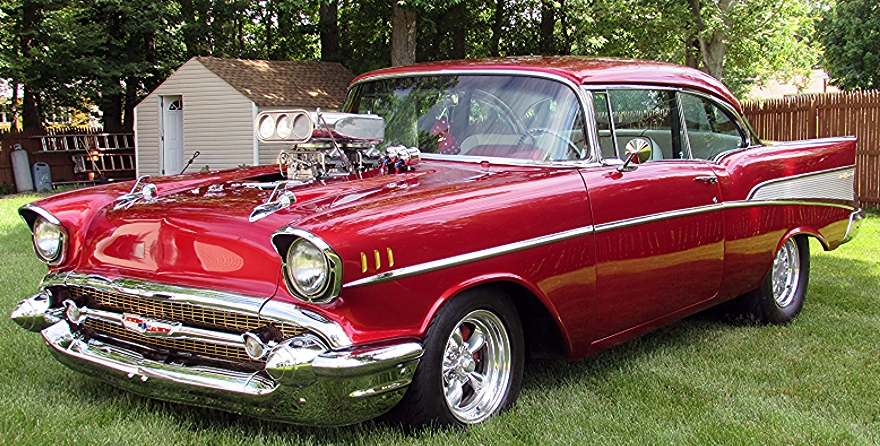 Customised '57 Chevy (photo: Mecum Auctions)
Customised '57 Chevy (photo: Mecum Auctions)
As its popularity increased so too did the demand for reproduction parts and today, there are many aftermarket companies specialising in exterior shells, motors and anything you could want or need to rebuild a '57 chevy from the chassis up. It's probably safe to say the '57 Chevy will not be losing it's icon status with collectors anytime soon.
Notes: (1) Built in 1957. A total of 1.5 million were built between 1955-57.
New Additions: January 2022
Hi everyone, happy new year to you all and welcome to the first update for 2022. I hope everyone had a safe and happy festive season with lots of model cars under the tree. This Covid virus is really intelligent, it seems to know just when to mutate to cause maximum pain and disruption. The daily COVID infections in NSW is now around a staggering 22,500 (up from 250 before Omicron) and we're now being urged to get our third booster shot. Our State Health Minister has given up and has told us we are all going to get Covid at some time so don't worry! However, I don't accept the notion that we will all get Covid, we just have to take sensible precautions. Now back to model cars ...
International shipping is still taking forever, not helped by the Christmas rush but I did get a couple of parcels late in December. I haven't been able to unpack and list all the models yet but here are some highlights ...
This month seems to be a bit of a GT40 festival with seven different models available. Several are restocked Le Mans winners from IXO but Spark have released five new versions. 1964 hadn't been kind to the new Ford GT40's, with seven cars available for the racing season, none finished a race let alone finish first. Leo Beebe, the head of Ford's Special Vehicles Department famously said to his engineers, "I don't know anything about racing, but there is one thing that has become increasingly apparent ... you don't either!" Things had to change. Caroll Shelby was given operational control of the race cars and John Wyer relegated to building the 100 cars that were intended for sale to private customers. The design and development work on the GT40 had been done by John Wyer's Ford Advanced Vehicles in the UK but was moved back to the US in 1965, straining the relationship between Wyer and Shelby. At the 1965 Le Mans race, the Ford entry was big, two Shelby GT40s with massive 7-litre engines and four customer entries running smaller engines (4.7 and 5.3-litres). The Shelby GT40s showed promise, taking pole for the race. One of the customer entry was the Ford Advanced Vehicle entry driven by John Whitmore and Innes Ireland (car #14), but after five hours, the car retired with engine failure. 1965 was again a dismal year for the GT40 with none finishing Le Mans; 1966 couldn't come soon enough.
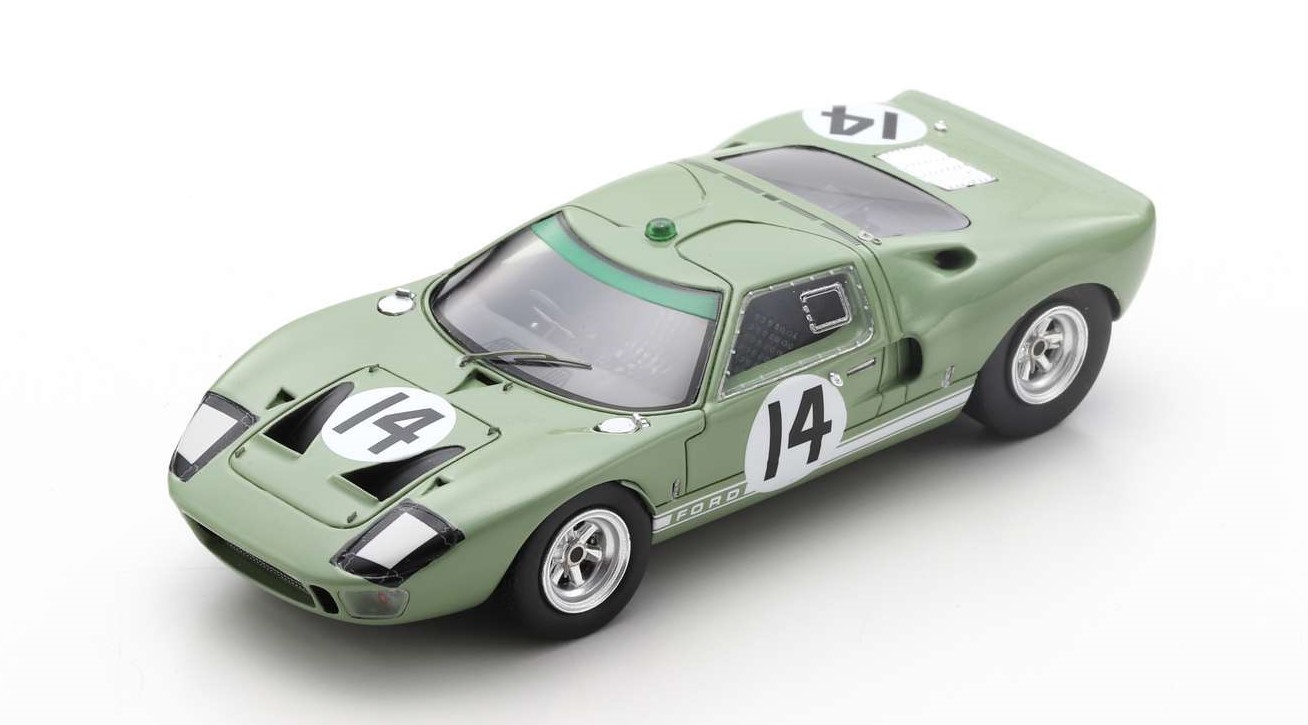 Spark: Ford GT40 #14 Le Mans 1965
Spark: Ford GT40 #14 Le Mans 1965
If "looks" alone is enough to win races, then the Chevrolet Monza would surely be on the top step of the podium. At the 1978 Le Mans race, American Brad Fisselle entered a Chev Monza competing in the IMSA GTX class; with its 5.7-litre engine, it was the largest in the race. The Chev's rivals in its class included the Porsche 935 and 911, and the Ferrari 365 and 512. Alas, after 5 hours the Monza was retired with engine failure.
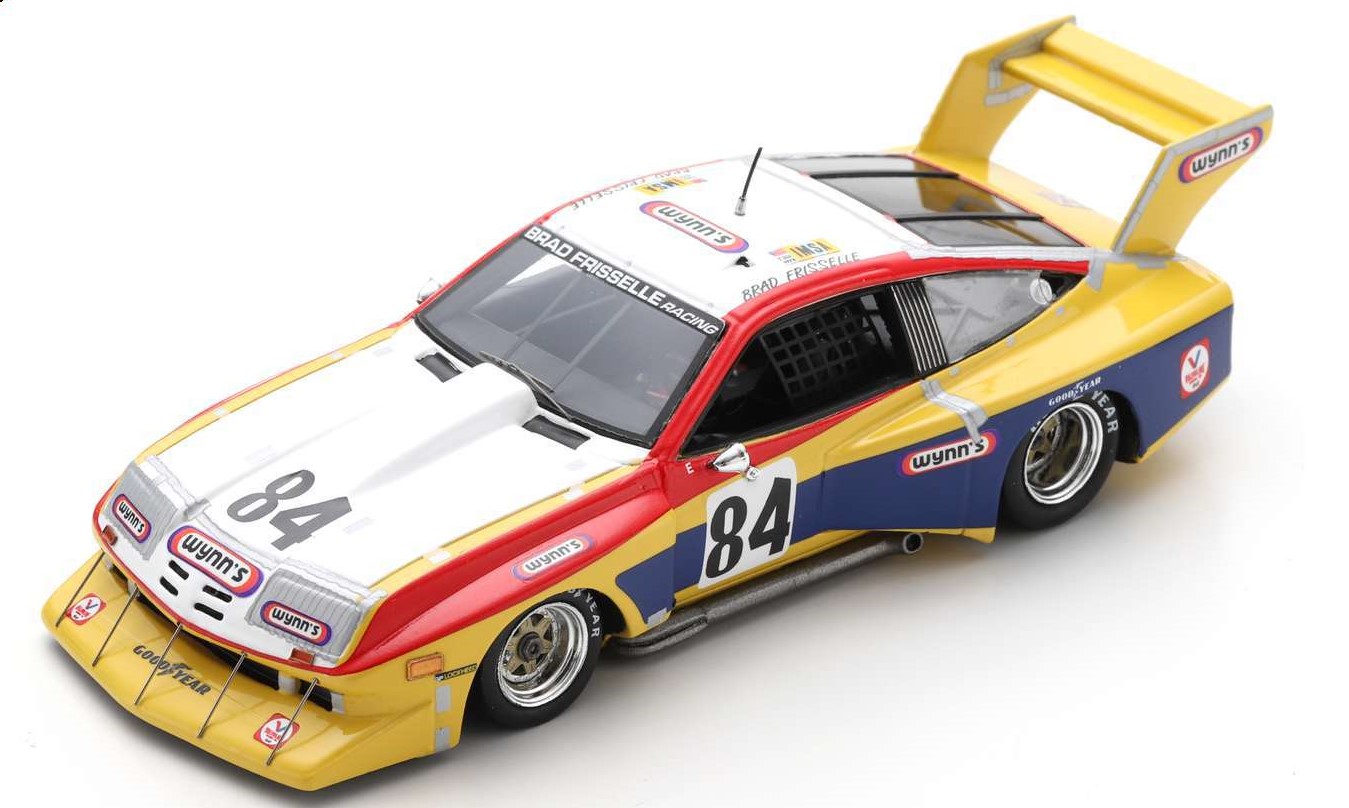 Spark: Chevrolet Monza 1978 Le Mans
Spark: Chevrolet Monza 1978 Le Mans
I know a lot of collectors like to enhance their model displays with garage accessories and the latest offerings from IXO may just be what you need. IXO has released three different 4-wheel sets in 1:18 and they each come with a stand, typically found in garages or specialist wheel retailers. The offerings from IXO are MiniLite, OZ Racing and Alpina (I only have the first two in stock).
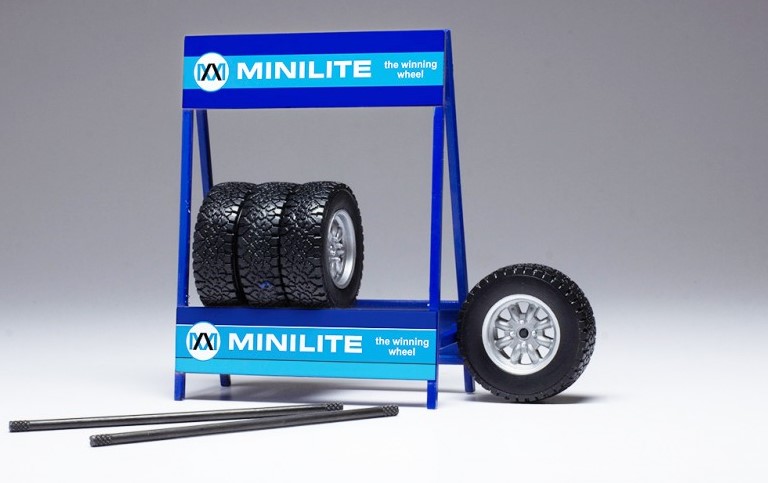 IXO 1:18 MiniLite Wheel set and stand
IXO 1:18 MiniLite Wheel set and stand
OK, that's it for another month and the start of another year. I wish everyone a safe 2022 and I really hope we can restart the model swap meets and hobby fairs this year. At the time of publication of this update, only the Collector Con Fair on 27 March at Cambridge Park has been confirmed. The Granville swap meet in January has definitely been cancelled. Please check the Swap Meets link for confirmed shows, hopefully, I can announce more dates in the February update, until then, happy collecting.
Formula One
- 1991 Lotus Judd 102B, J.Herbert (12) Australian GP (Spark)
- 1974 Shadow Ford DN3, B.Roos (16) Swedish GP (Spark)
Le Mans
- 2004 Audi R8, Ara/Capello/Kristensen (5) 1st Le Mans (IXO)
- 1978 Chevrolet Monza, Frisselle/Kirby/Hotchkis (84) Le Mans (Spark)
- 1976 Datsun 260Z, Buchet/Favresse/Haller (73) Le Mans (Spark)
- 1965 Ford GT40, Whitmore/Ireland (14) Le Mans (Spark)
- 1966 Ford GT40, Scott/Revson (59) Le Mans (Spark)
- 1967 Ford GT40 Mk IV, D.Gurney/AJ.Foyt (1) Le Mans winner (IXO)
- 1969 Ford GT40 Mk I, J.Ickx/J.Oliver (6) "Gulf" LM winner (IXO)
- 1951 Jaguar XK120C, P.Whitehead/P.Walker (20) Le Mans winner (IXO)
- 1990 Jaguar XJR12, Brundle/Nielsen/Cobb (3) Le Mans winner (IXO)
- 1992 Peugeot 905, Warwick/Dalmas/Blundell (1) winner Le Mans (IXO)
- 1993 Peugeot 905 Evo 1, G.Brabham/Bouchut/Helary (3) Le Mans Winner (IXO)
- 1970 Porsche 908/03, Waldegaad/Attwood (36) 5th Targa Florio (Spark)
Australian Race Series
- 1988 Ford Sierra RS500, Longhurst/Mezera (25) 1st Bathurst 1000 (ApexReplicas)
- 2017 Commodore VF, Reynolds/Youlden (9) 1st Bathurst 1000 (Authentic)
- 2017 Commodore VF, Reynolds/Youlden (9) 1st Bathurst 1000 1:64 (Authentic)
- 1972 Torana LJ GTR XU-1, P.Brock (28C) 1st Bathurst 1000 1:64 (Biante Minicars)
- 1975 Torana LH SL/R5000 L34, P.Brock/B.Sampson (5) 1st Bathurst 1:64 (Biante Minicars)
- 1976 Torana LH SL/R5000 L34, Brock/Brock (5) Bathurst "Bill Paterson" 1:64 (Biante Minicars)
American Race Series
- 1962 Austin Healey Sprite Sebring, Colgate/McQueen (72) Sebring 12hr (Spark)
- 1966 Ford GT40 AMR2, Hill/Stewart (24) Sebring 12hr (Spark)
- 1966 Ford GT40 AMR2, Whitmore/Gardner (25) Sebring 12hr (Spark)
- 1967 Ford GT40, Ickx/Thompson (11) Class winner Daytona 24h (Spark)
Road Cars
- 1969 Chevrolet Camaro SS in red (PremiumX)
- 1965 Triumph Spitfire 4 Mk2 in light blue (Spark)
Misc. Scales (1:64)
- 1969 Holden Monaro HT GTS 350 in Verado Green (Biante Minicars)
- 1969 Holden Monaro HT GTS 350 in Monaco Maroon (Biante Minicars)
- 1969 Holden Monaro HT GTS 350 in Monza Blue (Biante Minicars)
- 1969 Holden Monaro HT GTS 350 in Sebring Orange (Biante Minicars)
1:18 Scale
- Set of 4 Wheels - Mini Lite with stand (IXO)
- Set of 4 Wheels - OZ Superturismo with stand (IXO)
After Thoughts: "The 2022 F1 Debutants." What an end to the the 2021 F1 championship! Whatever your opinion of the last race, Max Verstappen has to be congratulated for winning the title against all odds. Also, I'm pleased that Max will carry the number "1" on his car this year; call me an old-school traditionalist but I think all reigning champions should wear the number 1 proudly instead of retaining their racing number for commercial reasons (yeah, I'm looking at you Valentino). Along with a new season, comes some debutants to the championship - a new driver and a new circuit.
Seven of the ten teams have retained their '21 line up and two drivers will be missing from the grid this year, Kimi Raikkonen (retirement) and Antonio Giovinazzi (out of contract). Giovinazzi, however will be the reserve driver for Ferrari, Alfa Romeo AND Haas as part of his contract with Ferrari, so may make appearance this year. Valteri Bottas moves from Mercedes to Alfa Romeo, George Russell from Williams to Mercedes. Alex Albon will return to join Williams and the final seat at Alfa Romeo will be filled by debutant Zhou Guanyu, becoming China's first full-time F1 driver(1). Zhou, like most F1 drivers started in karts where he won several championships in Europe. In 2015 Zhou competed in the Italian Formula 4 Championship, finishing second and he then moved to the European F3 Championship in 2016. Zhou spent three years in F3 before graduating to F2 in 2019. His three years in F2 netted him a 7th, 6th and 3rd place in the championship. In 2019, Zhou joined the Renault Sport Academy and served as a development driver for the Renault F1 team. Zhou made his F1 race weekend debut for Alpine F1 during the first practice session at the 2021 Austrian GP. I wish him well.
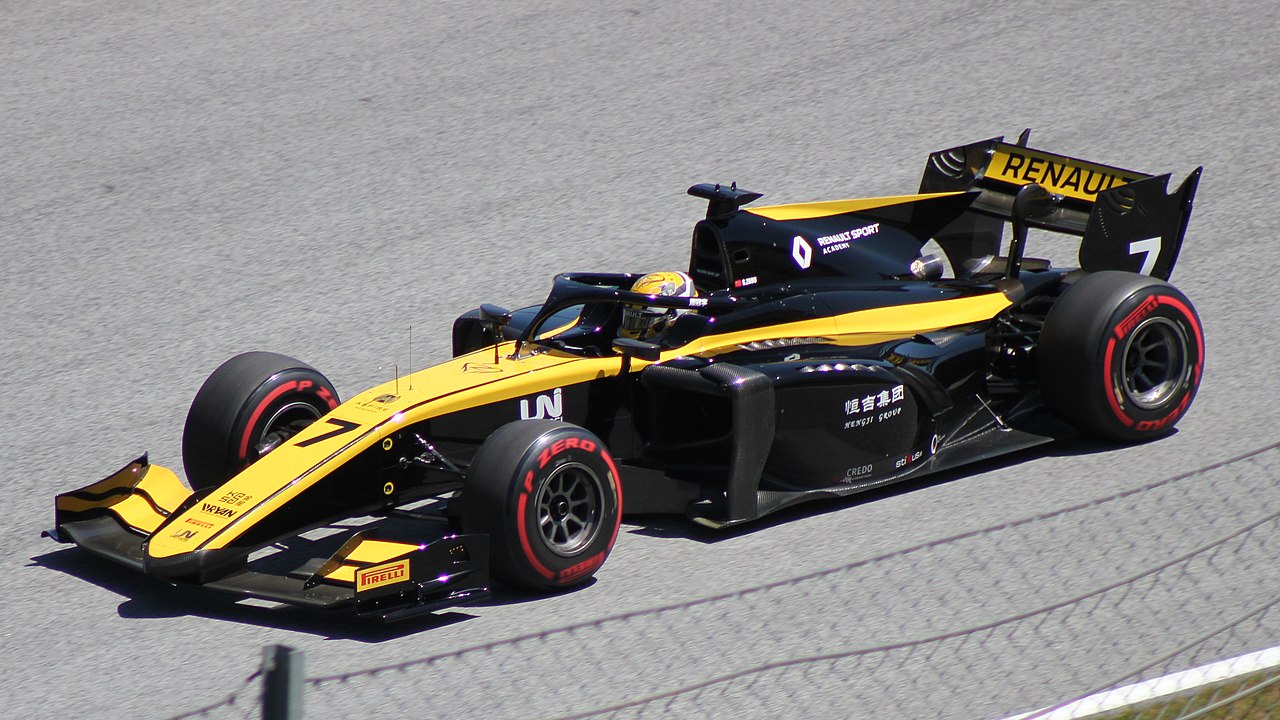 Zhou's F2 Dallara Austria 2019 (Photo: Lukas Raich)
Zhou's F2 Dallara Austria 2019 (Photo: Lukas Raich)
The 2022 calendar consists of a record 23 races starting at Bahrain on 20 March and finishing at Abu Dhabi on 20 November. The calendar includes one new GP at Miami, USA on 8 May. Miami, famed for its sandy beaches, art deco vibe, vibrant multiculturalism and rich sporting heritage is set to become the USA's 11th F1 venue. Way back in 2017, circuit layouts were being developed in Downtown Miami but in 2019 the focus was switched to a site a few miles north around the Hard Rock Stadium, the home of the Miami Dolphins football team. The circuit designers (Apex Circuit Design) simulated 36 different layouts before deciding on the current iteration, a 19-turn track that has the Hard Rock Stadium at its heart and it's estimated the average speed will be around 223 kph (138 mph) with a top speed of 320 kph (198 mph). The 5.41 km track will be a temporary street circuit, very similiar to Albert Park in Melbourne.
Miami GP Circuit Layout (Author: GabrielStella)
Notes
(1) Ma Qinghua was an HRT F1 test driver in 2012 and took part in four Friday GP practice sessions. In 2013, Ma moved to Cateham to continue his role of Friday test driver.
